Click here to see more results

FOR YOU, FOR FREE: 17 years' worth of firsthand Costa Rica trip planning and travel advice compiled into hundreds of articles, plus exclusive discounts. Created by a Costa Rican and a four-time published Costa Rica guidebook author. Welcome, amigos, and as we say in Costa Rica, pura vida!

Our 2023 Moon Costa Rica guidebook (third edition)
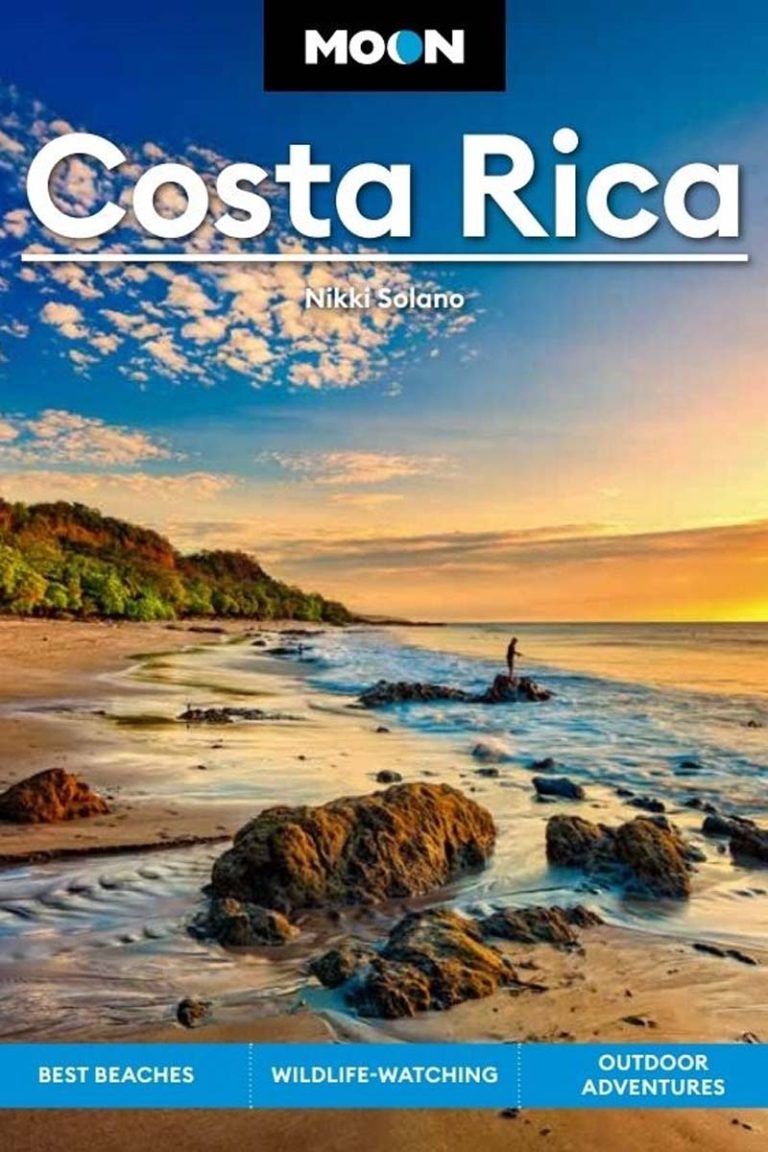
Our 2022 Moon Best of Costa Rica guidebook (first edition)
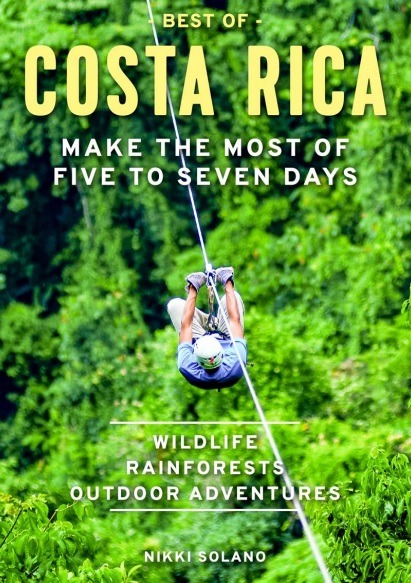
Our 2021 Moon Costa Rica guidebook (second edition)

Our 2019 Moon Costa Rica guidebook (first edition)
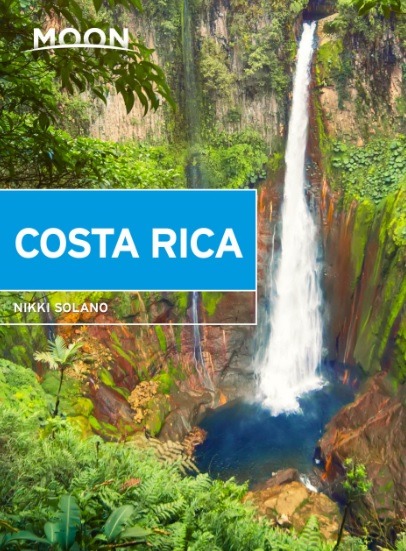
- Moon Travel Guides
- FREE DIY COSTA RICA ACCESS! Details here.
Our company is inclusive. Read our Anti-Hate, Anti-Racism, Anti-Xenophobia, Anti-Inequality, Anti-Discrimination Statement here.
NEW! Our awesome Costa Rica Destination Tool filters 66 destinations by nearly 150 criteria to help you quickly and easily decide where to go in Costa Rica according to your unique preferences, wants, and needs. Learn more and access the tool on our sister site, DIY Costa Rica, here.
How, When, And Where To See Sloths In Costa Rica (15+ Spots)
Home » What To Do In Costa Rica » Wildlife Spotting, Gardens, and Exhibits » How, When, And Where To See Sloths In Costa Rica (15+ Spots)
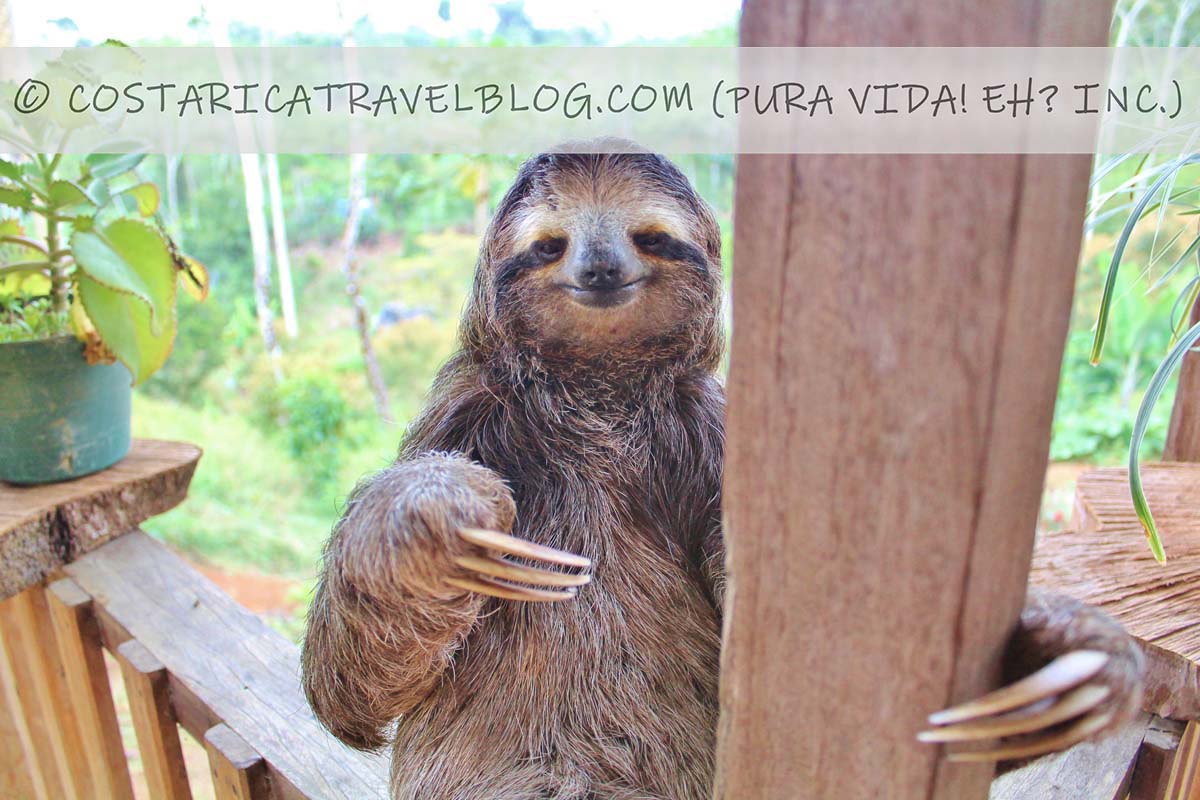
Last updated on April 4th, 2024 at 09:02 am GMT-6 (Costa Rica time)

Written by Nikki Solano
WANT TO SAVE MONEY IN COSTA RICA?
Our sister site, pura vida eh inc., has discounts for costa rica tours and activities . con mucho gusto (you’re welcome) and pura vida.

Get the Costa Rica info you need by browsing our article's TABLE OF CONTENTS:
Want to see a sloth? Come to Costa Rica!
Where to see sloths around la fortuna and monteverde, where to see sloths in the caribbean region, where to see sloths along the central pacific coast, where to see sloths on the osa peninsula, where to see sloths around the central valley and central highlands, where to see sloths in guanacaste / along the northern pacific coast, map of the best places to see sloths in costa rica, how to see sloths in costa rica, when to see sloths in costa rica, photo gallery.
Few wildlife species evoke the same swoon-like reaction from travelers, especially young travelers, as sloths. Though strange-looking, the sloths in Costa Rica are easy to love : they snuggle up to trees, they look darn cute when they eat, and, as evidenced by the photo of the three-toed sloth above who surprised us in our backyard one day, they know how to smile for a camera.
If you’re dying to see a sloth in real life, perhaps even up close, come to Costa Rica. Sloth sightings are common here; you just need to know how, when, and where to look for them. We can help. Continue reading below to discover where you should go to see a sloth in Costa Rica, how you can increase your chances of seeing a sloth in Costa Rica, and when you should travel to Costa Rica if seeing a sloth is at the top of your bucket list.
Where to see sloths in Costa Rica
If you dream of seeing a sloth in Costa Rica, you’re in luck. Sloths reside all over the country; you don’t need to travel to a specific region to spot one.
This being said, there are areas of Costa Rica that have higher concentrations of sloths, including the Caribbean region, the central Pacific region, and the Osa Peninsula. If you travel to one of these areas, you’ll have a greater chance of seeing a sloth in the wild.
Though less authentic, a surefire way to see sloths in Costa Rica is to visit a wildlife rescue center. Wildlife rescue centers work to rehabilitate Costa Rican wildlife and return ill or injured species to the wild when it’s safe to do so. Some wildlife rescue centers in Costa Rica have areas devoted to sloths; they’re sometimes called sloth sanctuaries .
Below is a compiled list of sites and attractions (namely Costa Rican national parks, reserves, and refuges or wildlife rescue centers), organized by region, where sloth sightings are common. To increase your chances of seeing a sloth in any of the national parks, reserves, or refuges listed below, we recommend touring the place with a trained guide (to learn more about guided tours, don’t miss our related blog post: Costa Rica Guided Tours: Are They Necessary, Valuable, And/Or Worthwhile? ). With respect to wildlife rescue centers, you’re welcome to visit any of the centers listed below (an advance reservation is typically required) to learn more about the sloths and the work that goes into caring for the species.
National parks, reserves, and refuges
- Arenal Volcano National Park : This national park, at the base of the Arenal Volcano, is located less than a half-hour drive from downtown La Fortuna. To learn more about the Arenal Volcano National Park, please see our related blog post Why You Should (And Shouldn’t) Visit The Arenal Volcano National Park .
Wildlife rescue centers
- Proyecto Asis Wildlife and Sloth Rescue Center: This rescue center, about a half-hour drive outside of La Fortuna, runs sloth sanctuary tours through an area that’s only for sloths. It also offers volunteering opportunities.
- Selvatura Park’s Sloth Habitat : This popular attraction, only a 15-minute drive outside of Santa Elena (downtown Monteverde), runs sloth sanctuary tours through an area that’s only for sloths. To learn more about the Selvatura Park’s Sloth Habitat, please see our related blog post Selvatura Park Monteverde: Zip-lining, Hanging Bridges, A Sloth Habitat, a Butterfly Garden, and a Herpetarium In The Cloud Forest .
- The Springs Resort & Spa’s Wildlife Sanctuary : This popular attraction, roughly 20 minutes from downtown La Fortuna, has several wildlife exhibits that will pique your interest in addition to hot springs and on-site adventure tours. To learn more about the Springs Resort’s Wildlife Sanctuary, please see our related blog post Club Rio Costa Rica Outdoor Center Review (Springs Resort) .
- Cahuita National Park : This national park, on the east side of the town of Cahuita, is easy to stroll through and parallels the beach much of the way.
- Gandoca-Manzanillo National Wildlife Refuge : This national wildlife refuge sits on the east side of the town of Manzanillo, near the border shared with Panama.
- Sarapiqui : The Caribbean region’s inland destination, Sarapiqui, also produces sloth sightings, mainly along the banks of the Sarapiqui River and at area reserves including the Tirimbina Biological Reserve .
- Jaguar Rescue Center : This popular rescue center, which sits between Puerto Viejo de Talamanca and Punta Uva, has several wildlife exhibits you can tour during public hours.
- Manuel Antonio National Park : This popular national park, at the southernmost end of Manuel Antonio, is blessed with beautiful beaches and an abundance of sloths. To learn more about the Manuel Antonio National Park, please see our related blog post How The Manuel Antonio National Park Is Different Than Other Costa Rica National Parks .
- Carara National Park : This national park, adored by bird-watchers and an easy half-hour drive from Jaco, also delivers sloth sightings along its trails, one of which is wheelchair-accessible.
- Corcovado National Park : Nestled between Drake Bay and Puerto Jimenez, this popular national park, oftentimes coined Costa Rica’s crown jewel, is full of wildlife and wild jungle landscape.
- Rescate Wildlife Rescue Center (formerly Rescate Animal ZooAve): This rescue center, just outside of Alajuela (a short drive from the SJO airport), has flat accessible trails and large fenced enclosures. To learn more about the Rescate Wildlife Rescue Center, please see our related blog post Visiting The Rescate Wildlife Rescue Center (ZooAve)—Photos And Brief (5-Minute Read): Alajuela, Costa Rica .
- La Paz Waterfall Gardens : This popular attraction, which sits a one-hour drive north of Alajuela and the SJO airport, has several wildlife exhibits you can wander around in addition to five natural waterfalls.
- Refugio Animal Costa Rica (formerly Refugio Herpetologico): Just up the road from the town of Santa Ana center is this small and humble rescue center.
- Turrialba : 60 kilometers east of the capital (San Jose), sloths are commonly spotted on the outskirts of the city of Turrialba, mainly along the banks of the Pacuare River and at area attractions including the Guayabo National Monument .
- Diamante Eco Adventure Park : This popular rescue center overlooking Playa Matapalo (roughly a half-hour drive from Playas del Coco), has several wildlife exhibits you can wander around when you aren’t participating in on-site adventure tours.
The map below shows where each site described above is located in Costa Rica.
Seeing sloths in Costa Rica is easy… if you know where to look. The trick is to look up, way up, among the treetops. Sloths are arboreal creatures (they live most of their life in trees), typically only touching the forest floor once a week when they descend from their lofty home to poop. Unless you catch a sloth in this act, you’re most likely to spot him or her around the top of a tree, if not shimmying up or down one.
Find cecropia trees
Sloths inhabit a variety of trees, so it’s possible to see them just about anywhere in the rainforest. Before you go and kink your neck from hiking with your head cocked back though, know this: sloths prefer cecropia trees. Teach yourself how to identify a cecropia tree and you’ll have a better chance of finding a sloth.
Cecropia trees are typically tall and have a thin, white trunk; long, slender, yellowish fruit that resembles string beans; and large, light-to-medium green leaves that fan out from the tree. Sometimes called “trumpet trees” in English, you may also hear cecropias referred to as guarumos by Costa Ricans who joke that the trees’ resident sloths are slow-moving as a result of guaro (sugarcane liquor) and humo (smoke). Here are some photos of cecropia trees to help you identify their bark and leaves from different distances and angles:
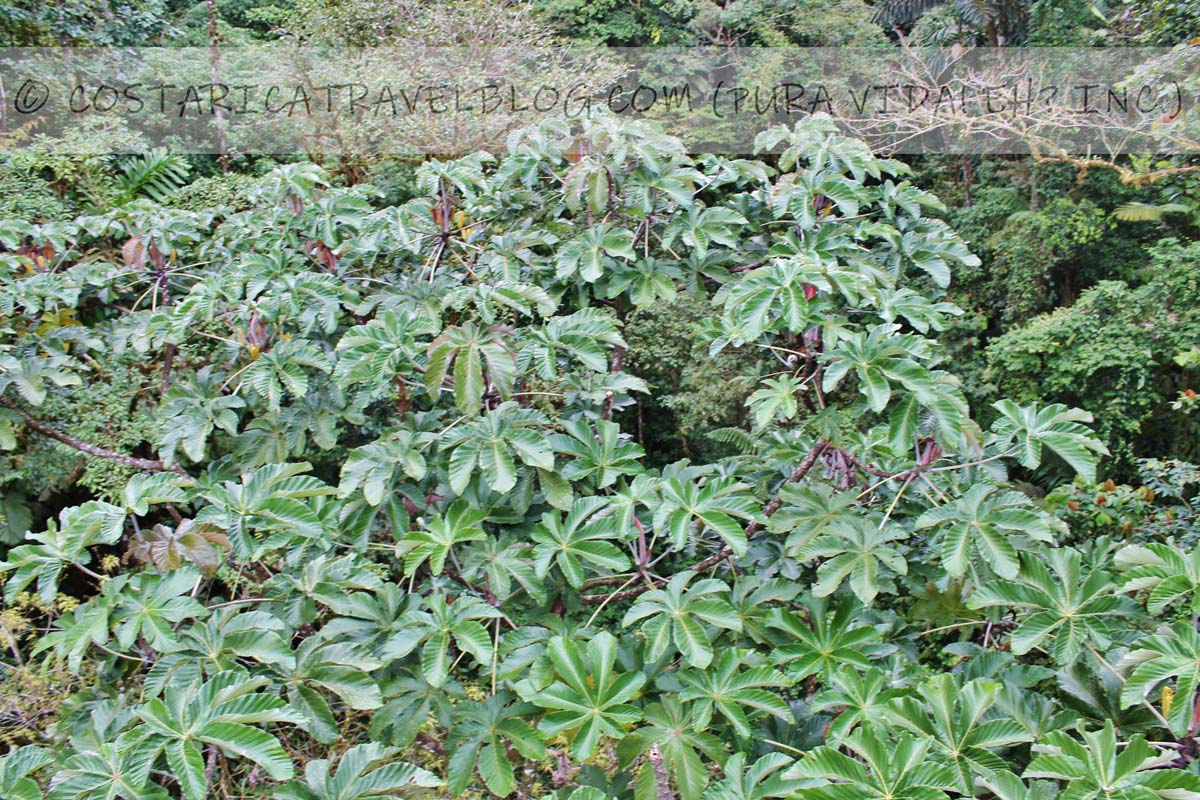
Explore with a guide
Because sloths live somewhat predictable lives—eating, sleeping, resting, and mating among the treetops, and only occasionally visiting the forest floor—oftentimes locals know exactly where to find them . In particular, tour guides, who sometimes traverse the same nature trails several times each day or week, are partial to this information. Choose to tour a national park, biological reserve, or wildlife refuge alongside a knowledgeable tour guide and he or she may lead you directly to a sloth. For more information about guided tours in Costa Rica, don’t miss our related blog post: Costa Rica Guided Tours: Are They Necessary, Valuable, And/Or Worthwhile?
Know what you’re looking for
Regardless of whether you opt to tour Costa Rica with a guide or not, it’s important you know what to look for. Adult sloths range in size but typically average around two feet in length , excluding their long arm span and “fingers” which resemble claws. Their fur is greyish-brown and coarse-looking , and their face may have a pig-like nose, if they’re a two-toed sloth , or dark markings around the eyes like a raccoon, if they’re a three-toed sloth . Both varieties are usually seen lying across tree branches, hanging from tree branches, or curled up in a ball , typically in the crook of a tree.
Keep your eyes on the water
Did you know that sloths can swim ? It’s tough to see sloths in Costa Rica taking a dip, but that does happen. Though you likely won’t spot a sloth playing in the waves that roll into Costa Rica’s two coasts, you could see one wading in calmer waters, including slow-moving rivers and canals , so keep an eye out around these ecosystems too.
Fortunately, sloths can be seen year-round in Costa Rica , so feel free to visit at any time. This being said, your sloth-viewing experience in Costa Rica will be determined in part by Costa Rica’s weather and tourist seasons . For example, if you decide to search for sloths in Costa Rica during the dry/summer/high season, it’s less likely that you’ll be bothered by rain, which may translate to a more enjoyable spotting experience. This being said, fewer travelers descend upon Costa Rica during the wet/green/winter/low season and wildlife-spotting opportunities tend to be optimal when fewer people are around; traveling during this period may produce more sloth sightings. For more information about Costa Rica’s various seasons, including the pros and cons of visiting during each, don’t miss our related blog post: When To Go To Costa Rica According To Cost, Weather, Wildlife And More!
Unlike some other bloggers, we write about things we have firsthand experience with. To help prove this point (though we haven’t always been diligent about taking photos at each and every place we have explored), here’s a photo gallery that shows a few of our visits to most of the sites discussed above. To those of you who choose to read our Costa Rica Travel Blog, thank you for your preference and for supporting our earned, authentic, valuable content.
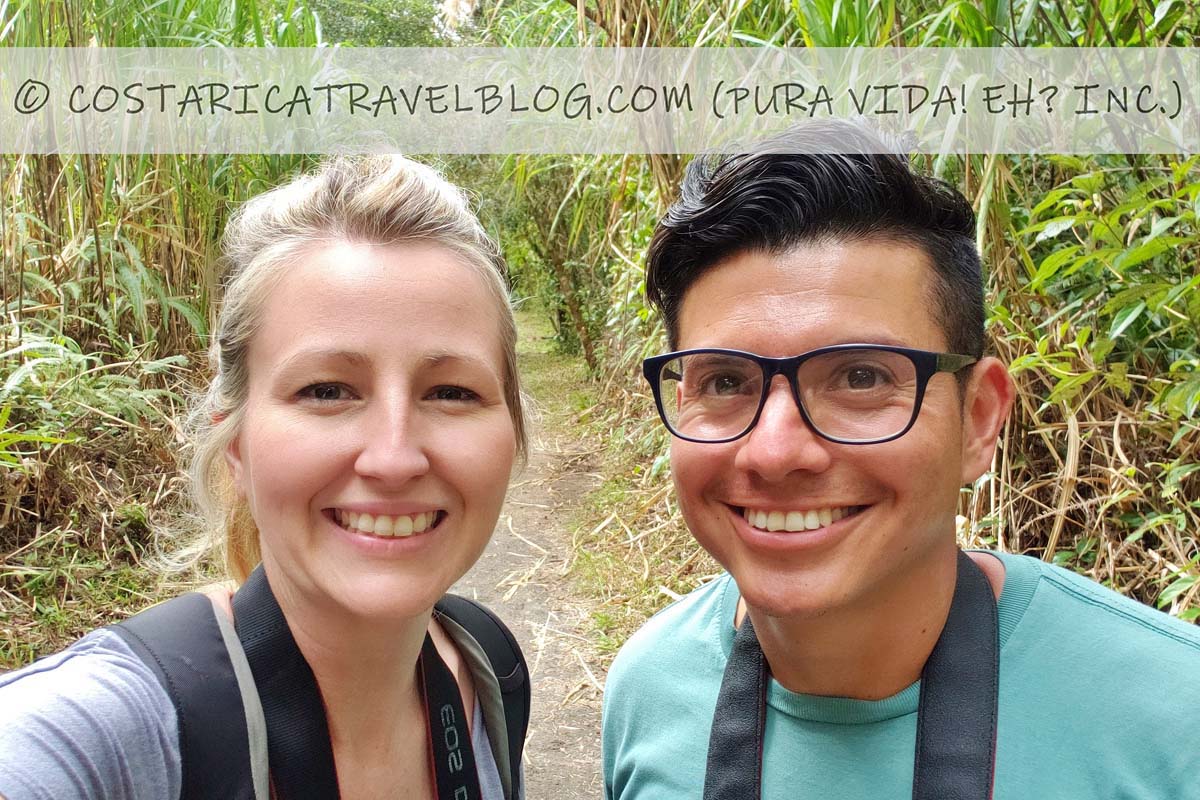
QUESTION TO COMMENT ON: Where have you seen sloths in Costa Rica?

Hey, Costa Rica Travel Blog reader, thank you for visiting and reading our blog! We're truly grateful for your time and preference.
Do you know that your spam-free reading experience is most important to us? Unlike some other Costa Rica blogs, we do not to sell your personal information, and we choose not to display ads, sponsored content, or affiliate marketing on our blog so we can keep your visit as distraction- and junk-free as possible. Because we prioritize your privacy, we don't earn money when you visit us, when you sign up for our e-course, or when you click on our links, which means the time and work we put into this blog—including its 300+ articles—is entirely voluntary! If you find our content valuable, and you'd like to thank us for making the trip-planning process easier and your Costa Rica vacation more enjoyable , please consider making a small donation ($1, $2, $3, or an amount of your choosing) to our blog. Doing so is a great way to pat us on the back if you feel we deserve it . 😊 Pura vida, amigos!

Click on the button above to donate through PayPal. (If you cannot see the PayPal button above, click here .) A PayPal account is not required to make a donation; credit and debit cards are also accepted. PayPal donations are confidential; we never see your payment details.

Tagged: sloth , sloths
- Author Posts
The comment section of this article has moved! If you have a question or comment about our article above or Costa Rica travel in general, please post it in our Questions and Answers Forum on DIY Costa Rica , our sister website, where you can also access our private Costa Rica recommendations, our Costa Rica Destination Tool, and our Costa Rica Recommendations Map. See you there, amigos! 🙂
- The forum ‘Costa Rica Travel Blog Forum’ is closed to new topics and replies.
- Kale by LyraThemes.com.
We're Nikki and Ricky, and we're human!
Sadly, ai-generated costa rica blogs and guides are taking over the internet. thank you for choosing our authentic website and resources over others, for trusting our firsthand experience, and for preferring our human-backed recommendations 😀 other ways we are unique:.
✓ We choose not to display ads, sponsored content, or affiliate marketing on our blog. Because we prioritize your privacy, we don't earn money when you visit us, when you sign up for our e-course, or when you click on our links, which means the time and work we put into this blog is entirely voluntary. ✓ Ricky is a born-and-raised Costa Rican and Nikki (married to Ricky) has explored Costa Rica since the mid-2000s . ✓ We've operated our Costa Rica-based business, Pura Vida! eh? Inc. , for 16 years (and counting!) . ✓ Our Costa Rica guidebooks are published by the prestigious Moon Travel Guides brand . ✓ We only ever write about experiences we know firsthand , and we never stuff our blog with general information about Costa Rica that is widely available elsewhere . ✓ We never copy or plagiarize other writers' content . How we wish other writers would show us the same respect! ✓ Unless stated otherwise, every photo displayed on our blog was taken by us, and with our own two hands. (Unlike some other bloggers, who rely on drones to travel and conduct research for them, we actually visit and explore the places we write about .)👍🏽 ✓ We're active in promoting Costa Rica around the world . We've written about Costa Rica for Wanderlust Magazine (UK), presented Costa Rica on Rick Steves' Monday Night Travel Show and podcast/radio show (US), and served as a Costa Rica Destination Editor for Essentialist (Spain). ✓ Our work is backed by hundreds of positive reviews and testimonials ( read some here ) ✓ We are not overly active on social media . Instead of fixating on our own popularity, we spend the majority of our time exploring and researching Costa Rica, updating our various Costa Rica resources, and working with travelers one-on-one. We're focused on the quality of your travel experience , not the quantity of our followers. ❤️
We hope you enjoy your visit to our junk-free blog as much as your time in Costa Rica. 😊

- Privacy Policy Overview
- Remember my preference
This website uses cookies to operate and provide you with the best user experience possible. To ensure you're aware of and okay with this and our other privacy-related practices, please review our Privacy Policy, then click the button below to accept it.
If you do not accept the policy, we respect your choice 100%. Unfortunately, several of our website’s features, including our Questions and Answers Forum, rely on cookies to operate. Most are also run by themes, plugins, and other add-ons to our website that we do not and cannot control, which means the cookies you receive are mainly provided by third parties. Because simple actions like reading our articles, asking a question, and even visiting our website’s homepage require the use of cookies, it is not possible to explore or use our website without them. If you would prefer not to receive cookies, we kindly (and sadly) ask that you do not visit our website. (Alternatively, you can try setting your browser to remove or reject browser cookies before visiting our website, but you may find that our website doesn’t function properly without them.) By visiting or submitting information through our website, you acknowledge and accept our use of cookies, and the use of third-party cookies. For more information, please see our Privacy Policy.
Thank you for understanding!
In order for our site to remember that you accept our policy, please enable the Strictly Necessary Cookie.
If you leave the Strictly Necessary Cookie disabled, we will not be able to save your preference. This means that every time you visit this website you will need to accept the policy again.

Let's Travel Costa Rica

Where To See Sloths in Costa Rica (11 Best Places!)
Wondering where to see sloths in Costa Rica? You’re not alone! Sloths (aka perezosos) are practically an unofficial mascot of Costa Rica and many visitors have “see a sloth” on their trip bucket list. But where are the best places to see sloths in Costa Rica? Luckily, these slow-moving animals can be found across the country. Here are our picks of the 11 best places to see sloths in Costa Rica.
Table of Contents
What Types Of Sloths Are Found in Costa Rica?
There are two different species of sloths in Costa Rica, the two-toed and the three-toed. Sloths are known for their incredibly slow movements as well as spending the majority of their lives hanging in the trees. However, sloths are also incredible swimmers! These herbivores sleep for up to 20 hours a day, and only descend to the ground once a week to relieve themselves (ie. poop).
Sloths have some interesting adaptations! One is their symbiotic relationship with algae that clings to their hair and helps them camouflage. Another sloth factoid: because their bodies are adapted to hang all day they can’t walk. So, when they are on the ground, they crawl.
These are some of the similarities between the two Costa Rica sloth species. Though, there are a few differences.
- Three-Toed Sloths. There are four species of three-toed sloths, the three-toed sloth in Costa Rica is the species known as brown-throated three-toed sloths. Three-toed sloths are smaller than two-toed sloths weighing an average of 10 pounds. Beyond the size difference, brown-throated sloths have black markings around their eyes, creating a bandit-like appearance. While all sloths have three toes per foot, three-toed sloths have three claws on each. Another interesting attribute of the three-toed sloth is that they have more vertebrae than other mammals. This makes them able to turn their heads nearly 300 degrees to scan for predators. Males can be distinguished from females because they have a black strip on their backs along with a bright orange patch.
- Hoffmann’s Two-Toed Sloths. There are two species of two-toed sloths, the two-toed sloth in Costa Rica is known as Hoffmann’s. Named after Karl Hoffmann, a German naturalist, two-toed sloths are nocturnal. Unlike the three-toed sloth that doesn’t have a preference, Hoffmann’s two-toed sloths are active at night. They are also larger, weighing an average of 15 pounds and are approximately 25 inches in length. Two-toed sloths have bigger eyes and a lighter coloring. With claws ranging from 3 to 4 inches, they have two claws instead of three on each foot.
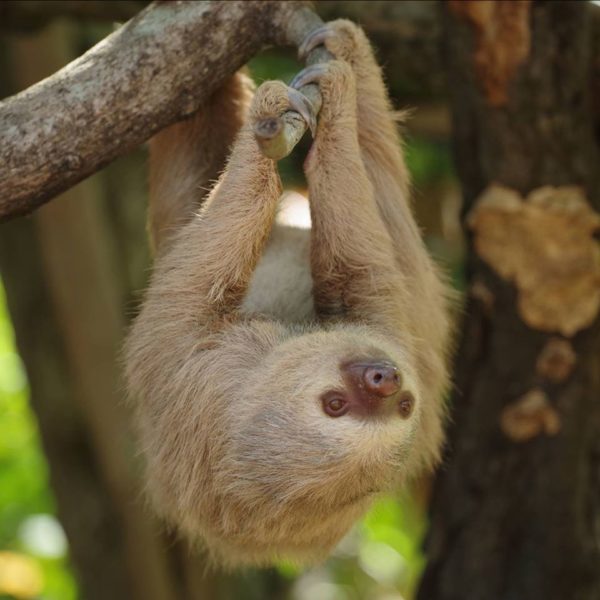
Read More : 16 Best National Parks in Costa Rica (& Free Checklist!)
Is There Anywhere in Costa Rica to Pet Sloths?
No. As with all wild animals, you should never pet a sloth.
While sloths appear calm and relaxed to the untrained eye, research shows that sloths get very stressed when handled. Their heart rate increases and they become more alert. This change can have various harmful effects on sloths. If they are pregnant, they can miscarry. Plus, humans can pass on foreign microbes to sloths when they interact and this can cause them to get sick.
One of their defenses is to try and appear larger by moving and waving their limbs. Sadly, some tourists see this as a cute wave to be picked up. It is not!
Due to the popularity of selfies with sloths, there is an increase in poaching. This could change their endangered status from least concerned to vulnerable.
If you want a selfie with a sloth in Costa Rica, do it from a distance and without a flash . Sloths are very sensitive to light.

The Best Places To See Sloths in Costa Rica
Visitors will find numerous places to see sloths in Costa Rica! Both the three-toed and two-toed sloth can be found in the same places. However, in places at higher elevations, like Monteverde and Vara Blanca, only the two-toed sloth can be found. Plus, thanks to them not being an endangered species, their numbers are abundant.
Along with the national parks, there are a few rescue centers and sanctuaries in Costa Rica where you can see sloths. Please note that you are NOT allowed to pet, hold, or touch a sloth in Costa Rica!
The best places to see sloths in Costa Rica are in the wild! I also recommend hiring a guide to help you spot them. They have a keen eye, binoculars, and are trained to see sloths in the wild.
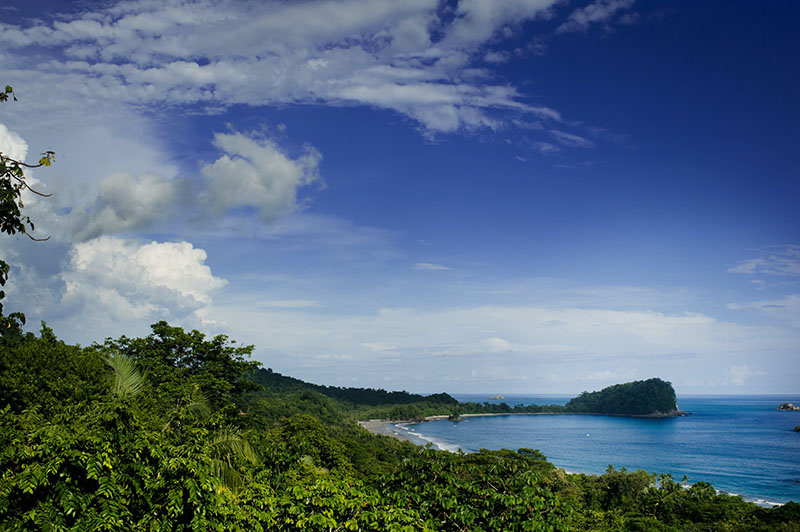
Manuel Antonio National Park
One of the best places to see sloths in Costa Rica is in Manuel Antonio National Park. Filled with incredible rainforests, beautiful beaches, and abundant wildlife, it’s no surprise Manuel Antonio is the most popular park in the country!
The park is also home to a large number of sloths, both the two-toed and three-toed sloth.
While you can explore the park on your own, the best way to see sloths in Manuel Antonio National Park is with a guide. They know where to look. Plus, guides carry binoculars and telescopic lenses to see sloths better from afar.
When we visited the national park and hired a guide, we were able to see not only several different sloths but also a mama sloth and her baby. It was truly incredible!
The best place in Manuel Antonio to see sloths is along the Sendero el Perezoso Trail. Also known as the Sloth Trail, this short trail runs parallel to the main trail. Taking you through denser rainforest this boardwalk trail is a great place to spot a variety of wildlife, including sloths!

Corcovado National Park
On the Osa Peninsula, in the southwestern area of Costa Rica is another park that’s ideal for seeing sloths. The Corcovado National Park is one of the most biologically diverse parks in Costa Rica!
The park is home to a wealth of wildlife, including all four species of monkeys. Also, Corcovado National Park is home to two-toed sloths and three-toed sloths.
Visitors to Corcovado can only enter with a guide. However, visiting the park with a guide means it will be easier to see sloths in the wild.
Read More: The 6 Wild Cats in Costa Rica (+ Where You Might See Them)

Best known as the gateway to Arenal Volcano National Park, La Fortuna is a great place to see sloths close to Guanacaste. This charming small town is 3 hours northwest of San Jose.
Right in La Fortuna, is a special place where visitors can see sloths. Located on a restored secondary rainforest property, the Bogarin Trail is home to roughly 25 sloths. Visitors can enjoy an easy 1.5-mile hike around the property and spot a variety of wildlife. Both Hoffmann’s two-toed sloths and brown-throated three-toed sloths can be seen here.
Visiting the Bogarin Trail can be done on your own or with a guide.
Bijagua (Tenorio Volcano Area)
If you’ll be based in Guanacaste, definitely make it a point to head to Bijagua if you’d like to see sloths in the wild. Located between the base of two volcanoes, this area is famous for spotting wildlife. Not only sloths but also monkeys, toucans, and even macaws. It’s also near to the famous Rio Celeste, so you can easily turn it into a full-day trip.
There are several private properties that offer wildlife tours, which are your best bet for seeing sloths. You can drive to Bijagua Ranas on your own and pay a per-person fee (around $15 plus tip) or, if you didn’t rent a car, join a tour that will include lunch and a visit to Rio Celeste as well.

Puerto Viejo
For those looking to see sloths in Costa Rica on the Caribbean coast, there are a few great options. Beyond seeing them in national parks and wildlife refuges, many people see sloths from their lodges in Puerto Viejo, hanging out in nearby trees.
On our last trip to Puerto Viejo, we were lucky enough to see one who had crawled down the tree to relieve itself (something they do just once a week!) on the trail that runs between La Salsa Brava bar to Playa Chiquita.
Cahuita National Park
Another great place on Costa Rica’s Caribbean coast to see sloths in Costa Rica is in Cahuita National Park.
Best known for the 18th century shipwreck in its waters, the national park protects both land and sea. Plus, along with a myriad of flora and fauna, Cahuita is home to brown-throated and Hoffmann’s sloths.
Due to the myriad of flora and fauna, we do definitely recommend hiring a guide here. We’ve done it both with and without a guide and truthfully saw so much more during the visit with the guide.
Also, be sure to bring your swimsuit – the beach within the park is incredible for swimming!

Tortuguero National Park
Famous for the sea turtles that nest on its beaches, Tortuguero National Park is a great place to spot wildlife, including sloths, in Costa Rica. Located along the northern Caribbean coast, Tortuguero is filled with winding canals and dense rainforests.
Hop aboard one of their ecological boat tours for an interesting perspective on spotting wildlife. From the boat, canoe or kayak you can see monkeys playing in the trees or sloths hanging out in them. Plus, you might see a sloth swimming here. (A rare site but one that feels truly magical if you get to witness it!)
Further inland from the Caribbean coast is another place to see sloths in the wild. Sarapiqui is an interesting town with a fusion of nature and culture. There are plenty of places to see sloths here, including along the Sarapiqui River as well as the Tirimbina Biological Reserve .
Jaguar Rescue Center
For those looking to see sloths, there are a few rescue centers in Costa Rica where you can go. However, be sure they are reputable!
Near Puerto Viejo, on the Caribbean coast, is Jaguar Rescue Center . As part of the La Ceiba wildlife refuge, this facility temporarily cares for injured, sick, and orphaned animals. Their goal is to rehabilitate wildlife and release them back into the wild.
Jaguar Rescue Center is home to a variety of animals like cats, birds, monkeys, and reptiles. Plus, Jaguar Rescue Center has sloths too!
They offer both public and private tours.

Toucan Rescue Ranch
Another wildlife rescue center is the Toucan Rescue Ranch . This is a great spot to enjoy a hands-free experience with sloths in Costa Rica.
The facility is located in Heredia, an hour north of San Jose. Their mission is to rescue, rehabilitate, and release wildlife. Along with saving wildlife they are also committed to conservation efforts, research and education. They work directly with the Costa Rican government, so you know they are a reputable organization.
The wildlife rescue center is home to an assortment of animals, many of which are sloths. Along with rehabbing wildlife to be released back into the wild, some sadly are not fit and in turn, remain at the facility.
The Toucan Rescue Ranch even has a specific sloth tour.
Diamante Eco Adventure Park
Just outside of Playas del Coco , is a different kind of park where you can see two-toed sloths in Costa Rica. The Diamante Eco Adventure Park is a popular adventure park located an hour west of Liberia.
While not as thrilling as seeing sloths in the wild, the park is home to three two-toed sloths in a large habitat. This is a guaranteed way to see sloths in Costa Rica, especially if you won’t have a chance to visit any of the national parks.
At the park, visitors can also zipline through the forest canopy as well as tour a butterfly house and wildlife center. At their Costa Rica Wildlife Sanctuary are various Costa Rican mammals, birds, and reptiles. They house wildlife that are sadly not able to be returned to the wild.
Similar Posts

Everything You Need to Know About Llanos de Cortes Waterfall
By Jennifer LaCharite The province of Guanacaste along the North Pacific Coast of Costa Rica is known for its dry forest and dry heat (December to May). But there is a tropical oasis that is a must-see spot if you find yourself in the area. Catarata Llanos de Cortes is a 28-meter (92-foot) waterfall that…

10 Incredible Animals You Can See in Costa Rica
Costa Rica is home to 2.5% of the planet’s biodiversity. Sadly, in the last 50 years, we’ve lost over 60% of all wildlife. Costa Rica is at the frontlines of preservation for animal and plant life with about 28% of the country belonging to protected reserves and National Parks. Because of these conservation efforts, Costa…

8 Incredible Family Activities in Playas del Coco
Playas del Coco is a family-friendly destination. From boat tours to wildlife sanctuaries, there are endless things to do with kids in Playas del Coco – no matter their age or interest.

Costa Rica Pacific Beaches: 12 Stunning Beaches You Can’t Miss
By Jennifer LaCharite From white sand to black volcanic rocky shores, the beaches on Costa Rica’s Pacific Coast are as beautiful as they are unique. With 1,016 kilometers (631 miles) of coastline, there are hundreds of stunning, popular, and secluded beaches to discover. It can be hard to choose which beach(es) to visit, so here’s…

15 Best Things To Do In Tamarindo
With a great location, beach town vibes, restaurants, shops, and tons of activities, Playa Tamarindo along Costa Rica’s North Pacific Coast is one of the top destinations in the large province of Guanacaste. Located just an hour’s drive from the Liberia International Airport and several other beaches, many people choose Tamarindo as a base for…
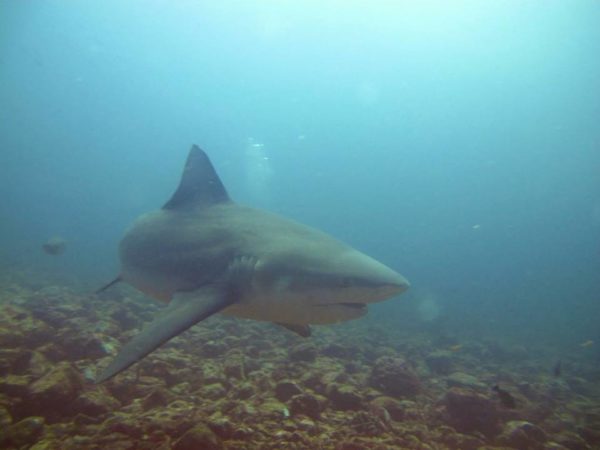
The Ultimate Guide to Diving With Bull Sharks at Bat Islands Costa Rica
By Demi Johnson, Dive Master Scuba diving is a popular activity in Playas del Coco. In fact, Playas del Coco is one of the best places to scuba dive in Costa Rica and many tourists choose Coco as their Costa Rica destination for the primary purpose of diving. We’ve already talked about the basics of diving…
One Comment
Those sloths are pretty adorable. I wish I had hinted sloths when I visited CR!
Leave a Reply Cancel reply
Your email address will not be published. Required fields are marked *
Save my name, email, and website in this browser for the next time I comment.
This site uses Akismet to reduce spam. Learn how your comment data is processed .

- The Complete Guide to Sloths in Costa Rica
The thing about sloths is… we can’t get enough. Despite their laziness, their slooow movements, their strange little bodies, and that fur (we’ll explain later), they are incomprehensively cute. It just doesn’t make any sense! And perhaps, that’s what fascinates us. Or maybe it’s that they always appear to be smiling at us. Or if we’re being honest, it’s that sometimes we’re lazy, and they’re lazy, and we like that. Whatever the case may be, we know you like sloths too or you’re at least curious because we get LOADS of questions and requests for them. So, here it is. You’ve asked and we’ve delivered. We’re finally bringing you our complete guide to sloths in Costa Rica. We’re tackling all your questions about Costa Rican sloth species, the best places to see sloths, why they’re sooo slow, and more. So without slowing things down any further, let’s talk sloths…
Which sloth species live in Costa Rica?
There are six sloth species in the world, and two types of sloths: two-toed sloths and three-toed sloths. Two of the six sloth species live in Costa Rica:
Hoffman’s Two-toed Sloth ( Choloepus Hoffmanni)
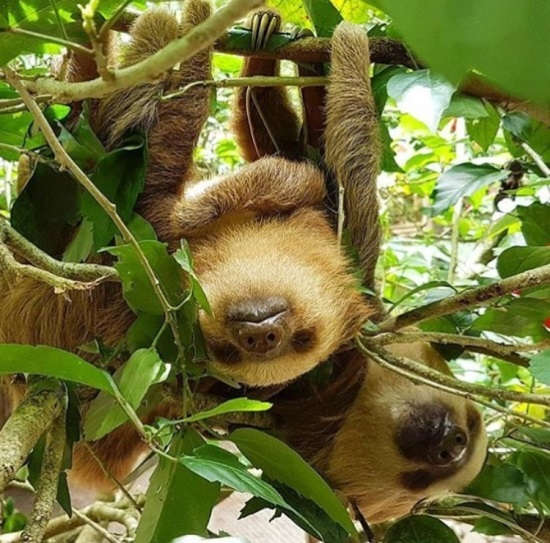
Two-toed sloths (two toes on the front feet and three toes on the back feet) hanging upside down from branches during their daily nap shared with us by @ludo_fortunella !
The Hoffman’s Two-toed Sloth is nocturnal and much more difficult to find. If you do find them during the day, they’ll probably be napping. Although I was once lucky enough to see one on a night hike in Monteverde with the help of a guide.
Brown-throated Sloth (Bradypus Variegatus)
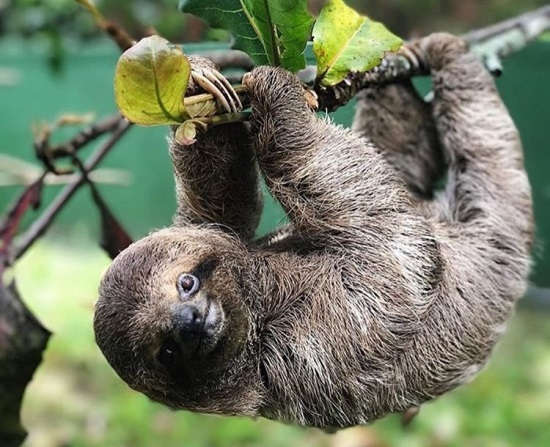
The cutest little thing with three toes shared with us by @maggsye !
The most common three-toed sloth in the world is the diurnal Brown-throated sloth. They are a bit smaller in size than Hoffman’s sloth as they slightly more active.
Are sloths endangered?
The sloths of Costa Rica are not, but the maned sloth of Brazil and the Pygmy sloth from Panama are endangered.
Why are sloths so slow?
Sloths have the slowest digestion system of any mammal. It can take them two weeks to fully digest a meal! In an effort to conserve energy, sloths have evolved to do less rather than eat more. They can spend up to 20 hours a day sleeping to conserve energy.
What do sloths eat?
Mostly leaves, branches, buds, and occasionally insects. Cecropia tree leaves are their favorite snack.
What eats them?
Wildcats and Harpy Eagles, but the sloth’s slow infrequent movements and canopy-colored fur make them difficult to spot. Other than that, sloths aren’t exactly a popular menu item in the animal kingdom. They have those long claw-like toes and their fur isn’t exactly appetizing.
Okay, what’s the deal with their fur?
The fur of a sloth is actually an entire ecosystem in and of itself with colonies of algae, fungi, moths, mites, and the like. The ecosystem serves as a sort of symbiotic relationship with the sloth as it gives them a green tint that allows them to hide from predators and also serves to make them rather unappetizing.
Where should I go to see sloths in the wild?
Sloths are plentiful throughout Costa Rica but may be difficult to spot to the untrained eye. A professional naturalist guide can help point them out. As a general rule, the further south you go along the Pacific coast, the more likely you are to see wildlife as the concentrations are higher. The South Pacific and Osa Peninsula are prime wildlife watching destinations .
Where should I look?

Brown-throated sloth smiles seen from Tulemar Resort in Manuel Antonio
Look up! Sloths are tree-dwellers. Listen closely for leaf rustling and scan the canopy treetops where sloths spend the majority of their time. They only occasionally can be seen on the ground where they go to defecate about once a week because of that slow metabolism. Their weekly trek down to the forest floor is life-threatening and the cause of about half of adult sloth mortalities.
Sloth Tours

The cuddliest pair spotted in Manuel Antonio National Park
To see the nocturnal two-toed sloth in the wild, we recommend a guided night hike. These can be arranged from most destinations in Costa Rica . Just ask one of our Costa Rica Experts!
If you’re looking to see a sloth during the day, get out there and explore the many national parks of Costa Rica WITH A GUIDE. The only times I have ever seen a sloth in the wild were with the help of a naturalist guide. Guides have finely-tuned sloth spotting skills. Just let them know at the start of the tour that seeing a sloth is high on your priority list!
Sloths can also be found at wildlife refuges and sanctuaries. An Expert can help you make a selection based on your destinations if this is of interest!
A word of caution: Please do not attempt to hold or get too close to sloths. Despite their incomprehensible cuteness, they are animals. If you still cannot resist, please revisit question #6: okay , what’s the deal with their fur?
Why are sloths called sloths?

These days sloths are so popular they have even made an appearance on the local currency … one more reason to exchange your money for Colones! Picture shared by @ipadarath !
As the story goes, back in the day – sloths weren’t so popular. Many scientists deemed them slow useless animals unlikely to survive in the wild. With that, they selected the name “sloth.” Turns out they were wrong. Sloths are alive and well and one of the most popular animals in Costa Rica. Don’t you love a good comeback story?
I can’t get enough! Tell me more.
- Sloths are related to anteaters and armadillos.
- Sloths are surprisingly great swimmers.
- Sloths have a quarter of the muscle mass of other animals their size.
- Wild sloths typically live up to 12 years.
So, there it is! Now you are a certified sloth expert. If we missed anything, please leave your questions in the comments. Now all that’s left to do is book a trip to see these sloths for yourself!
Ready to book a trip? Check out our Sloths & Treehouses vacation package (you can customize it)!
Not so fast shop our wildlife vacation packages ..
Related Articles:
- How to See The Most Wildlife in Costa Rica
- 8 Costa Rica Natural Mysteries You Have to See to Believe
- A Guide To The Most Popular Birds of Costa Rica
- 7 Best Places to See Wildlife in Costa Rica
- Costa Rica Whale Watching Tour Guide: Where To Go When
2 Responses to “The Complete Guide to Sloths in Costa Rica”
Hi Sarah! My name is aarthi and I am planning to travel with my family of 4 end of March to costa rica. We are interested in seeing sloths and tutle nesting. Which place in costa rica would be the best to stay and spot wildlife such as sloths and turtles. Thanks.
Hi Aarthi! If you’re interested in wildlife and feeling adventurous, I would recommend the Osa Peninsula – the best destination in the country of wildlife. Both sloths and turtles can be seen there during nesting months. Manuel Antonio is another fantastic option for wildlife viewing if you’re looking for something not so far off-the-beaten-path. The Nicoya Peninsula and the South Pacific Coast may also be good options!
The Latest:
- How to Get to the Osa Peninsula Rainforest
- 9 Top Tips For Easier Travel With Little Kids in Costa Rica
- Adventure & Romance Tour Pairings For A Well-Balanced Honeymoon
- In 2024, Costa Rica Takes Center Stage
- 10 Best Costa Rica Beaches For Families
- Worth-It Costa Rica Family Tours for Big & Little Kids
- Costa Rica Rainy Season Guide: Why & When To Visit
- How To Get Around Costa Rica: Cars, Flights, Boat & More
- 11 Top Costa Rica Honeymoon Bungalows & Suites
- 11 Best Costa Rica Honeymoon Resorts & Hotels
- Costa Rica Currency: Money, Tipping, & Exchanging on Vacation
- Costa Rica Experts Wins 2022 Tripadvisor Travelers’ Choice Award
Explore by Interest:
- Adventure Travel
- Attractions
- Best of Costa Rica
- Destinations
- Food + Flavors
- Health & Wellness
- Hotel Reviews
- Industry Interviews
- Luxury Travel
- National Park Guides
- Seasonal Guides
- Tips + Tricks
- Travel Inspiration
- Travelogues
- Uncategorized
- Wildlife Guides
YOU DESERVE A VACATION PLANNED BY EXPERTS.
Us headquarters, costa rica office.
Barrio La California, Calles 27 & 29, Ave 2, Ed #2798 Oficina #8 San Jose, Costa Rica 10104
READ OUR REVIEWS

- DESTINATIONS
- THINGS TO DO
- PLAN YOUR TRIP
Privacy Overview
This is a necessary category.
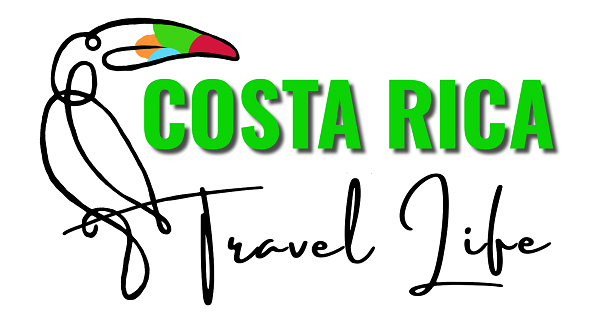
Home » Travel Planning and Inspiration » Where to See Sloths in Costa Rica +Facts and Tips!
Where to See Sloths in Costa Rica +Facts and Tips!
By Author Costa Rica Travel Life
Posted on Published: November 11, 2022 - Last updated: March 17, 2024
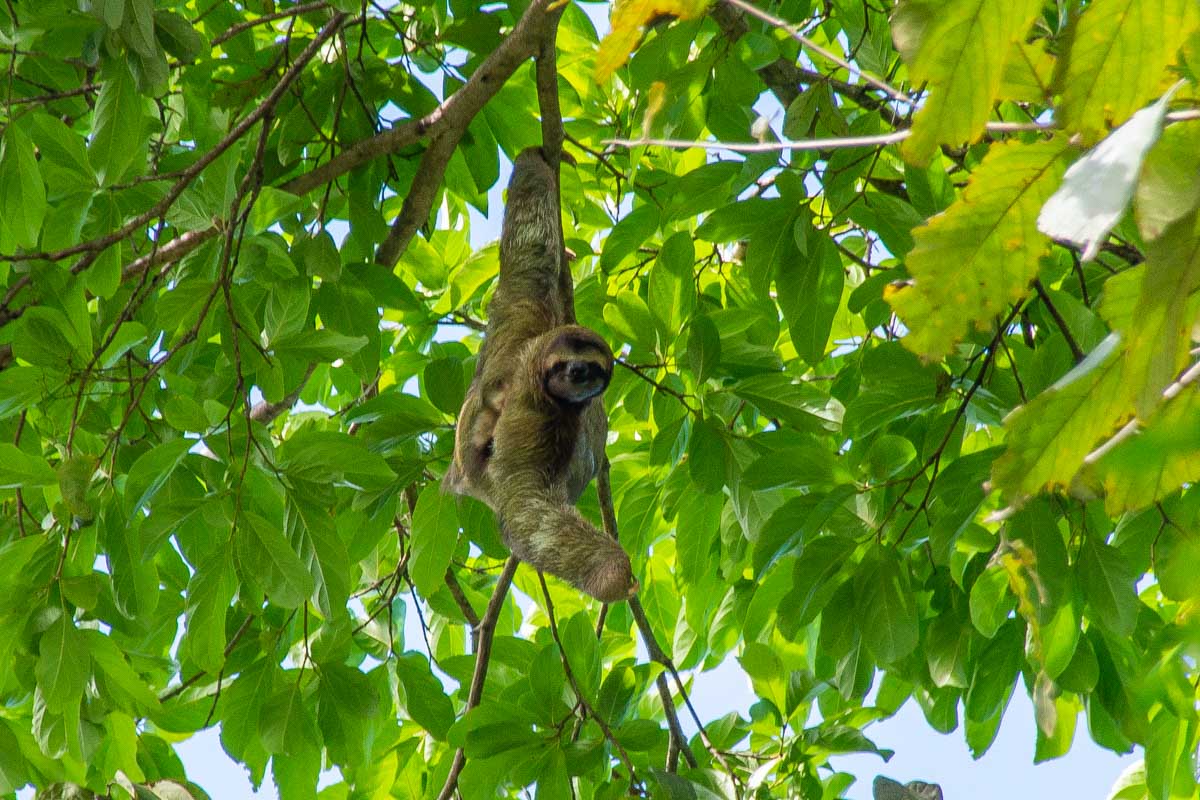
This blog may contain affiliate links. Read our disclosure policy for more info.
Costa Rica is one of our favorite countries to visit. As outdoor enthusiasts, we fell in love with the lush rainforests and the great hiking in the area. So naturally, one of the best things to do in Costa Rica is spotting the wildlife – especially sloths! We’ve been lucky enough to see them hiding in trees, on guided tours, and in sloth sanctuaries.
Costa Rica is one of the most biodiverse areas in the world. There are about half a million species living in the country, making exploring the rainforest a real treat. One of the best animals to see in Costa Rica are the sloths that call this area home. Whether you visit one of the many sloth sanctuaries in Costa Rica or spot them in their natural habitat, seeing a sloth can easily be the highlight of your trip.
Now, as a self-proclaimed sloth expert, I am sharing all my tips and advice for where are the best places to see sloths and how to spot them.
Species of Sloth in Costa Rica
Costa Rica is home to two different species of sloth. When I last went to Costa Rica, I was lucky enough to see both types and I can tell you confidently, they’re both adorable! Both sloths have 3 toes on their hind feet but differ in the number of toes on their front feet. For this reason, they’re called 3-toed sloths and 2-toed sloths.
Unless you get up close to the sloths, they look largely the same and can be hard to distinguish between. To help, I’ve listed some key differences between the two below.
Two Toed Sloths
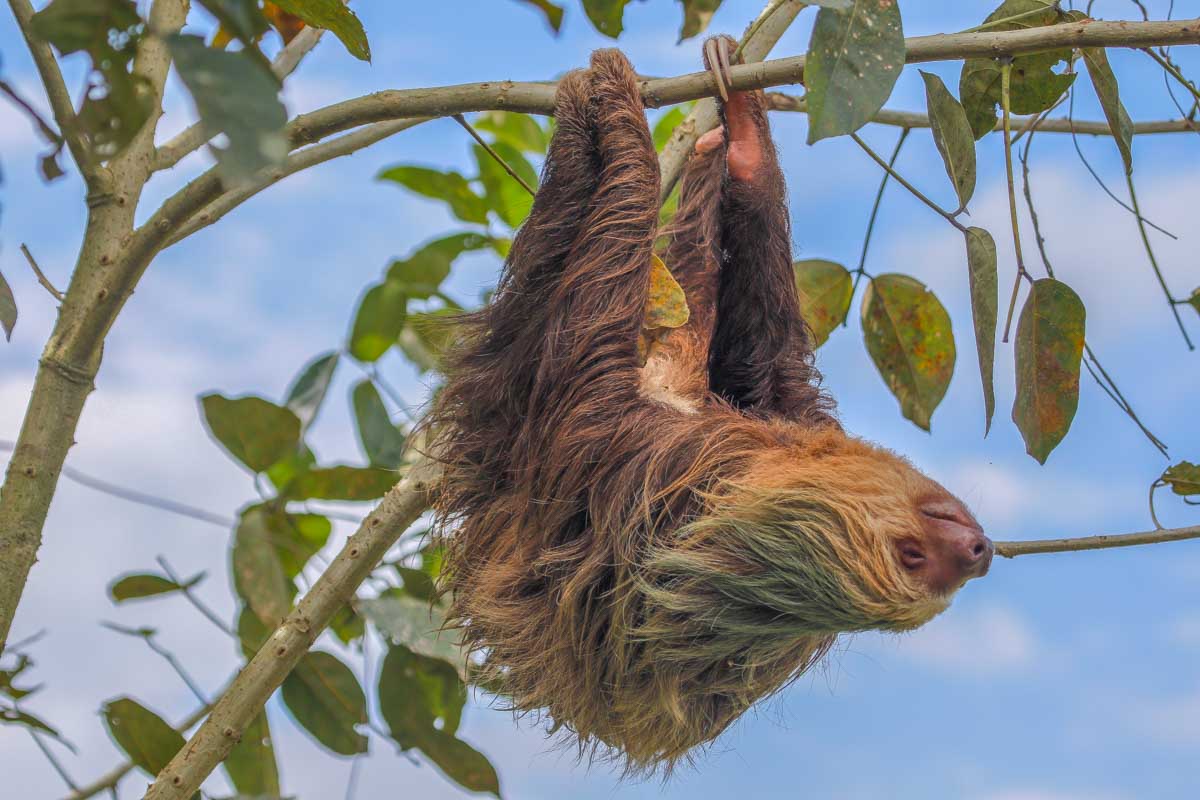
Two toed sloths are unique in that they have three toes on their back legs with only two toes on their front. While they look quite similar to their three toed cousins, two toed sloths, also known as Hoffman’s two toed sloths, are larger in size. They also have a longer snout and no hair on the soles of their feet.
Two toed sloths are nocturnal, making them much harder to spot. If you’re hoping to see these sweet little guys, I recommend looking high in the treetops for a sleeping animal resting on a branch.
Three toed sloths
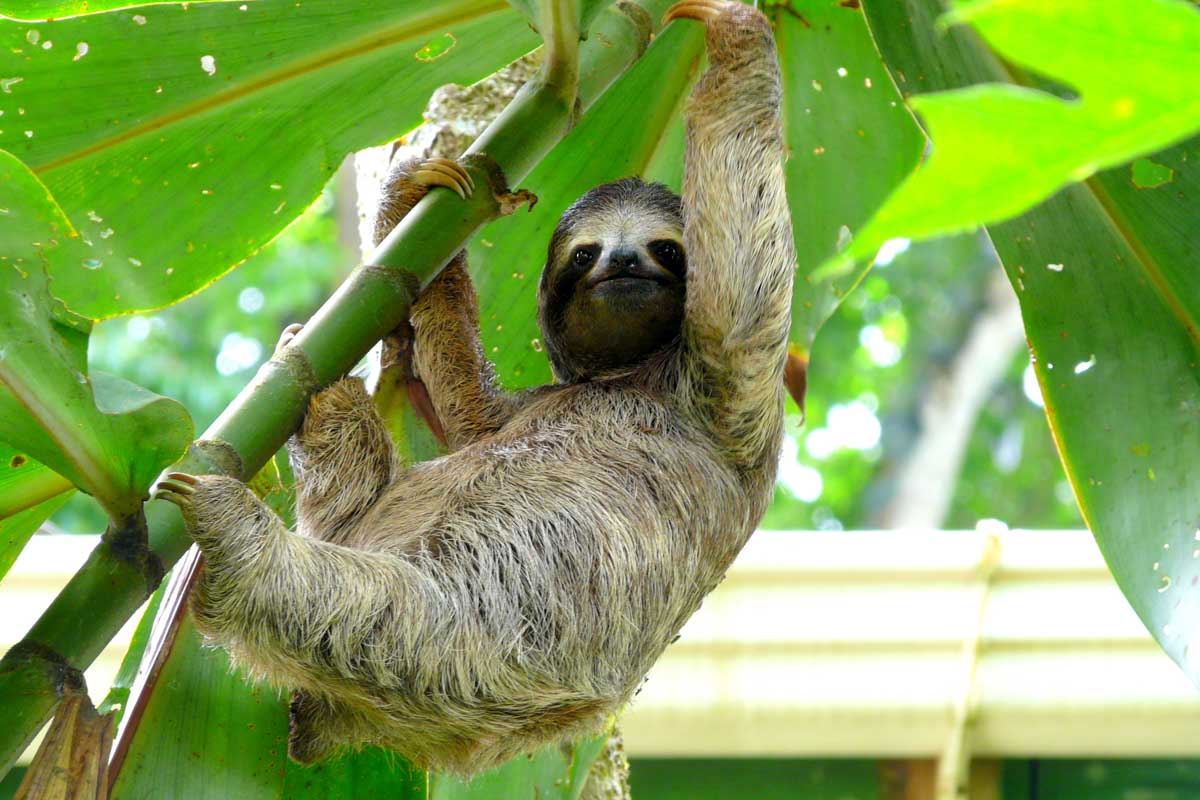
The easiest way to identify a three toed sloth is by counting the toes on their front feet. These sloths have three toes on both their front and hind feet with long claws. They are generally smaller in size and have a distinguishably round head and short snout. Three-fingered sloths, while still sleeping an impressive 15+ hours a day, are awake in both daytime and nighttime, so they are typically easier to spot.
Facts about Sloths in Costa Rica
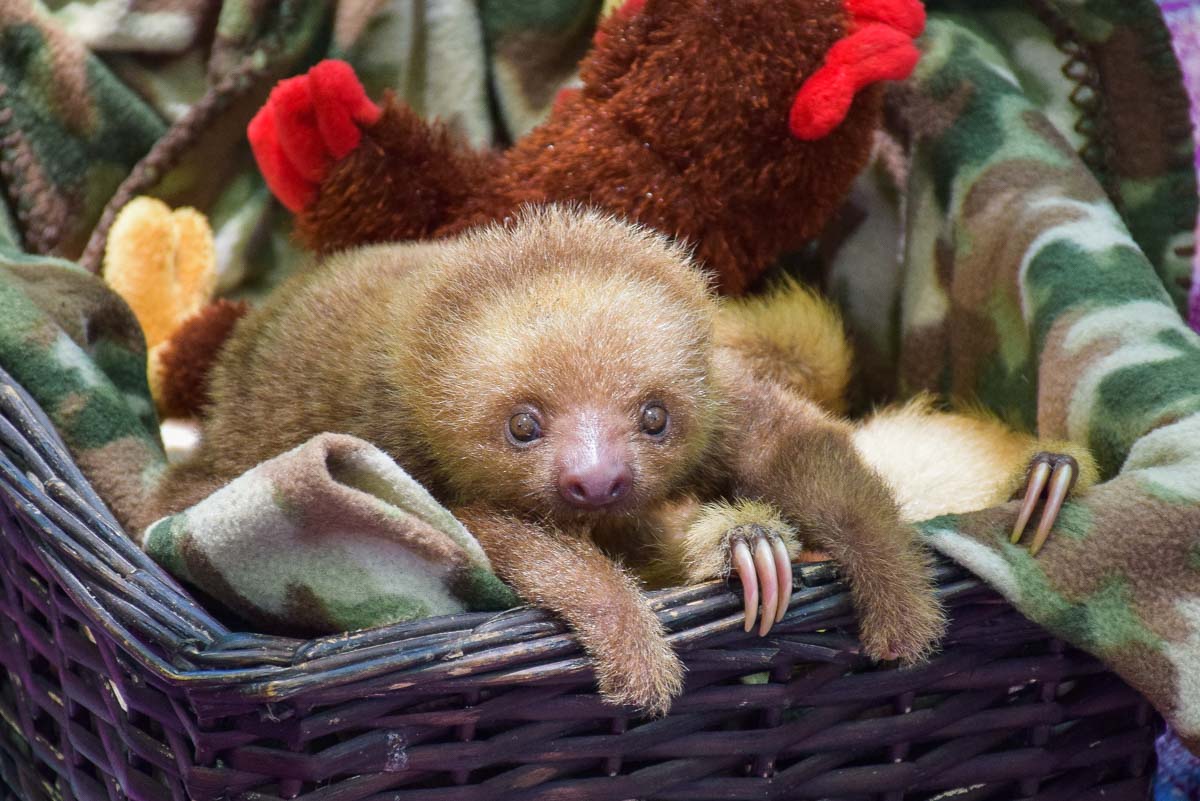
- Sloths were first discovered in the 1700s and include 6 species (2 are on the endangered list). Costa Rica is home to 2 of the 6 species of sloths.
- Their fur is actually home to algae and moths, which they sometimes eat.
- Sloths only poop once a week. They come down from high in the trees to the forest floor to do their business – an act that has scientists stumped as this is the most dangerous part of their lives and leaves them vulnerable to their predators.
- Much like owls, sloths can turn their head almost entirely around.
- Sloths like to be upside down. In fact, they can spend up to 90% of their life this way and their bodies have naturally adapted their internal organs.
- Even though sloths are known for being slow, even lazy, they can hustle in water. They can swim nearly 3x faster than they can move on land.
- It can take a sloth up to 30 days to digest a single leaf.
- They travel at around 13 feet (4 meters) per day and use their claws to drag them along the ground because they cannot walk.
Best Places to See Sloths in the Wild in Costa Rica

Sloths are at home in tropical places. If you are wondering where to see sloths in Costa Rica, you’ll be happy to learn that sloths can be found all over this beautiful country. However, there are more sloths in certain parts of the country.
Below are some places to see sloths in Costa Rica:
A popular destination in Costa Rica is visiting the La Fortuna region , popular for hanging bridges , hot springs , and Arenal Volcano. This area is surrounded by rainforests, a sloth’s favorite place to call home. This area is a mix of both primary and secondary rainforests (rainforests that have newer growth).
While there are sloths living in this area, they can still be hard to spot so I’d highly recommend taking a sloth tour in La Fortuna .
If you want to better your chances of spotting a sloth, for only $35 USD you can take this 1-2 hour sloth watching tour – it’s one of the best cheap things to do in La Fortuna ! There is a morning, afternoon, and evening departure times so you can plan your day accordingly. Even though sloths are the main attraction, you should expect to see porcupines, toucans, and red frogs, on the jungle hike.
Manuel Antonio National Park
Manuel Antonio National Park is a great place to go to see sloths in their natural environment. This rainforest is humid year-round, attracting sloths. On top of that, the national park is a protected area for wildlife to enjoy.
Sloths are so common here that they actually have a trail in the park called “The Sloth Trail.” Defintiely plan on walking the Sloth Trail if you want a chance to see one. I know I’ve said this before, but although they are common, sloths are still really hard to spot if you don’t know what to look for, which why a tour guide is handy.
This 3 hour all-inclusive Manuel Antonio National Park guided tour includes air-conditioned transportation from your hotel in Manuel Antonio or Quepos, entry into the National Park, a bilingual tour guide, and photos from their spotting scopes – all for $69 USD. The guide will help you find not just sloths, but also toucans and monkeys on your stroll through the Costa Rican jungle.

Cahuita and Puerto Viejo
If you’re traveling on the southeast coast of Costa Rica and you’re wanting to see sloths, Cahuita National Park is a good place to go. This is a great area to go if you love hiking and being submerged in nature. What’s cool about this Caribbean coastal area is that the rainforest runs right into the white sandy beaches.
Puerto Viejo is famed for being the perfect climate for both species of sloths in Costa Rica. There is both the Jaguar Rescue Center and the Sloth Sanctuary of Costa Rica in this area if you’d like to ensure you get to see one of these guys.
If seeing a sloth in the wild is your mission, then I highly recommend this Cahuita National Park hike and waterfall combo tour is a great way to spend an afternoon and see some cute sloths. In the 2 hours on this tour, you’ll experience this National Park that protects the coral reef and the animals that call this area home including white-faced monkeys and sloths. The experienced tour guide will be able to spot the wildlife much quicker and easier than you would if you were to just walk in this area – definitely worth the $40 USD.
Related Read: Check out our guide on where to stay in Puerto Viejo before you book your hotel!

Osa Peninsula
Jumping to the southwest part of Costa Rica sits the Osa Peninsula , a place that has received high praise from National Geographic for its wildlife, beaches , and rainforest. It’s also a great place to see sloths in Costa Rica.
We liked the west side of the peninsula for its sheer beauty. Largely untouched by humans, Corcovado National Park has some of the most biologically diverse areas in the entire world. Included in the biodiversity are monkeys, puma, macaws, jaguars, and sloths.
To visit Corcovado National Park, you must be accompanied by a certified guide (it’s the rule!) Most tours to the park depart from either Puerto Jimenez or Drake Bay .
If you’re staying in Drake Bay, this particular tour is a great option if you want to see as much of Corcovado as possible in one day. Although just a short trip, you’ll still get to enjoy some of the park’s lesser-known hiking trails thanks to the insider knowledge of a local guide.
From Puerto Jimenez, this three-day tour includes two nights accommodation and all of your food. All you need to worry about is enjoying the park’s natural beauty – and surviving the hikes! You’ll see more wildlife on a multi-day tour including plenty of sloths!
Related Read: Be sure to book one of the best hotels in Puerto Jimenez .
Inland, you will find the beautiful Montverde National Park. This large park sits at a higher elevation and is a part of Costa Rica’s famous Cloud Forest. The cool climate attracts two-toed sloths to the area.
These sloths are nocturnal so be sure to look high in the treetops for sleeping sloths. You can also book a night tour through the national park to increase your chances of seeing sloths. If this is something that interests you we recommend hiring a tour guide to point out the sloths as they can be difficult to spot during the day, let alone at night.
Uvita and Dominical
Uvita is home to three-toed sloths that appreciate the lower sea level altitude. Dominical is home to the Alturas Wildlife Sanctuary which is home to many sloths. At times, this sanctuary even houses baby sloths which can be really fun to see.
The Worst Place to See Sloths in the Wild in Costa Rica
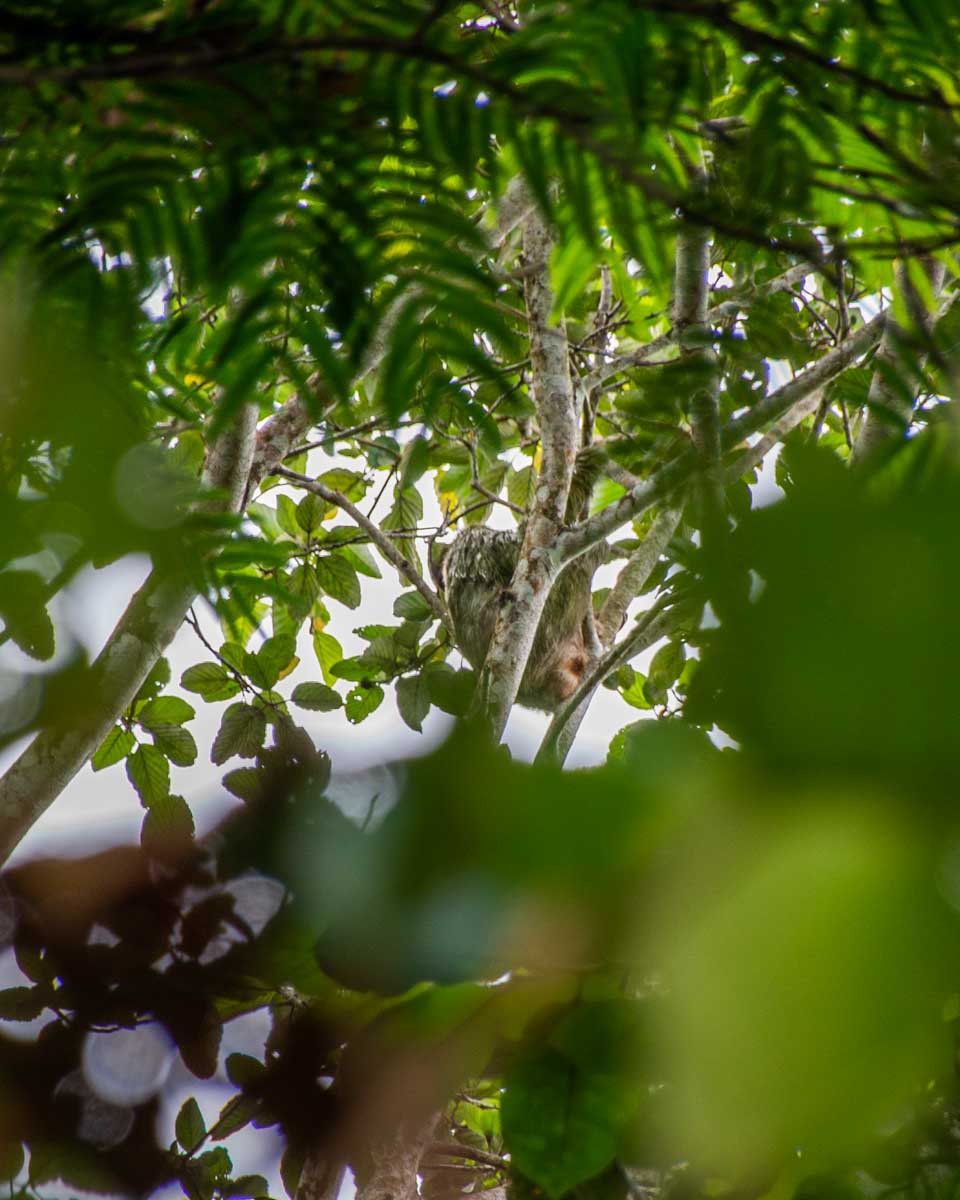
The Guanacaste province , including Tamarindo , Samara , Nosara , and Playa Hermosa do not have sloths living in them. Sloths do not like dry climates, so you can be assured that there are no sloths in this Pacific coastal area. Sloths live in the rainforest, so you should plan to go inland to naturally spot these furry animals.
While this area will not have you seeing sloths, there is lots of wildlife living in the area including a few different species of monkeys. While there are a few sanctuaries in the province, they are more focused on monkey rehabilitation and do not have sloths as this is not their natural climate. If you are wanting to see sloths, you will need to go inland towards Tenorio Volcano National Park, La Fortuna, and Monteverde where the climate is more humid.
Best Rescue Centers with Sloths in Costa Rica

Visiting ethical rescue centers in Costa Rica is a great way to support local wildlife. Rescue centers do amazing work within the country providing a temporary safe haven or permanent home to sick, injured, and orphaned animals in the region. Many rescue centers have sloths, and sometimes you might even see a bay!
Jaguar Rescue Center
The Jaguar Rescue Center is located just outside of Puerto Viejo along the southern Caribbean coast of Costa Rica. The Jaguar Rescue Center provides care and comfort for a wide range of animals including monkeys, birds, reptiles, and my favorite: sloths! You can choose between two separate tours: a public tour and a private tour. It is not possible for you to walk on your own through the rescue center for the safety of you and the animals.
The public tour costs $24 USD each. The tour takes an hour and a half to complete and starts at either 9:30 am or 11:30 am. If you are with a group or would like a private tour, these are available for $75 USD each with a 2 person minimum. The private tour is offered daily, rain or shine at 2 pm. Both tours allow kids under 10 to tour free of charge.

Alturas Wildlife Sanctuary
Alturas Wildlife Sanctuary is located 3.5 hours drive south of San Jose on the Pacific coast. This sanctuary in Costa Rica rescues, rehabilitates, and, whenever possible, releases animals back into the wild. They work with a wide range of birds, reptiles, and mammals including a two toed sloth.
Tours through the Alturas Wildlife Sanctuary are offered Tuesday to Sunday with the exception of Fridays being closed in low season. Tours take between 1-1.5 hours and start at 9 am, 11 am, and 1 pm. You need a guide to tour the sanctuary and reservations are required. Tours cost $33 USD for adults and $17 USD for kids 3-12 years old.
Rescate Wildlife Rescue Center
Rescate Wildlife Rescue Center is one of the most centrally located rescue centers sitting 29 km/18 miles northwest of downtown San Jose. This rescue center has a heroic history as in the 1960’s it was a private zoo that made its money off the exhibition of wildlife. The zoo was bought by a man in the late 1980s who had a goal of saving the animals and transforming this zoo into a wildlife sanctuary and rescue center that worked to help the animals rather than exploit them. Proof that one person can make a difference, this rescue center now works to help rescue and release animals back into the wild where they belong.
Rescate Wildlife Rescue Center is a non-profit center with large natural habitats for more than 800 rescued animals. Only 2% of the more than 2,700 animals this center rescues a year can unfortunately not be released back into the wild. Over 125 species of animals live here including sloths, jaguars, small cats, pumas, and many species of Costa Rican birds , mammals, and reptiles.
While you can rest assured that this is an ethical sanctuary, there are a lot of modern amenities like large parking lots, restaurants on site, souvenir shops, and food stands on site. There is even a mini farm with animals like miniature horses, donkeys, pigs, sheep, chickens, and rabbits that can be interacted with. Unlike other rescue centers in the area, you can tour the property at your own pace, unguided with adults costing $35 USD and children costing $15 USD.

Kids Saving the Rainforest Wildlife Rescue Center and Sanctuary
Kids Saving the Rainforest is a beautiful sanctuary is about a 3 hour drive south of San Jose nestled on the Pacific coast of Costa Rica. This refuge is home to more than 50 species of native wildlife including sloths, monkeys, birds, and more. You will learn not only about the animals that have been rescued but the sanctuary’s ongoing dedication to wildlife conservation projects.
You can expect tours to take about 1.5 hours and cost $60 USD for adults and $45 USD for kids 3-12 with children under 3 being free. Tours include a guide to take you through the area along with snacks and drinks.
Sloth Sanctuary of Costa Rica
The Sloth Sanctuary of Costa Rica sits on the Caribbean coast 20 miles/32 km north of the Jaguar Rescue Center. This is one of the best places to visit if seeing sloths is your focus. You will meet some of the 150+ injured, orphaned, and abandoned sloths that call this sanctuary home.
Tours are offered Tuesdays to Sundays, every hour between 8 am and 2 pm. Tours take 1 hour and cost $28 USD for 13+ and children 5-12 costing $15 USD with children under 4 being free. There is also a 2 hour Insider’s Tour offered that includes a “behind the scenes” tour through their nursery. There is a morning tour at 8:45 am and an afternoon tour at 12:45 pm with adults 19+ costing $150 USD, youth 6-18 costing $75 USD, and children under 5 being free.

Proyecto Asis Wildlife Rescue Center
Proyecto Asis Wildlife Rescue Center is located 67 miles/108 km from San Jose and a short 15 miles/24 km south of La Fortuna. Here you will see sloths, monkeys, snakes, squirrels, toucans, anteaters, and more. You can choose from a few different tour options at this rescue center.
The Wildlife Regular Tour takes 2 hours and costs $35 USD for adults and $20 USD for kids 5-9. If you’d like a little bit more of a hands-on opportunity, there is a wildlife tour + volunteer opportunity that takes 3.5 hours and gives you the opportunity to prepare food and toys for the animals. This tour costs $58 USD for adults and $35 USD for kids aged 5-9. Both tours require reservations and are available between Monday to Saturday at 8:30 am and 1:30 pm.
If your focus is on sloths, there is a Sloth Tour available as well that takes 1.5 hours and costs $25 USD for adults and $15 USD for kids 5-9. These tours are offered Monday to Saturday 8:30 am, 10:30 am, and 1:30 pm. There is also a one night homestay offered with a local family you can book to get the most authentic experience at this rescue center.
How to Spot a Sloth in a Tree
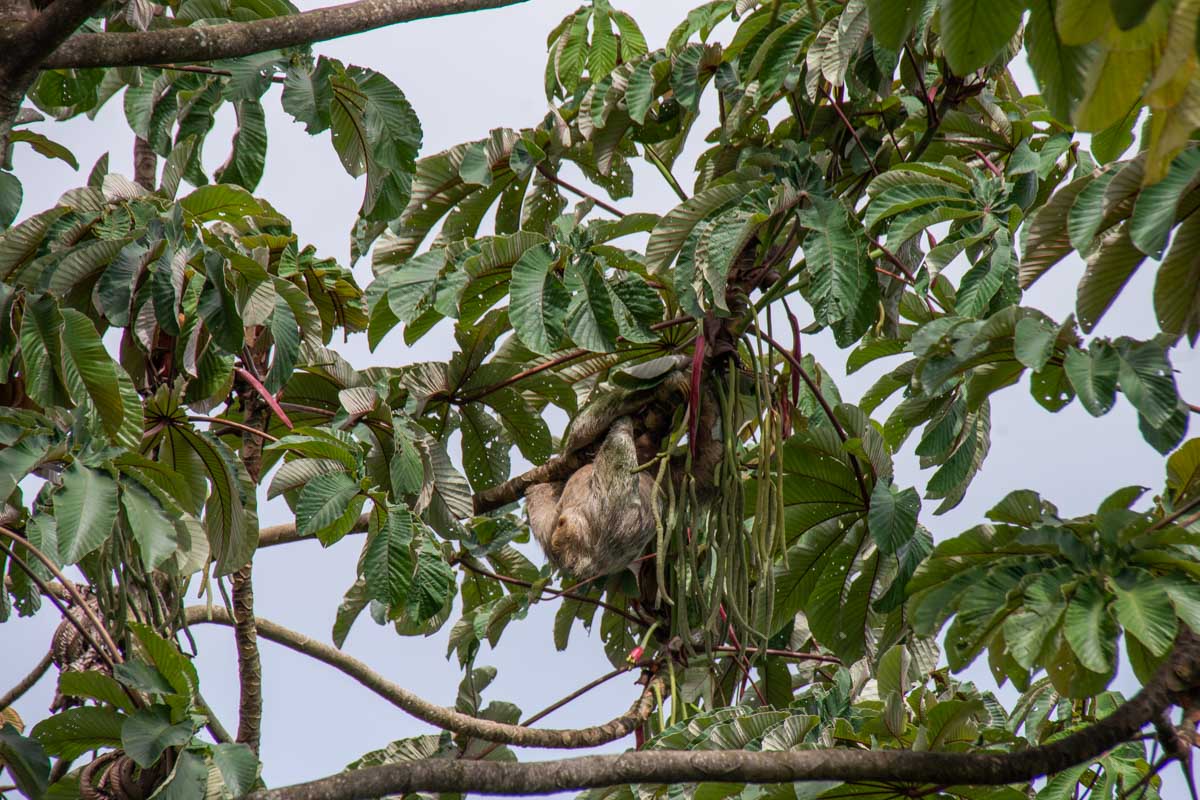
So you’re in the right area, now you just need to spot one of these lethargic creatures. Sloths are arboreal animals meaning they spend the majority of their life in trees. If you’re looking for your best shot to see these cute animals, be sure to look up, waaaay up!
In fact, sloths typically only come to the forest floor roughly once a week to poop before climbing back up to their preferred home in the treetops.
While sloths live in a variety of different trees, they’re naturally drawn to Cecropia trees. These trees grow fast and stretch up to 60ft/18m tall and have thin white trunks. These trees have large green leaves that fan out from the trees. The Cecropia tree grows a long yellow fruit that looks like string beans.
Sloths are solitary creatures which can make them harder to spot. They’re also expert camouflagers with their grey/brown color blending them with the treetrunks they spend most of their life in. They are often covered in a green algae/fungi mix that allows them to further blend with the forest canopy. For this reason, I highly recommend having a pair of binoculars on hand to help you see up these tall trees for sloths hiding in the treetops.
One of the best, most surefire ways to see a sloth is to hire a guide or book a tour. Guides are trained in the area and not only know which trees to look in and where sloths like to hang out, but they will come with binoculars to help you better spot these furry little creatures. If you want a guaranteed sloth sighting and are looking to do some good at the same time, visiting a sloth sanctuary in Costa Rica will guarantee you see one of these cute little critters.
The BEST Things to do in Costa Rica

While there are so many fun things to do in Costa Rica , a couple of specific attractions and activities stand out amongst the rest. They are:
Explore Volcanoes
There are some impressive (and beautiful!) volcanoes that you’ll want to check out while you’re here.
Poas Volcano is known for its bright blue crater lake. Poas Volcano is most commonly visited on a day trip from San Jose. This Poas Volcano tour from San Jose is one of the best you can do since it also includes a visit to the La Paz Waterfall Gardens as well as a coffee farm.
Arenal Volcano is also one of Costa Rica’s top attractions. Arenal Volcano is located closest to the town of La Fortuna. You can book this full-day tour from La Fortuna that takes you to the volcano to hike, the famous La Fortuna Waterfall and even a hanging bridge – it’s a full day of adventure!
Chase Waterfalls
La Fortuna Waterfall is one of our favorite waterfalls in all of Costa Rica. You can easily visit it on this full-day tour in La Fortuna that also visits hot springs.
Rio Celeste is another beautiful waterfall that is famous for its bright blue water. Rio Celeste is a popular attraction to visit from Guanacaste Province and this particular tour includes transport from there. Alternatively, you can book this tour from La Fortuna or this tour from San Jose .
See the wildlife
Costa Rica is the place for wildlife lovers! One of the best places to see lots of animals in their wild habitat is at Manuel Antonio National Park . With the help of a guide you will see plenty of birds, monkeys, and even sloths! This particular tour is super popular and also has amazing reviews, so you really can;t go wrong.
There are also lots of wildlife rescue centers around the country that are worth visiting. The Jaguar Rescue Center in Puerto Viejo is one of our favorites as well as Rescate Wildlife Rescue Center in San Jose where you can book this private tour.
Getting Around Costa Rica
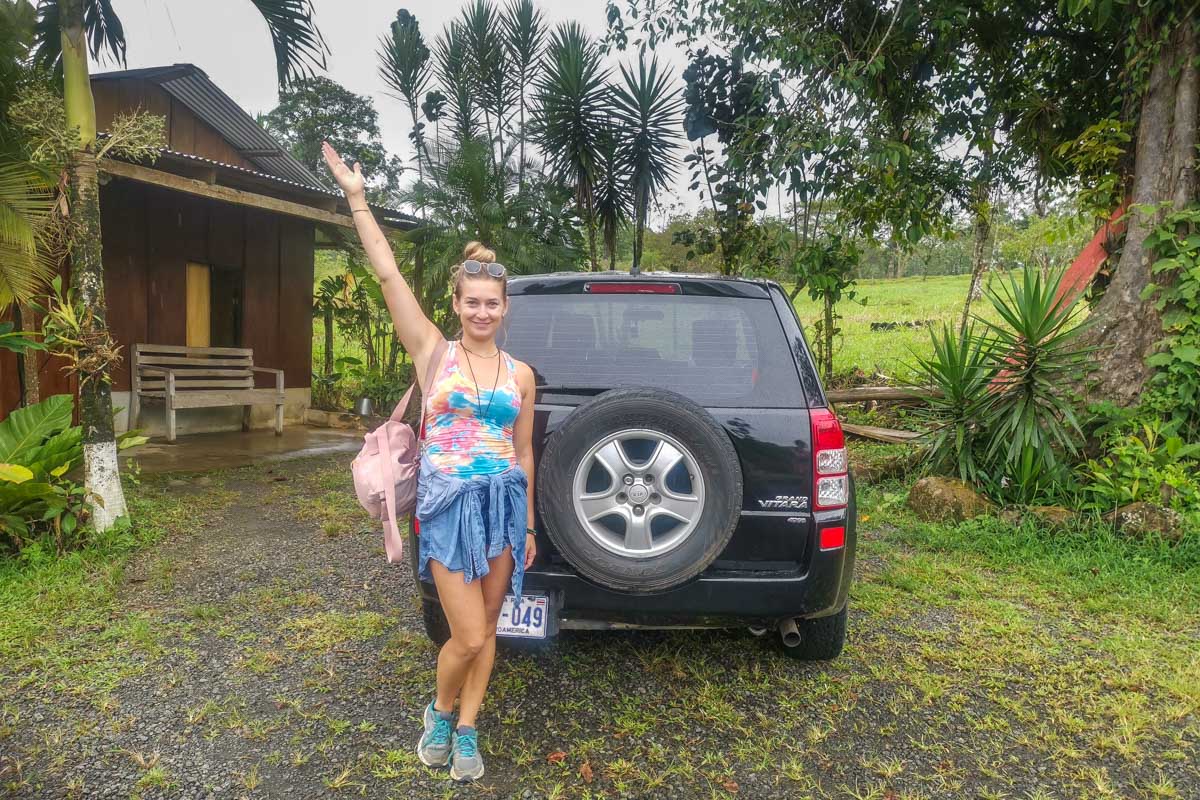
How you choose to get around Costa Rica is one of the biggest decisions you’ll make when planning your holiday here! How you do it depends on your budget, travel style, and comfort level.
Renting a Car
Without a doubt, the number one way to explore Costa Rica is in a rental car. We book rental cars on the Discover Cars website as we have had good experiences with them in the past.
One of the things you need to watch for when renting a car in Costa Rica is the mandatory insurance that the government requires you to have. There are a lot of very cheap rentals that don’t include this mandatory insurance (TPL) in the original booking price, but there are also ones that do. To avoid additional surprise charges when you pick up your rental car, be sure to rent a car that includes the mandatory insurance when you book.
Thankfully, on Discover Cars it’s easy to tell apart the companies that include the mandatory insurance and those that don’t. The trick is you can’t pick any car on their website. In the picture below, you can see this rental car, with pick up in Jaco, includes the TPL. That means the mandatory insurance is included in the price. Any cover you get above that is extra.
Of course, I still suggest getting the full coverage offered by Discover Cars, which covers you even more.
You can browse cars on Discover Cars here .

Book Shuttles
If renting a car isn’t in your budget, you don’t feel comfortable driving in Costa Rica , or you just don’t like driving, shuttles are the next best option. There are hundreds of shuttle routes available all over the country, and they are very affordable.
Shuttles in Costa Rica are specifically for tourists and often include pick up and drop off at your selected hotels and airports. The drivers also speak some English, and the vehicles have air conditioning. You’ll also be guaranteed a seat when you book a shuttle (which isn’t the case with the public bus system.)
To get the best price, use the website Bookaway . They compare all the offers and prices of shuttle companies in Costa Rica so you get the best price! Honestly, we have saved so much money using Bookaway!
You can search for shuttles online on Bookaway here.
Lastly, you can use the public bus system. On short journeys, such as from San Jose to La Fortuna or Uvita to Manuel Antonio, this system is great. However, the longer the journey the more hassle and time spent on a bus. It’s undoubtedly best to save the public bus in Costa Rica for short and straightforward trips!
The public buses are definitely the cheapest way to get around Costa Rica, but they are not always very reliable and schedules often change without notice and delays are to be expected. The buses can also be very crowded and hot – so just be prepared!
It’s also good to speak some Spanish if you plan on riding the public bus since most drivers and ticket booth operators don’t speak English.
Thanks for reading!
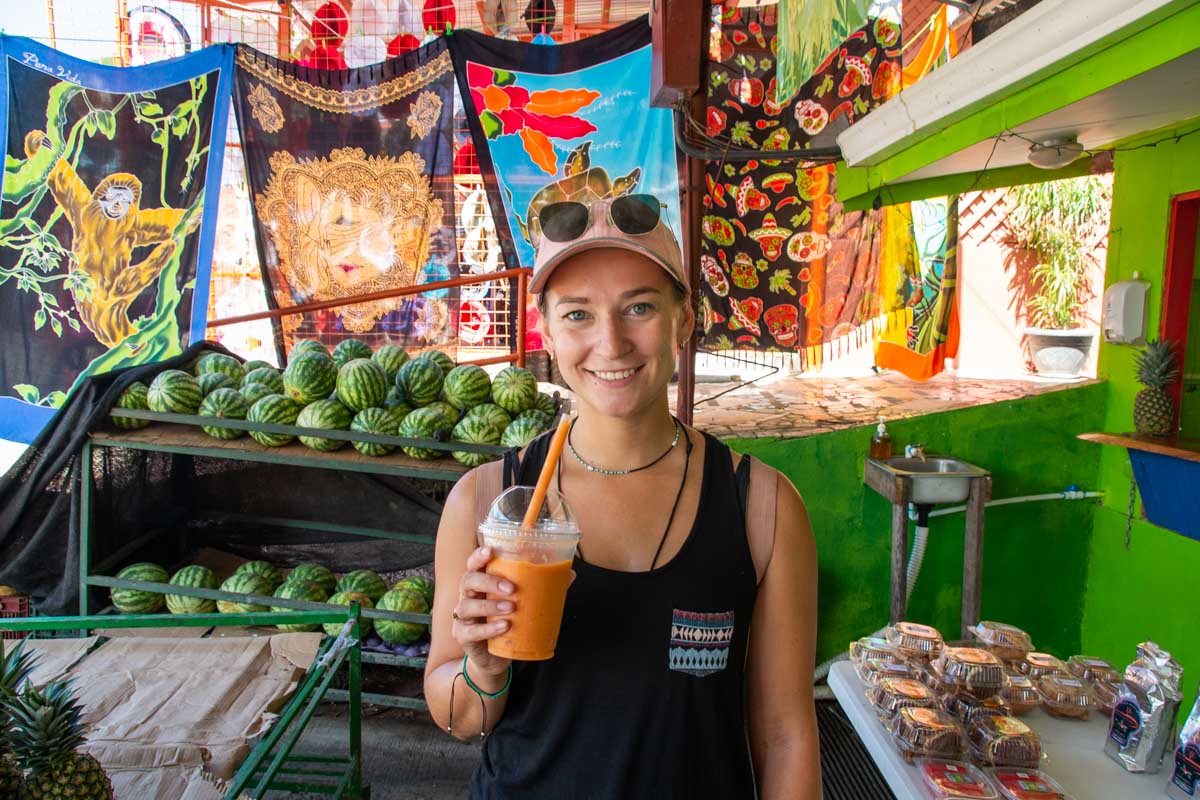
Sloths have become one of my favorite animals to see. It may be because they are hard to spot, but it feels like a real treat when you get to spot a sloth. We’ve been lucky enough to see quite a few different sloths when we were in Costa Rica, both in the wild and in sanctuaries. While nothing beats the thrill of seeing these animals out and about in their natural habitat, visiting a sloth sanctuary in Costa Rica helps to further their dedication to maintaining their natural healthy biodiversity.
I hope this blog helps you find sloths in Costa Rica! We’ve also written a ton of other blogs about visiting Costa Rica including a few of our favorite blogs below:
Things to do in Liberia, Costa Rica
Where to go surfing in Costa Rica
7-Day Costa Rica Itinerary
- Search Please fill out this field.
- Manage Your Subscription
- Give a Gift Subscription
- Sweepstakes
- Overview: Destination of the Year 2024 Cover Story T+L's Costa Rica
- 12 Reasons Why Costa Rica Is One of the Best Vacation Destinations in the World
- What to Know About Flying to Costa Rica, From How to Save to the Best Airlines and Routes
- The Best Time to Visit Costa Rica for Good Weather, Wildlife, and Affordable Prices
- Unlock Elevated Recommendations From a Costa Rica Travel Expert
- The Best Places to Buy a Vacation Home in Costa Rica, According to Experts
- This Costa Rican Region Is One of the Blue Zones Where People Live the Longest
- 9 Best Beaches in Costa Rica for Surfing, Snorkeling, and Wildlife Spotting
- How to See the Best of Costa Rica's Beautiful Rain Forests
- This Small Town in Costa Rica Is Home to Emerald Pools and Spectacular Waterfalls
- Costa Rica's Biggest City Is Full of Vibrant Art, Interesting Architecture, and Delicious Food
- This Laid-back Costa Rica Town Has Pristine Beaches, World-class Surfing, and Stunning Sunsets
- This Beach Town in Costa Rica Is One of the Country's Best-kept Secrets
- The 'Pacific Northwest of Costa Rica' Has Dramatic Mountain Landscapes and Adventures in Nature
- This Costa Rica Resort Town Is Home to a Popular National Park and Magical Monkey Forests
- Chartering a Superyacht Is the Newest — and Most Exclusive — Way to Explore Costa Rica
- 7 Costa Rica Experiences and Places Locals Love
- The Best Hot Springs in Costa Rica
5 Places to See Adorable Sloths in Costa Rica — and How to Have a Responsible Encounter
- How Celebrating My Son's First Birthday in Costa Rica Changed the Way I Think of Family Travel
- 20 Best Things to Do in Costa Rica
- This Peninsula in Costa Rica Has 15 Miles of Beaches — and Monkeys and Iguanas Roaming Freely
- Costa Rica's Eco-friendly Hotels Have Organic Gardens, Beachfront Pools, and National Park Views
- This Glamping Resort Gets Guests Access to Some of the Best Wildlife Experiences in Costa Rica
- 7 Beautiful Costa Rica Beach Resorts for Surfing, Swimming, and Sunbathing
- 14 Best Costa Rica All-inclusive Resorts
- This Stunning Costa Rican Resort Was Just Named One of the Best Hotels in the World
- How to Enjoy an Accessible Costa Rican Adventure — From Hotels and Tour Operators to Transportation
- Sustainable Fashion Is King in Costa Rica — These Are the Designers to Know
- Costa Rica's Indigenous Population Is Working to Save the Planet — and This Tour Is an Inside Peek
- Costa Rican Coffee Culture Is World Renowned — Here's the Best Way to Experience It
- Costa Rica's Afro-Caribbean Cuisine Is a Peek Into Its Past — and Its Future
- On This 174-mile Trek Across Costa Rica, Stay With Local Families and Learn Cultural Lessons
From the forest to the beach, here's where to spot these lovable, slow-moving creatures.
:max_bytes(150000):strip_icc():format(webp)/Stacey-Leasca-2000-631fabdcfe624115bea0ce8e25fdec96.jpg)
Manuel Antonio National Park
Tortuguero national park, corcovado national park, cahuita national park.
Costa Rica can be considered a paradise for many reasons. It’s home to more than 800 miles of coastline bordering the Atlantic Ocean and the Caribbean Sea, more than 50% of the country is made up of rainforests , and the entire nation is run almost entirely on renewable energy . But, perhaps best of all, it’s home to sloths. Lots and lots of sloths.
Costa Rica is home to two types of sloths — the Hoffmann’s two-toed sloth and the brown-throated sloth. And while there is a high chance you’ll see a sloth in the wild on your trip to Costa Rica, the Sloth Conservation Foundation notes that a precise population count can be challenging to nail down, as sloths are rather good at hiding in tree canopies.
Jess Macdonald/Travel + Leisure
Additionally, reps for the foundation explained that while they can’t give a specific number, it appears as though the sloth population is dwindling quickly in Costa Rica and across habitats in Central America and northern South America due to deforestation, human interaction, and slow breeding habits (sloths only reproduce once every three years). That’s why it’s extra important to view these animals at a safe distance, ensuring both their welfare and yours. And remember to book tours with reputable, ethical guides who will show you where they are without interfering with their daily lives. (You should never pet a sloth, or any other wild animal, so if a destination is offering that, please avoid giving them your business.)
Here’s where to look for the super slow, adorable creatures hovering in the trees around Costa Rica.
Kevin Schafer/Getty Images
Manuel Antonio National Park, along the Pacific coast, is a biodiversity hotspot thanks to its densely packed rainforest, making it one of the best places to spot sloths in Costa Rica. Guests can enjoy self-guided nature walks through its well-maintained trail system, or they can hop on a tour with a nature guide like Manuel on Airbnb Experiences . The park is also located close to popular beaches and hotels , making it a fantastic home base for your Costa Rican adventure.
On the other side of Costa Rica, along the Caribbean coast, travelers will find Tortuguero National Park, which offers a similarly dense forest habitat for sloths. Here travelers will also find a winding system of canals, upping their chances of seeing sloths in the water too (fun fact: sloths are excellent swimmers ), as well as endangered green turtles, giant leatherbacks, hawksbill, and loggerhead turtles. Visitors can again go on a self-guided hike, or explore by boat with one of its official tour guide operators .
webguzs/Getty Images
Corcovado National Park is well known as one of the most biodiverse places on the planet, making it a haven not just for sloths but also for monkeys, tapirs, ocelots, and plenty of pumas. Here, travelers can spot both the three-toed and two-toed sloths. However, due to the park’s massive size (163 square miles), it’s often recommended to stay more than one day to up your chances of seeing the slow-moving critters.
La Fortuna is home to Arenal Volcano, a towering volcano that is now lying dormant. While you may not be able to see the lava flow, you still have a great shot at spotting a few sloths living around it. There are plentiful eco-tours and guided nature walks available around the area, which will show you all the best flora and fauna, and take you to a few prime sloth-viewing locations. After the hike, travelers can stay in the area to relax in its hot springs to further unwind.
Juan Carlos Vindas/Getty Images
Make one more trip to the Caribbean Coast to visit Cahuita National Park to walk in the lush tropical rainforest and dip your toes in the azure waters all in one go. The serene environment is the perfect place for sloths to call home, as it’s not only a spot where they can find a great hiding spot, but come on, who doesn’t love beachfront real estate? Here, travelers can go on self-guided hikes through the park’s maintained trails and see if they can spot sloths hanging off the trees or climbing down the vines, or go on a guided tour that nearly ensures they spot at least one.

The Best Places to See Sloths in Costa Rica
Sloths are among Costa Rica’s most iconic animals.
Don’t just take my word for it. In recent years, Costa Rica’s TV advertising campaigns in the United States have featured anthropomorphic sloths doing everything from singing a cover of “The Lion Sleeps Tonight” to explaining why Costa Rica is one of the happiest countries in the world.

Sloths are plentiful in Costa Rica — they’re among the most common animals in the rainforest . But that doesn’t mean they’re easy to find. They are, after all, experts at camouflage.
Here are some tips on where and how to see sloths in Costa Rica.
What Type of Sloths Are in Costa Rica?
Costa Rica is home to two types of sloths: The Brown-throated sloth (a three-fingered sloth) and the Hoffman’s two-fingered sloth.
Note that while most people call sloths “two-toed” or “three-toed,” the reality is both species have three toes in their hind feet — it’s the digits on their arms that differ.
Costa Rica’s two-fingered sloths are nocturnal, while the three-fingered sloths are more active during the day. This can make the latter easier to spot. Three-fingered sloths are also more popular with wildlife spotters because their faces give them the appearance of an ever-present smile.
Hoffman’s two-fingered sloths have big, round eyes, pig-like noses, and thick fur that is usually brown or tan.
Two-fingered sloths’ nocturnal lifestyles and their less-happy-looking faces mean they’re sometimes ignored in favor of their more smiley sloth relatives, but both species are — at least in my opinion — equally fascinating.
Costa Rica’s Sloths: Habitat, Behavior and Fun Facts
Hoffman’s two-fingered sloths typically live in tropical forests below 10,000 feet of elevation. They prefer to stay hidden in the rainforest canopy in trees that receive sunlight.

The Brown-throated three-fingered sloths occupy a similar habitat, though they’re usually found closer to sea level where it’s warmer — on both Costa Rica’s Pacific and Caribbean coasts.
The sloth habitat comprises tropical rainforests, subtropical lowlands and semi-deciduous forests throughout much of Central America, including Costa Rica, and into South America.
Sloths are solitary and spend the majority of their lives either sleeping or moving slowly throughout the canopy. Like an owl, a sloth can turn its head up to 270 degrees — almost enough to look directly behind itself.
Though sloths usually prefer to remain hidden from predators — big cats and birds — by staying in the canopy, they do descend to firm land on occasion. The most common occurrence is when they defecate, which occurs just once a week. But sloths don’t remain at ground-level for long since their long claws make walking difficult.
Sloths are excellent fast swimmers, and this comes in handy when rivers create gaps in the forest canopy.
Finally, while sloths aren’t inherently dangerous, they are territorial and have been known to bite or slash if provoked. Sloths also maintain a symbiotic relationship with algae that grows in their fur — so it’s best to keep your distance!
Where to See Sloths in Costa Rica
Sloths live throughout Costa Rica, but unlike a bright-red macaw or chittering capuchin monkey, you probably won’t see one unless you’re specifically looking for them.
That said, some areas of Costa Rica are better than others to see sloths. Here are a few of the country’s most popular sloth-watching destinations:
- Manuel Antonio National Park: Wild animals are never a guarantee, but you’re virtually assured to see sloths (and monkeys) at Manuel Antonio , Costa Rica’s most popular national park.
- Corcovado National Park: All visitors to Costa Rica’s most biologically intense national park are required to enter with a guide. He or she will be on the lookout for the arboreal mammals among the flora and fauna.
- Tortuguero National Park: This hard-to-reach national park means it’s also a great place to see animals in their natural habitat.
- Cahuita National Park: Bordering the Caribbean Sea, Cahuita National Park has beach access and trails through the forest where sloths and monkeys are common to see.
For the best odds at seeing sloths, it’s best to hike with a guide. If you want to try your own luck, keep your eyes peeled for stationary balls of fur in the forest canopy.
Sloth Sanctuaries in Costa Rica
If you absolutely must see a sloth, visiting one of the many animal rescue centers in Costa Rica is a worthwhile option. (This is an especially good idea if you’re visiting Costa Rica with kids , who might not have the patience for long walks through the jungle!) The entrance fees help support the care and rehabilitation of animals so they can be released back into the wild.
And, you’re virtually guaranteed to see and learn about Costa Rica’s sloths.

Here are some popular reserves and rescue centers where you can see a sloth in Costa Rica:
- Sloth Sanctuary of Costa Rica (near Cahuita, Limón ): Founded in 1992, this is Costa Rica’s original sloth sanctuary.
- Toucan Rescue Ranch (near San Isidro, Heredia ): Just north of San José, Toucan Rescue Ranch is among the most respected names in animal rehabilitation and release.
- La Paz Waterfall Gardens (on Poás Volcano ): Among the most popular private reserves in Costa Rica, La Paz houses many animals — including sloths — as part of its many attractions.
Holding a Sloth in Costa Rica
As a country with nearly 30% of its land allocated to national parks, reserves or refuges, it’s no secret Costa Rica takes environmental protection seriously.
In 2019, Costa Rica made it illegal to take a selfie with a wild animal. Despite their tranquil appearance, handling a sloth can cause it physical and emotional harm. Just like humans, sloths don’t like hugs from strangers, so please keep a respectful distance from sloths and other wild animals!
Costa Rica’s Environment Ministry also forbids guests at animal sanctuaries from handling sloths.
If you suspect a tour operator or sanctuary in Costa Rica is breaking the law, you can file an anonymous report with the Environment Ministry online at the SITADA website . Thank you for helping to keep Costa Rica’s wildlife truly wild!
Even if you’re not physically close to a sloth, it’s relatively easy to take a high-quality photo of one because they stay so still. Rainforest guides usually carry telescopes and will help you snap a memorable photo.
If all else fails, Juan Santamaría International Airport near San José has a stuffed sloth photo booth after the security checkpoint as part of Costa Rica’s #StopAnimalSelfies campaign.
Remember, while Costa Rica’s sloths aren’t endangered, they are threatened by deforestation and human interference. You can help make a difference by being a responsible tourist.
Summary: Sloths in Costa Rica
While you may not sob tears of joy when you see a sloth ( a la Kristen Bell ), the adorable mammals are at the top of many tourists’ wish lists when they visit Costa Rica.
Thankfully, no matter what region of Costa Rica you explore, you have a good chance at seeing at least one of the country’s most iconic animals. Sloths are prevalent in the Costa Rican wilderness, virtually everyone loves finding one, and there are many organizations dedicated to protecting Costa Rica’s two endemic species.
Just remember — if you see a sloth, keep a respectful and safe distance. And Kristen Bell, if you’re reading this, please try to keep it together.
Ready to plan your trip to Costa Rica? Contact us to get started!
- Name: * First Name: Last Name:
- Your Message: Please tell us how we can help you plan a trip to Costa Rica. Our trips start at $1,725 per adult, which includes your lodging, in-country transportation, and many of your activities and meals.
- Comments This field is for validation purposes and should be left unchanged.

John Rabenau has been working in the eco-tourism & adventure travel industry in Costa Rica since 2002. He has worked in a variety of capacities from Outdoor Educator & Principle Guide to Itinerary Design Manager & Business Owner for numerous organizations. He has grown Costa Rica Escapes into one of the most reputable Costa Rica travel agencies since its creation in 2006, hosting more than 5,000 people with custom vacation itineraries.
Mobile Lead Form
Want help planning a trip.
- Name: * First Name:
- Your Message: *
- Email This field is for validation purposes and should be left unchanged.
Complete guide on how & where to see Sloths in Costa Rica
Home Blog Complete guide on how & where to see Sloths in Costa Rica
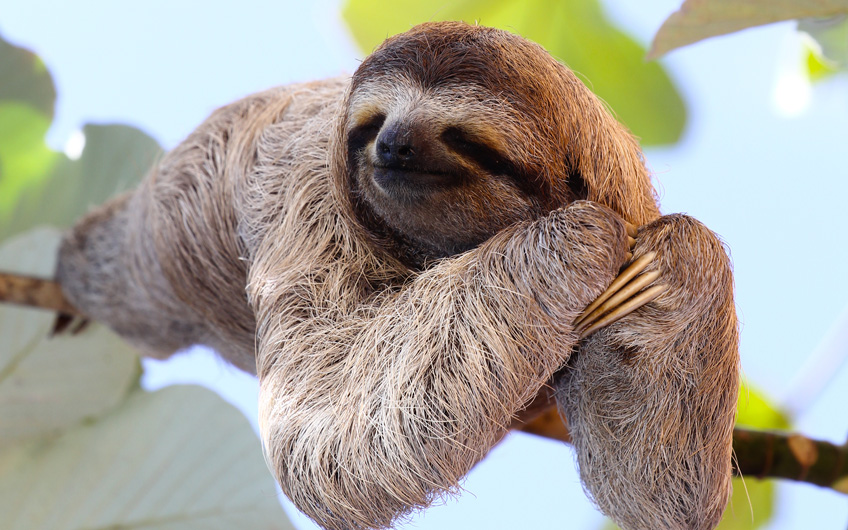
Sloths in Costa Rica are an even more growing target for visitors looking to get close to them. Their smiling faces and funny laziness are two of the reasons why people love them and look for them during their holidays in the country. Their popularity is growing on social media and if you do not want to see them through a virtual screen or only in a post then you can consider a trip to this tropical place where they happily live.
But do you know what is a sloth? If not, then you have to read this to get a better idea of what are these comic creatures and what are their main characteristics.
First of all, you may know that Costa Rica is an excellent place to spot sloths in their natural ambiance , as the country has the 5% of the world’s biodiversity and there are a lot of places where you can be so close of the natural sloth habitat, and this results very attractive for both, locals and foreigners.
Their natural habitat is the forest, the trees specifically, where they hang out high while sleeping for about 20 hours a day. Yes, you read it right! They sleep for approximately 20 hours during the day. So, probably, when you spot one, or various of them, they will be surely taking a long nap. Sometimes you will be lucky enough to see them outlining a smile for your camera. The forests here are varied, as they can be cloud forests like in Monteverde, or dry forests as it occurs in Guanacaste. In some areas near Costa Rica all inclusive resorts , you might even get the chance to spot these sloths in their natural habitat..
Their name has something to do with this to: they move so slowly that they have a kind of algae growing on their fur, but this is not as bad as it sounds: having the fur this way serves as camouflage from the predators. Not only for their color, but also for their thick fur.
These animals are well adapted to live in the forest, as they spend almost their whole life hanging on a tree. But, this kind of living saves them from their natural predators; as well as their fur does. None wants to eat a thick furry mass! Definitely, they are charming, but not for predators…
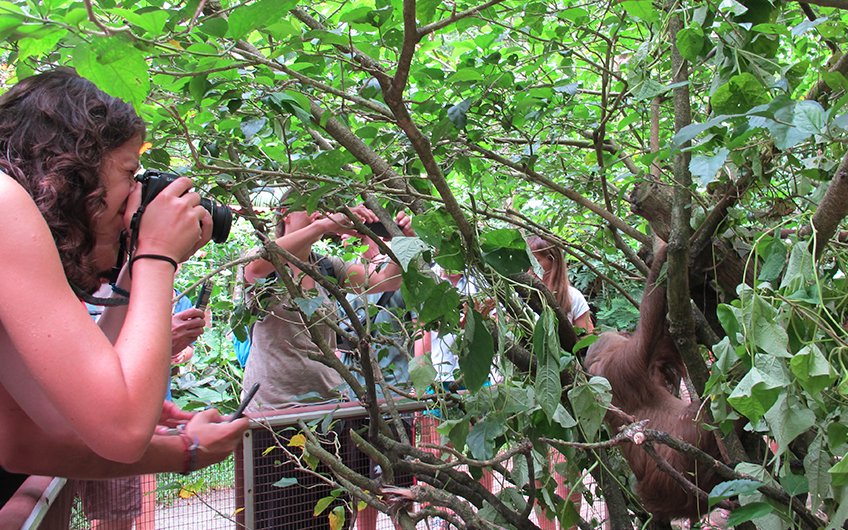
In Costa Rica it is possible to find two species out of the six that already exist in the world . There are two types of sloths: the two-toed sloths and the three-toed ones. The species that can be found in our country are the Hoffman’s two-toed sloths which have two toes on the front feet and three toes on the back feet, and it is very common to watch them hanging in an upside-down position from the high branches during their daily nap. Its scientific name is Choloepus Hoffmanni.
This species of sloth is nocturnal and this makes it much more difficult to find during a tour. But, if you are lucky enough to find them during the day, be sure that these little creatures will be probably (and almost surely) be napping.
The other species that can be seen in Costa Rica is the Brown-throated Sloth or the Bradypus Variegatus, for its scientific name. This is the most common three-toed sloth in the world and it is a diurnal animal. Regarding their physical appearance, you must know that they are a little bit smaller in size than the Hoffman’s sloth and also, other characteristic is that they are quiet more active than the other ones.
Despite there are actually six species of sloths in the world, two of them are endangered. The Costa Rica sloths are not in danger but other species such as the Brazilian and the Pygmy sloth of neighbour country, Panama, are actually endangered.
Here, the sloth sanctuary Costa Rica makes great efforts in order to keep these animals safe and provide a great sloth rescue process for the ones that have been in any kind of danger, or the ones that have lost their mother or something similar. The sanctuaries provide the protection, healthcare and other cares that they need, in order to preserve the species and keep them safe.
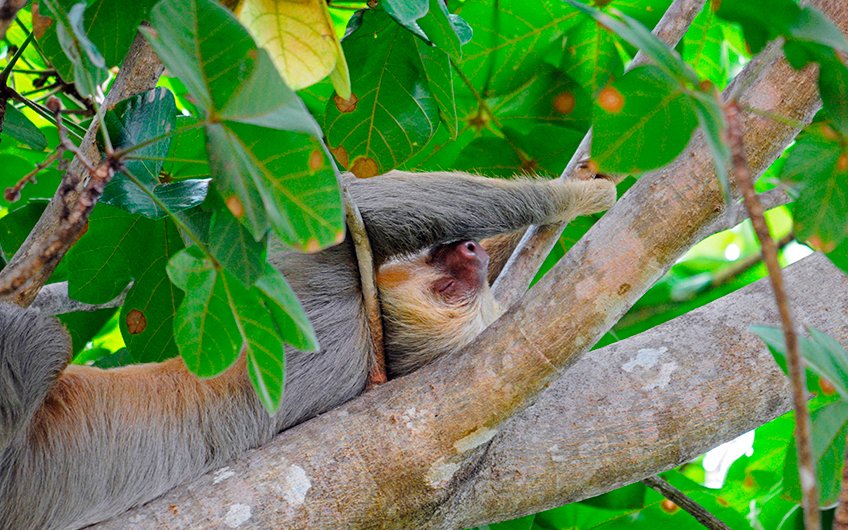
It is very common that nature and animal lovers, and visitors of all kinds seek to be a sloth sanctuary volunteer and help their preservation through their work. This is a great experience that you can also live during your Costa Rica vacations, doing good is always rewarding and working with these smiling creatures will surely fulfill your spirit! In the country it is possible to find different animal rescue centers of different species, if you want to offer your time as a volunteer.
Here you can learn a lot about them, help and donate your time or money to improve their life quality and, of course, take a lot of sloth pictures for your lifetime memories.
Now, getting back into the curious information about them, you probably are wondering why they are so slow. Well, you need to know that their slow movements occur because of the fact that they have the slowest digestion system among all the mammals.
Studies show that they require almost two weeks to fully digest a meal. Can you believe that! That is why, during their evolution process, their digestive system and their whole organism have evolved in order to keep energy. They evolved in order to do less, rather than to eat more. This is the main reason of their 20-hour naps. Curious, isn’t?
Their food consists mostly in branches, leaves (their favorite ones are the ones of the cecropia trees), buds, and sometimes different insects. They are not predators, and almost in the same way, they have no much predators either. The main danger for them are the wildcats and the harpy eagles, but their few movements and their color that supports their camouflage make them a prey difficult to find.
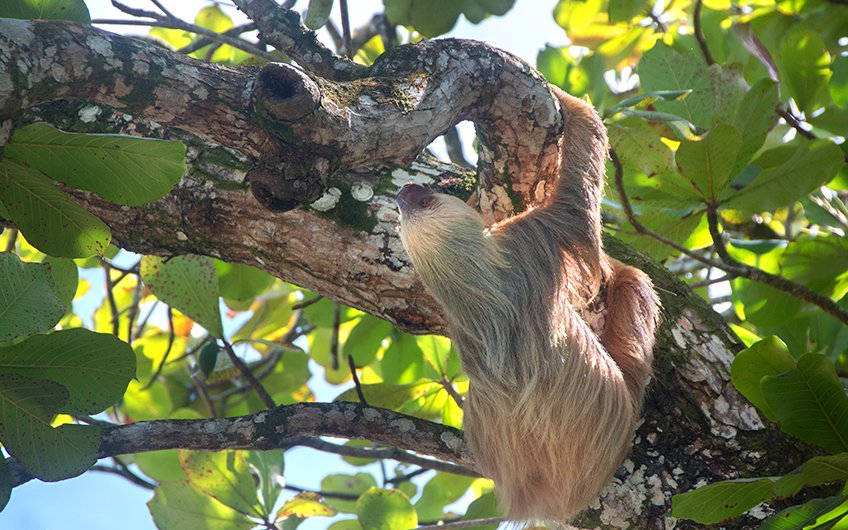
Now, you can find as follows some interesting sloth Costa Rica facts:
- Despite its laziness, the sloths are amazing swimmers. Hard to believe, but it is truth!
- The sloths are related to armadillos and anteaters.
- The wild sloth can live up to 12 years.
- The sloths have a quarter of the muscle mass of other animals of their same size.
- The main differentiation between the two Costa Rica sloth species is their coloration. Three-toed tend to be color gray with a white happy face, while two-toed sloths tend to be beiger to brown.
- The three-toed sloths possess an extra cervical that allows them to turn their head 270 degrees. Amazing, right?
- Sloths are some of the most common Costa Rica animals (mammals) of the rainforest.
- Scientists estimate that sloths make up more than a half of the rainforest’s biomass in the South and Central America.
- Believe it or not, the sloths risk their lives to poop. Once a week they descend from their branches to poop and here it is when they risk their life, as being exposed in the ground. The reason why they do that is still a mystery for biologists.
- Sloths can spend the 90% of their lives in an upside-down position.
- Their fur works as an ecosystem as it supports different colonies of algae and moths. Researchers think, and are even more convinced, that they maintain these mini-habitats in their fur with its own feces. It may be one reason for their decision to descend from the trees to poop.
- For them, it can take up to 30 days to completely digest one leaf and they never eat too many leaves from the same tree in order to avoid poisoning themselves.
- The fungus in their fur can cure cancer, according to recent investigations.
- Where are sloths found in Costa Rica? Almost in every region it is possible to spot sloths. Just take a look!
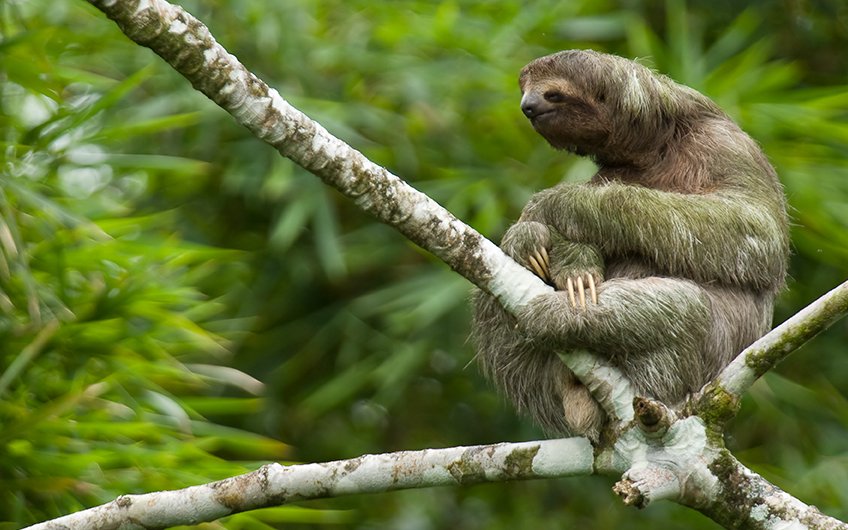
Where to see sloths in Costa Rica
Here we give you some places to consider when looking for a Costa Rica vacation package if you really want to see sloth animals.
You can visit one of the most beautiful beaches of Costa Rica in order to see sloths. Located in the Central Pacific, Manuel Antonio beach is an excellent spot for sloths . Here you can find both types of sloths.
Monteverde Cloud Forest is a place that boasts 2.5% of the world’s biodiversity … just imagine it! Within the lush vegetation you will surely find the opportunity of seeing these nice creatures.
The Corcovado National Park which is located on the southwest region of Costa Rica , specifically in the Osa Peninsula which is a biologically rich part of the country. The area contains 13 major ecosystems, so you definitely will have the chance to spot more than one of them during your vacation in Costa Rica.
La Selva Biological Station is located in Sarapiquí and it is a protected zone operated by the Organization for Tropical Studies (OTS) and here it is possible to find sloths in their natural ambiance.
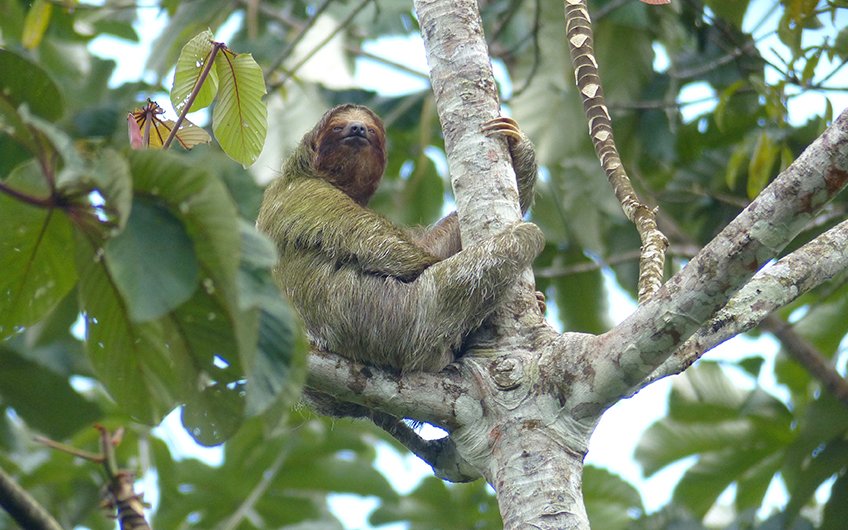
Tortuguero with its canals , is a truly majestic and one of the best places to enjoy the wonders of nature . Then, you will see sloths here during the morning or the afternoon when taking the ecological boat tours offered by the different hotels and lodges of the area. And, if you have enough luck, probably you can see one of them swimming in the canals.
Arenal is the famous region located in La Fortuna , is a great spot to see this kind of wildlife during a morning hike or while enjoying your free time in the hotel or the surroundings. You will be amazed by the landscape and the opportunity to see monkeys, different birds , and of course, sloths.
There are a lot more of places where you can find sloths. Just to give you an idea, in the installations of the University of Costa Rica (UCR) many students and teachers have been able to see and be in close contact with these animals. And the UCR is located in San Jose , the middle of the city!
We want you to have an unforgettable experience while traveling in Costa Rica, that is why we are going to give you some recommendations if you really want to see sloths.
- It is preferable to go with a guide or local that knows the area.
- Use neutral colors in your clothing.
- Be patient and always aware.
- Bring binoculars and good camera.
Costa Rica Travel Guides
- Costa Rica White Water Rafting River Tours
- Costa Rica Scuba Diving
- A Complete Guide: How to plan your Costa Rica Wedding
- Driving distances in Costa Rica
- Costa Rica Golf Vacation Packages All Inclusive
- Costa Rica Canopy Tours
- Costa Rica Sports Fishing Vacations Guide
- Costa Rica Surfing Guide
- Costa Rica Honeymoon: Expert Tips, Destinations, Resorts & Vacation Packages
- Bird Watching in Costa Rica
- Costa Rica Ecotourism
Costa Rica Vacations Packages
- Costa Rica Birdwatching Tour
- Costa Rica Golf Experience
- Honeymoon Getaway
- Romantic Holiday
- Family Expedition
- Costa Rica Family Break
- Family Holiday
- Luxe Adventure
- Secrets of Costa Rica
- Costa Rica Beach All-Inclusive Stay Vacation Trip
- Costa Rica: Scuba Diving in the Gulf of Papagayo, Guanacaste
- Deluxe Adventure in Costa Rica
- Costa Rica 4×4 Adventure Ride
- Classic Costa Rica
- Costa Rica Volcano, Mountain and Beach Vacation Trip
- Costa Rica: A Bit of Everything Vacation Trip
Arrival date
Departure date
Your comments
Call us and talk to our travel experts
We are active members of the most important tourist associations , both national and international.
To navigate this site use a different one than Microsoft Explorer.
We use cookies to offer you the best experience on our site. Continue browsing if you are happy or check more information about our protection and privacy policy. .

The Best Ways to See Sloths in Costa Rica
Disclaimer: This article may contain affiliate links. Clicking on them may earn Costa Rica Vibes a commission, at no extra cost to you. Thank you for your support!

Have you ever seen a sloth in real life? If not, I promise you they are as cute, unique, and fascinating as you imagine. Sloths in Costa Rica can be spotted all over the country in the wild as well as at wildlife rescue centers.
We created this guide to give you all the info your need in order to guarantee you see at least one sloth during your travel in Costa Rica.
Plus, we included tons of sloth pictures….because who doesn’t love sloth pics?!?!
Types of Sloths in Costa Rica
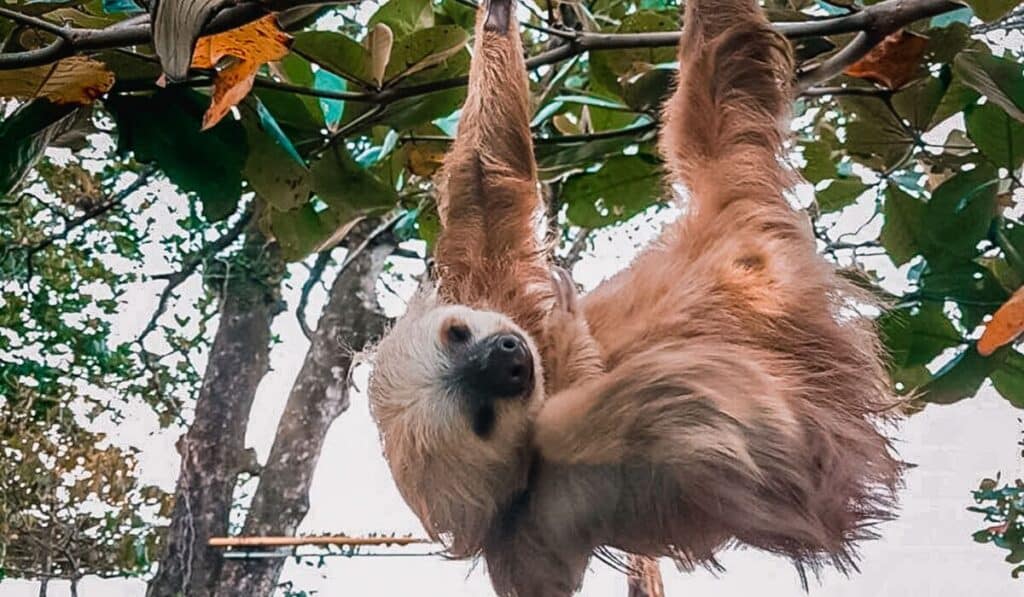
There are two types of sloths. These are the two-toed and three-toed sloths. In Costa Rica, you can find two species of sloths. These are Hoffman’s two-toed sloths and the Brown-throated sloth (a three-toed sloth).
Hoffman’s Two-Toed Sloths
These sloths have two toes on their front feet and three toes on their back feet. They are nocturnal, so if you see them they will most likely be sleeping.
Brown-Throated Sloths
This three-toed sloth is the most common sloth in the world. They are much more active than the Hoffman’s two-toed (but still fairly inactive in comparison with most other animals).
They are not nocturnal, so you might get lucky and see them moving about. However, they typically sleep between 15 and 18 hours per day.
As an adult, they typically weigh between five and 14 pounds.
Fun Costa Rica Sloth Facts
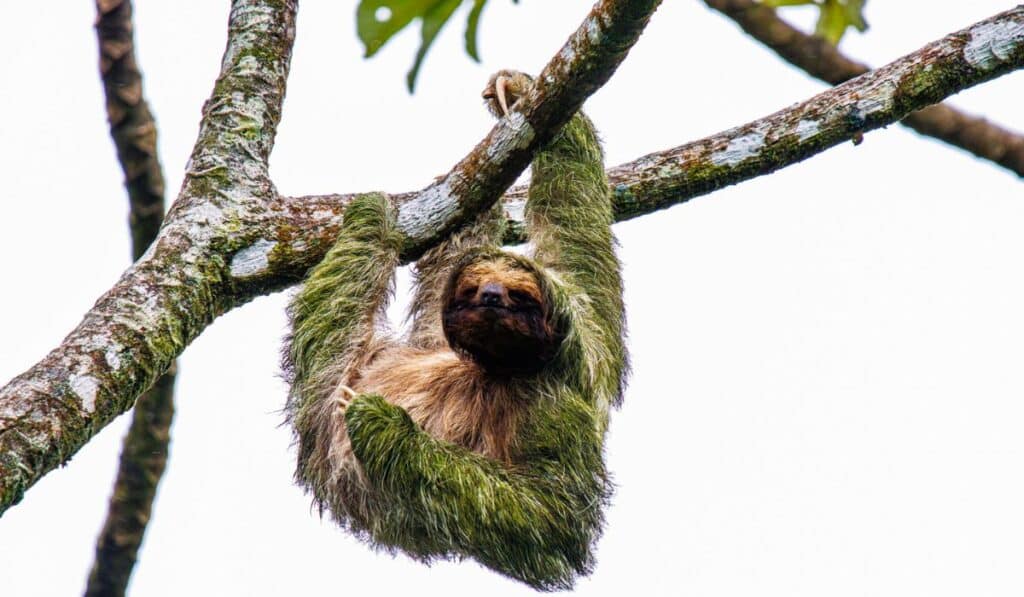
– Sloths have a life span of about 30 years old in the wild
– Sloths typically make their way to the ground once a week to defecate
– Baby sloths are born with full long claws
– The fur of a sloth provides an entire ecosystem for various bugs, fungai, and algae. The sloth we took a picture of above is helping to grow some serious algae or moss!
– They eat leaves, branches, and some insects. The cecropia tree leaves are their favorite. so, look for them in those trees.
– It takes them almost two weeks to digest one meal
Best Places to See Sloths in Costa Rica
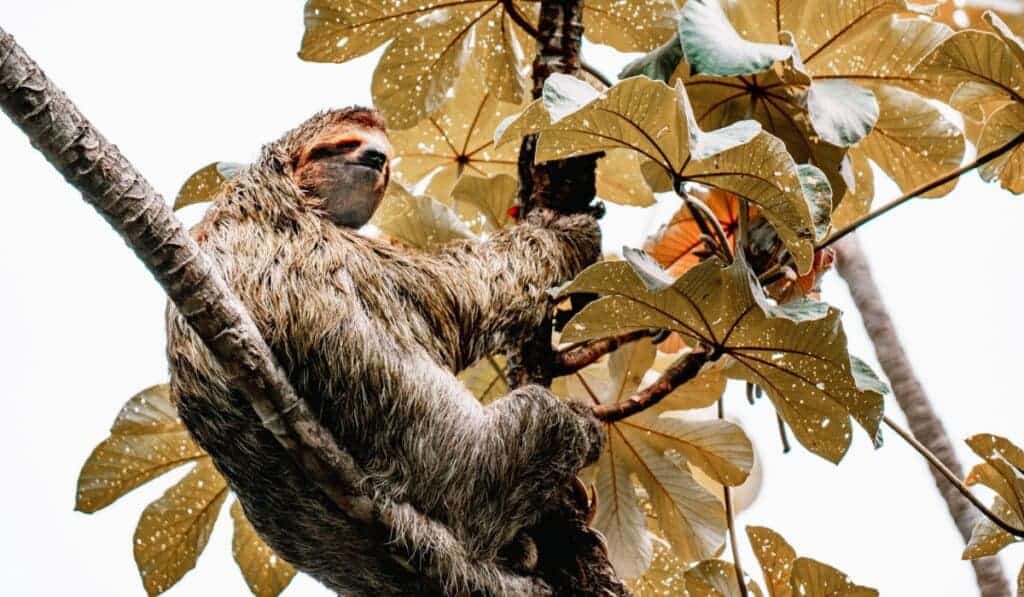
You can usually see sloths anywhere in the country if you look hard enough. However, you will have the best luck the further south you get, due to a higher concentration of them.
A few of our favorite spots for spotting these cute creatures are.
We have seen a sloth chilling in the trees on Playa Negra here a few times. And it is usually close to the ground and happy to pose for photos.
Also, you will likely see sloths in the Cahuita National Park . If you want to guarantee that you will see them, hire a guide.
Manuel Antonio
The Manuel Antonio National Park is a great place to see TONS of wildlife including sloths. They are typically high up in the trees relaxing.
You can just show up at the park and hire a guide, but if you would like a tour with transportation we highly suggest an all inclusive tour with Manuel .
Corcovado Area
Corcovado National Park is located in a remote area of Costa Rica called the Osa Peninsula. To visit this park you need to enter with a certified naturalist guide.
Travel Tip: We suggest bringing a pair of pocket binoculars with you on your trip to Costa Rica. They take up almost no space in your suitcase and are great for spotting hard-to-see wildlife.
Although these are the places we have seen the most sloths, it doesn’t mean you won’t see one in other parts of the country.
The problem is that usually, they are so high up in the trees and so inactive that you won’t even spot them. They just look like little furry dots in the trees.
This is when it is a good idea to hire a guide. So, let’s talk about that….
Wildlife Tours to See Sloths
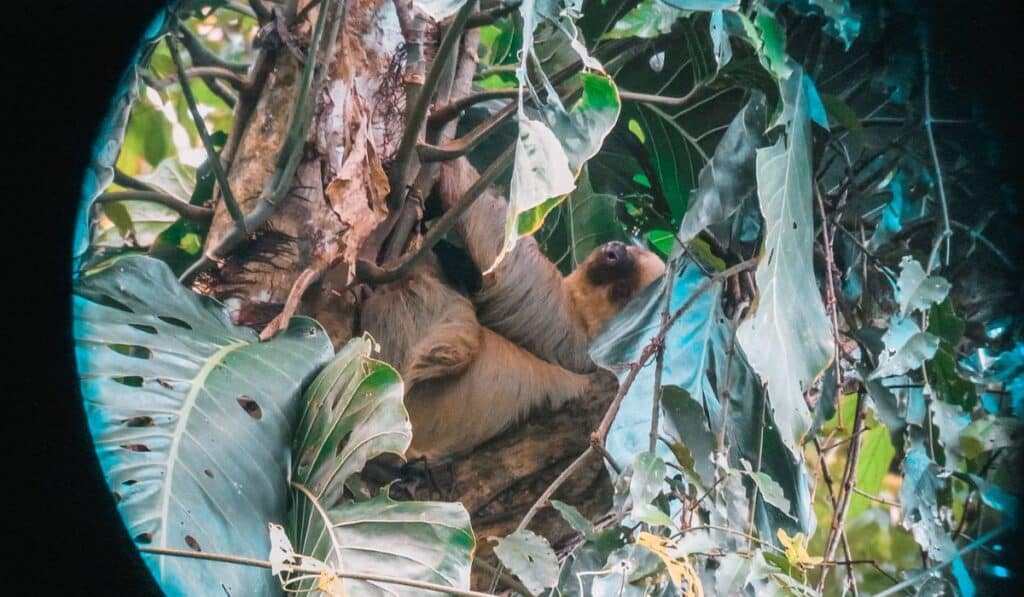
When you visit national parks in Costa Rica it is sometimes possible to hire an experienced wildlife guide to walk you through the park.
Your guide will carry a large telescopic lens. This is so helpful when spotting sloths because usually, they are hiding high up in the trees. You can then use your phone to get a close-up picture through the lens like the image above.
Usually, the guide will be very knowledgeable about the wildlife in the area. Plus, they do these tours almost every day so, they know exactly where the animals hang out.
Protecting Sloths in Costa Rica
Please never touch a sloth (unless you are rescuing it). This can be very scary for them and causes their heart rate to rapidly increase which can lead to early death.
Plus, you can damage the ecosystem in their fur.
We have never seen this, but have heard of people setting up roadside stands with an offer to hold a sloth for pictures. Usually, these people have taken a young sloth from their mother and are using them to gain profits.
Please don’t participate in this. In fact, if you see this, try to take a photo of the person and immediately call the police (911). The police take wildlife protection very seriously and will respond.
Sloth Sanctuaries in Costa Rica
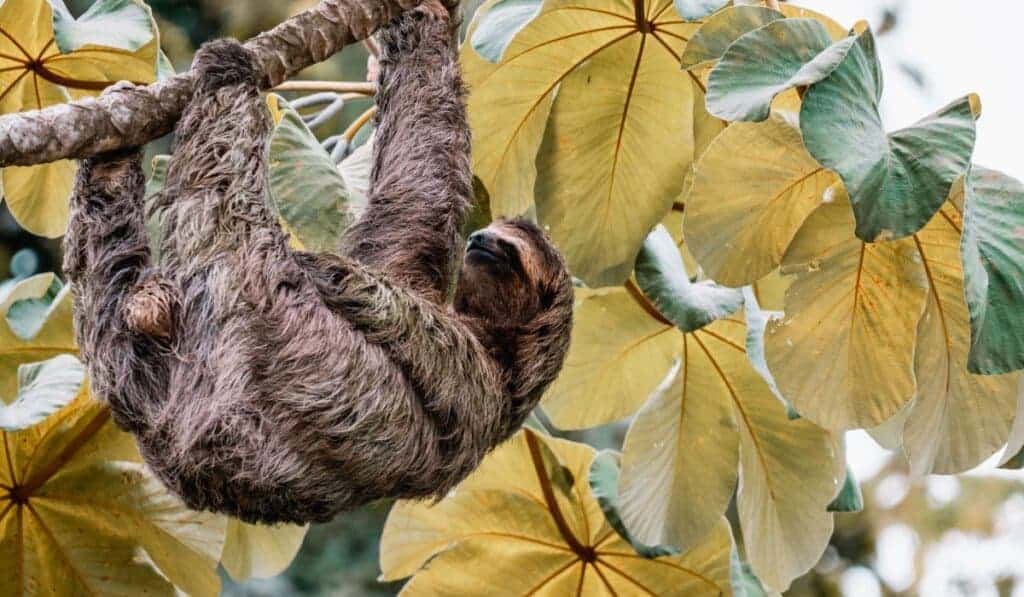
There are multiple sloth rescue centers located throughout the country. These places are typically non-profit facilities which rehabilitate wildlife after they are hit by car, attacked by other wildlife etc.
Unfortunately, because sloths are so slow-moving, they occasionally get hit by cars when coming down from the trees once a week.
Also, occasionally people will take in sloths and other wildlife as pets. When they are confiscated by the Costa Rican Wildlife Ministry they are often released to the care of one of the following facilities. Usually they can then not be rereleased back into the wild because they have been too domesticated.
I tried to only include facilities in this list that have a good reputation and are actually rehabilitating wildlife. However, there is some controversy about some of these places. Some issues I have heard about include:
– Caged in habitats seem too small.
– It is sometimes questionable when they charge high admission fees, how much of that profit is going to the animals?
– And are they really releasing the wildlife when they are rehabilitated or are they keeping them to continue making a profit off of them?
These are things you need to decide for yourself. I can’t really comment on it due to not knowing enough about them.
La Paz Waterfall Garden
La Paz Waterfall Gardens is located about an hour from the San Jose International Airport near Poas Volcano.
This place is a popular destination for families because you can see tons of wildlife, visit an impressive waterfall, and learn about Costa Rican culture all in a condensed area.
⤷ Book Your Tickets to La Paz Waterfall Garden
Rescate Wildlife Rescue Center
This facility is located in Alajuela and is just a short drive from the San Jose International Airport.
This is a great place for people of all ages. It is easy to walk through and you can see tons of different wildlife being rehabilitated.
It is possible to visit here as a day trip or volunteer for an extended period of time.
⤷ Plan Your Visit to Rescate Wildlife Rescue Center
Kids Saving the Rainforest
Located in the hills above Quepos , this place has over 50 species of rescued animals. It is possible to visit here as a day tour, volunteer for a day, or volunteer for an extended period of time.
⤷ Plan Your Visit to Kids Saving the Rainforest
Sloth Institute
A non-profit facility located in Manuel Antonio. One project of theirs which I really like is that they are working to install rope crossing bridges over roads to help sloths cross.
It is not possible to visit the Sloth Institute, but you can check out their site for volunteer programs or if you are interested in donating to support their efforts.
⤷ Plan Your Visit to the Sloth Institute
Sloth Sanctuary
The Sloth Sanctuary is located on the Caribbean coast just outside of Cahuita. They offer two tour options including one in which you can visit their sloth NICU/ Nursery. This is probably the most well-known sloth rescue center in the country.
⤷ Plan Your Visit to Sloth Sanctuary
Jaguar Rescue Center
The Jaguar Rescue Center is located near Puerto Viejo on the Caribbean Coast. It is possible to visit here as a group or private tour. You can see a variety of rescued wildlife here.
⤷ Plan Your Visit to Jaguar Rescue Center
FAQ: Sloths in Costa Rica
What part of costa rica has the most sloths.
Sloths can be found around the country. The more concentrated areas of sloths tend to be on the Caribbean coast, Central Pacific, and South Pacific areas.
Which sloths live in Costa Rica?
In Costa Rica, you can find two species of sloths. These are Hoffman’s two-toed sloths and the Brown-throated sloth (a three-toed sloth).
Where can I hold a sloth in Costa Rica?
Some rescue centers may allow you to hold a sloth. That being said, this is not an activity you should participate in. Being held by humans can be very traumatic for the animals and the oils from your skin are not good for them.
Are there sloths in Costa Rica?
Yes, there are two-toed and three toes sloths in Costa Rica. These sloths can be found all over the country.
In conclusion, Costa Rica offers a magnificent opportunity for tourists to witness the fascinating world of two and three-toed sloths.
Remember to always be patient, observant, and respectful of their space.
So pack your binoculars, put on your hiking boots, and get ready for an unforgettable journey into the realm of the sloths in Costa Rica!
And that is all for sloths in Costa Rica. If you have any questions, just leave them in the comment section below. We are always happy to help you out!
You Might Also Like:
Wildlife in Costa Rica – See All the Most Exotic Animals
Cahuita national park in costa rica: the best visitors guide, manuel antonio national park: a full visitor guide, birds of costa rica: the most unique and where to see them, monkeys in costa rica: how to see them up close.
Costa Rica Travel Details : What You Need to Know
🚗 Should I rent a car in Costa Rica?
Having a rental car will give you the most flexibility when traveling in Costa Rica. This will also allow you to take fun day trips on your own.
- Save 10% Plus Other Perks with Our Adobe Rental Car Discount
- You might also consider; shared shuttle services or private transfer services
🏄🏽 How can I book things to do?
We find that Viator tends to have the most comprehensive selection of activities with secure booking and good cancellation policies.
🍍 I’m overwhelmed with planning. Can you help?
Of course! I suggest joining our Facebook group for specific questions and head to our Start Here Page to get started planning.
✈️ What is the best way to book a flight?
Usually, we have the best luck finding great prices with Skyscanner . Check for flights to both San Jose Airport (SJO) and Liberia Airport (LIR).
🛏️ What is the best way to book my Costa Rica hotels?
We highly suggest Booking.com for hotel bookings and typically use VRBO for Costa Rica vacation rentals.
🗣️ What is the main language in Costa Rica?
The main language in Costa Rica is Spanish. Most people working in tourism speak at least some English.
💰 What is the currency in Costa Rica?
The currency used in Costa Rica is the Costa Rican colón (CRC). However, the US dollar is widely accepted in most tourist areas
📞 What is the best way to stay connected?
An eSIM from Airalo is the easiest way to get 4G data while traveling in Costa Rica.
🌴 Is Costa Rica safe?
Generally, Costa Rica is considered safe for tourists. However, like any travel destination, it’s best to use caution and be aware of your surroundings.
🛂 Do you need a passport to go to Costa Rica?
Yes, Costa Rica is its own country. You will need a passport to visit.

Hi! We’re Thomas (the German) and Sarah (the US-er)
We met in Virginia, moved to Germany, and since 2016 we have lived in sunny Costa Rica. It was a spontaneous decision to move here, but it was the best decision! Now we spend our days roaming the country to bring you the very best in Costa Rica travel here on Costa Rica Vibes. Sarah is the writer. Thomas is the one keeping it all together. Want the whole crazy story?

Sarah McArthur
Sarah McArthur is the co-founder and main writer of Costa Rica Vibes. She is originally from the United States but has lived in sunny San Jose, Costa Rica since 2016. She has traveled all over the country and now considers herself a self-proclaimed Costa Rica travel expert. Want the whole crazy story?
Leave a Reply Cancel reply
Your email address will not be published. Required fields are marked *

Shop All The Costa Rica Packing Essentials
- Enter Costa Rica
- Travel Guide
- Popular Activities
- Wildlife Observation
Sloths in Costa Rica
Sloths – the embodiment of all things slow, enchanting in their lethargy, and inexplicably adorable. There's something about these languid creatures that captures our hearts and leaves us yearning to know more. Whether it's their perpetual smile or their relaxed pace in a fast-moving world, sloths continue to fascinate us. In response to your many questions and requests, we present to you our comprehensive guide to sloths in Costa Rica, where we dive into the intricacies of these charming animals, the best places to encounter them, and why they move at such a slothful pace.
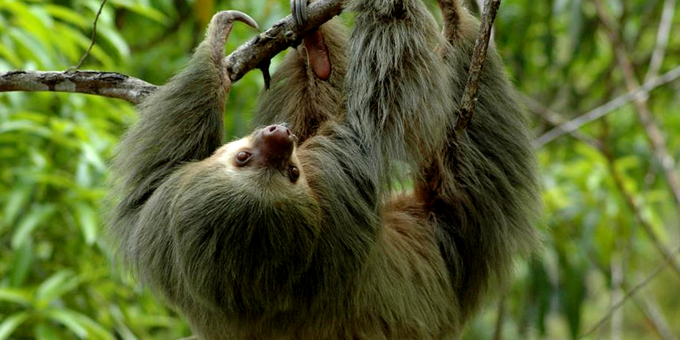
Free Vacation Planning
The fascination of sloths in costa rica.
Incomprehensible Cuteness: Sloths are undeniably adorable. Their perpetually content expressions, seemingly ever-present smiles, and fluffy fur are a visual feast for animal enthusiasts. The sheer contrast of their sluggish movements with their cute appearance creates a captivating paradox.
A Relatable Lifestyle: In a world that often glorifies productivity and fast-paced living, sloths offer a refreshing perspective. Their leisurely way of life resonates with many people who occasionally yearn for a break from the daily hustle and bustle. Sloths remind us of the beauty of slowing down and savoring life's simple moments. Endearing Expressions: Their seemingly eternal smiley faces create an emotional connection with humans. This distinctive feature has earned them a special place in our hearts.
The Rich Diversity of Costa Rica
Costa Rica, often referred to as the "rich coast," boasts remarkable biodiversity. Its lush rainforests, coastal habitats, and protected national parks provide ideal homes for a vast array of wildlife. Among these, sloths stand out as one of the most captivating and emblematic species.
Sloth Species in Costa Rica
In Costa Rica, you can find two species of sloths:
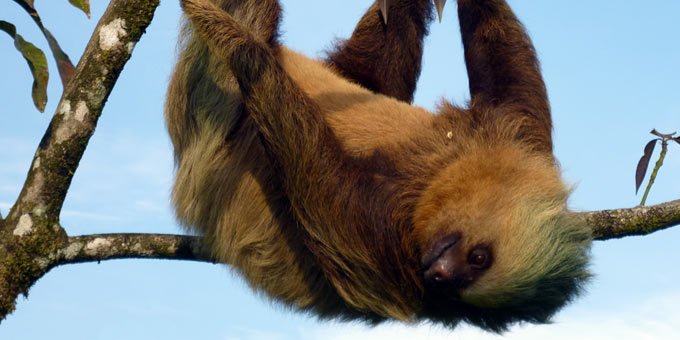
Hoffman's Two-toed Sloth (Choloepus hoffmanni): These nocturnal creatures are known for their rarity and are more challenging to spot. If you do come across one during daylight hours, they are likely to be peacefully napping.
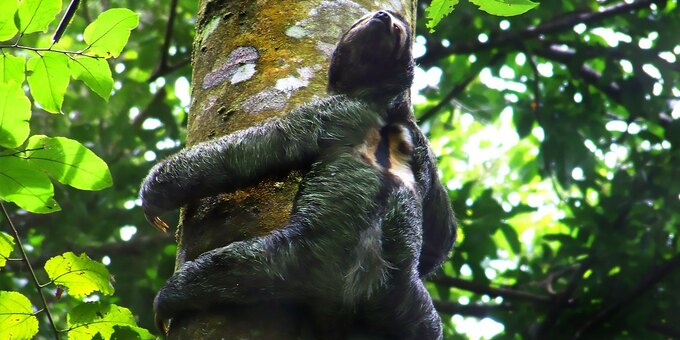
Brown-throated Sloth (Bradypus variegatus): These diurnal sloths are smaller in size and slightly more active, making them relatively easier to encounter.
Sloth Conservation
While Costa Rican sloths are not considered endangered, the country places great emphasis on conservation and protecting its diverse ecosystems. Sloths play a vital role as flagship species, drawing attention to the importance of preserving their natural habitats and the countless other species that share these ecosystems.
Discovering Costa Rica's Enigmatic Sloths: Where to Find Them in the Rainforests
Costa Rica, renowned for its astonishing biodiversity and pristine landscapes, is a prime destination for nature lovers. Among its many treasures, the country is home to the charming and lethargic sloths, which have become iconic symbols of its lush rainforests. If you're eager to spot these endearing creatures in the wild, you're in luck. Here, we explore some of the top rainforest regions and national parks where you can embark on a sloth-seeking adventure. 1. Arenal Volcano National Park Nestled in the northern part of the country, Arenal Volcano National Park is renowned for its dramatic landscapes, hot springs, and abundant wildlife. While exploring the rainforests here, keep an eye on the trees, as you may spot both two-toed and three-toed sloths lazily hanging from the branches. 2. Monteverde Cloud Forest Reserve Monteverde is synonymous with cloud forests and the enchanting biodiversity they harbor. Within this mystical realm, sloths find their home. Guided tours through the cloud forest provide opportunities to glimpse these creatures as they navigate the dense canopy. 3. Tortuguero National Park On the northeastern Caribbean coast, Tortuguero National Park is a haven for wildlife enthusiasts. Beyond its nesting sea turtles, you can encounter sloths, both two-toed and three-toed, on the forested waterways. Guided boat tours are an excellent way to explore the park and spot these elusive creatures. 4. Sarapiqui Located in the Heredia Province, Sarapiqui is a lesser-known gem for sloth sightings. Its lush rainforests offer an excellent chance to observe sloths in their natural habitat. Guided hikes or boat tours along the Sarapiqui River reveal the area's rich biodiversity, including its sloth population. 5. Cahuita National Park and the Southern Caribbean Coast Heading to the southern Caribbean coast, you'll find Cahuita National Park and its pristine beaches and rainforests. Sloths are often seen here, and guided walks through the park's lush trails offer fantastic wildlife encounters, including the chance to spot these arboreal creatures. 6. Manuel Antonio National Park One of Costa Rica's most famous national parks, Manuel Antonio, is a must-visit for wildlife enthusiasts. Its diverse ecosystems, including tropical rainforests, are teeming with sloths. Experienced guides lead tours within the park, helping you locate these elusive creatures. 7. Costa Ballena Costa Ballena, along the southern Pacific coast, is known for its stunning beaches and vibrant rainforests. Here, you can observe sloths while hiking through the verdant landscapes, and their leisurely tree-bound existence often captivates visitors. 8. Corcovado National Park For a truly immersive rainforest adventure, Corcovado National Park on the Osa Peninsula is a prime destination. This remote park boasts an incredible array of wildlife, including both two-toed and three-toed sloths. Guided treks through its pristine rainforests promise unforgettable sloth encounters.
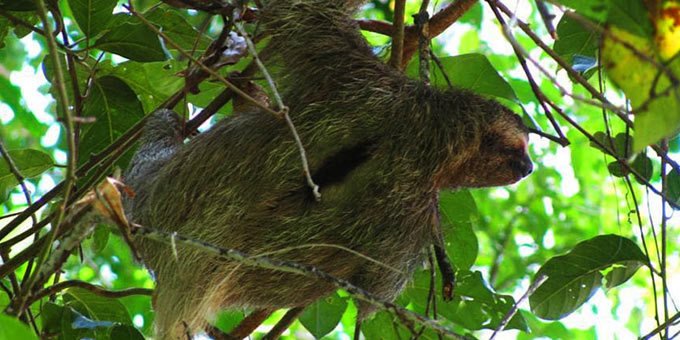
Tips for Sloth Spotting in Costa Rica
Hire a Local Guide: Professional naturalist guides possess a keen eye for spotting sloths and can provide fascinating insights into their behavior and habitat. Binoculars and Patience: Bring binoculars for a closer look and exercise patience, as sloths may take their time moving or may be camouflaged within the canopy. Stay Quiet: When approaching sloths, keep noise to a minimum to avoid startling them. Respect Their Space: Never attempt to touch or handle sloths in the wild, as this can cause them unnecessary stress. By venturing into these remarkable rainforest regions and national parks, you'll increase your chances of witnessing the delightful world of Costa Rican sloths. Whether you spot them among the leaves, slowly traversing branches, or peacefully napping, these endearing creatures are sure to leave a lasting impression of Costa Rica's incredible natural beauty.
Sloth Tours and Sanctuaries
For an enhanced sloth-spotting experience, consider guided night hikes for a chance to see the elusive nocturnal two-toed sloths. During daytime explorations, national parks, reserves, and wildlife sanctuaries are excellent places to witness sloths in their natural habitat. In summary, sloths in Costa Rica are beloved for their cuteness, leisurely pace, and the unique sense of connection they inspire in people. As endearing symbols of Costa Rica's commitment to conservation, sloths continue to capture the hearts of nature enthusiasts worldwide, making them an iconic and popular species in this biodiversity-rich country.
Unsure of what to do? Let us make you a free custom trip plan!

Best Places To See Sloths In Costa Rica
Arguably the most famous animal people want to see when visiting Costa Rica isn’t the monkeys or the whales, it’s the sloths.
Sloths are a symbol of the country because they live the Pura Vida lifestyle of going with the flow and being laid back, and of course, they’re adorable creatures.
While sloths are common in Costa Rica, they’re not very easy to spot.
If you want to see a sloth during your trip, it’s important to learn about them ahead of time so you’ll know where you can expect to find them and what to look for. Sloths camouflage themselves well, so it’s easy not to spot them when searching.

Types Of Sloths In Costa Rica
There are two types of sloths in Costa Rica, including the Brown-throated sloth, which is a species of three-toed sloth, and the Hoffman’s two-toed sloth.
There are six species of sloths in the world, but only two live in Costa Rica.
Three-Toed Brown-throated sloth
The Brown-throated is the most common of the three-toed sloth. Their feet have three toes on each foot with large claws.
They have rounder faces, shorter noses, dark areas around their eyes, and brown necks. This sloth sleeps about 15 hours per day and can be active both day and night.
So it’s the type of sloth you’re more likely to see during the day. This is the most popular type of sloth. It’s smaller than the Hoffmann’s sloth, and it’s strictly a herbivore.
Two-Toed Hoffmann ’ s Sloth
This sloth is nocturnal, so it’s much harder to see, and if you spot one, it’ll most likely be sleeping.
The two-toed sloth gets its name because the two front feet have two toes, each with long, curved claws. The hind feet, however, have three toes. The Hoffman sloth also has a longer snout, separate front toes, no hair on the soles of the feet, and is larger.

Best Places to See Sloths in Costa Rica
Both types of sloths can be found in the same areas in Costa Rica except for high elevations. It is much more common to find the two-toed sloths in higher evaluations because they have more hair so that they can survive in colder temperatures.
High elevation, in this case, is 3000 feet. Places like Monteverde and Vara Blanca have higher elevations and are places you’ll mostly only find the two-toed sloths.
Keep reading to learn more about the best places to spot sloths in Costa Rica:
1. Caribbean Coast
The Caribbean coast is better for viewing sloths. The Pacific coast is drier, which sloths don’t prefer, except for the Osa Peninsula on the southern end of the Pacific Coast, which is popular among these animals.
2. Wildlife Refuges, Sloth Sanctuaries, and Rescue Centers
If you want to ensure you don’t leave Costa Rica without seeing a sloth, visiting a refuge, a sanctuary, or a rescue center is your best bet.
You’ll never get to pet or hold sloths in Costa Rica, but you’ll be able to see them up close at one of these establishments. It is one of the best things to do when visiting Cahuita .
Touching them is extremely bad for their health because it stresses them out, and humans can emit bacteria that can make a sloth very sick.
If you visit a place that does allow you to pet or hold a sloth, know that this is illegal, and you should go somewhere else and not support this type of business.
Sanctuaries are homes for animals that cannot go back into the wild because they’re handicapped, were previously kept as pets, disabled, born into captivity, etc.
There are several great sanctuaries in Costa Rica.
Sloth Sanctuary of Costa Rica in Limón was the first-ever rescue facility for abandoned and injured sloths.
You’ll hear stories about the rescue of sloths, and this is considered the best sanctuary on the Caribbean coast.
Selvatura Park’s Sloth Sanctuary in Monteverde is also great. The environment is thoughtfully designed to look like a sloth’s natural habitat. You can find both adult and baby sloths here. These are just a few of the sanctuaries.
Rescue centers work to rehabilitate animals to put them back out into the wild. Some rescue centers helping sloths include Jaguar Rescue Center in Punta Cocles, Proyecto Asis outside of La Fortuna, Toucan Rescue Ranch in Heredia, and Alturas Wildlife Sanctuary in Puntarenas, Costa Rica.
Additional wildlife rescue centers that care for and protect sloths and other animals include Zoo Ave outside of San Jose and Centro El Resccate Las Pumas in Canas.
There are many refugees, rescue centers, and sanctuaries across the country supporting many animals, including sloths.
There is sure to be one near where you’re staying if you’d like to visit to learn more about and support the protection of sloths.
3. National Parks
National parks are another excellent place to find sloths. Parks often have guides you can hire to show you around the park and help you spot wildlife, including sloths.
Manuel Antonio National Park
Located in Quepos, Manuel Antonio National Park is home to many of Costa Rica’s animals, including sloths.
This is one of the most visited parks for people who want to see an abundance of wildlife. Both types of sloths live in this park, and there is even a special trail for sloth spotting.
There are also many guides that can bring you on a sloth search. The best place to look for a sloth is way up in the trees, as high as you can search. Manuel Antonio Park is a MUST-do when visiting the area.

4. Arenal Volcano National Park
Located in La Fortuna, this park has a lush tropical forest and views of the Arenal Volcano. It’s also an excellent place for wildlife lovers.
The best place to find sloths in this area is along Bogarin Trail, which is a 1.2-mile trail and home to over 20 sloths and other animals.
The sloths will often be tucked inside thick leaves high up in the trees, so it’s much easier to spot them with the help of a guide or if you have a trained eye for them. Once you learn how to spot them, you will see them everywhere.
5. Monteverde National Park
This is one of the most intriguing national parks, home to the cloud forests of Costa Rica.
You can spot sloths here, but only the Hoffman’s sloth which has more fur and can survive higher elevations.
The Hoffman sloths are nocturnal, so it’ll be hard to spot them during the day, but you can go on a guided nighttime tour for a better chance of seeing these lazy, cuddly creatures.

6. Corcovado National Park
Located on the Osa Peninsula on the Pacific Coast, this national park is great for seeing all sorts of animals, including whales, monkeys, and sloths.
You’ll have to be able to walk pretty far to see sloths, so it’s not the best place to see sloths if you’re not up for walking. However, if you like a nice hike, you can hire a tour guide and have a wonderful time looking for sloths.
7. Cahuita National Park
In the town of Limon by the border of Panama, Cahuita National Park is a great place to find sloths. The park is free to enter, which is a huge plus, and it’s one of the most accessible parks in the country.
Besides sloths, you can see a ton of other wildlife in this national park. It is also one of the best places to snorkel in Costa Rica.
8. Tortugeoro National Park
Also located in the Limon province, this is another excellent place to spot sloths. There is a great chance you’ll leave here having seen a sloth or two as well as monkeys, lizards, and lots of other animals.
9. La Amistad National Park
This is a world heritage site on the border of Costa Rica and Panama. It’s also one of the largest national parks in the country.
The park is very remote, so if you’re not willing to hike or put in the work to see sloths, you may not spot them here.
It’s not quite as easy to find sloths in this park, but it’s a beautiful park to explore and simultaneously search for sloths. Since this park is much more remote, there aren’t as many tourists, so you can have the area to yourself; just be ready to hike!
Best Way T o Guarantee A Sloth Sighting
Sloths can be hard to find because they camouflage very well with their surroundings. They’re usually found high up in trees, and guides are trained to look for them and usually use binoculars to do so.
If you want to see a sloth, the best thing to do is hire a guide . You can go on guided tours in many national parks, which is a great option.
You’ll be able to see sloths this way but also learn about the park from your guide.

Tips For Seeing A Sloth In The Wild
If you don’t plan to hire a guide and want to spot a sloth all on your own, that is completely fine! However, there are a few things you’ll want to learn before setting out on your sloth search adventure.
- Sloths are usually found high up in trees, so keep your head raised towards the sky and look in the branches.
- Sloths have a favorite kind of tree. It’s the Cecropia Tree , so memorize the way it looks and search for this tree first. Once you find one, you can examine it for sloths.
- You’ll have better luck seeing sloths on the Caribbean Coast vs. the Pacific Coast.
Additional Fun Facts About Sloths
- Sloths can turn their head almost completely around.
- Sloths like to be upside down, and their internal organs have adapted over time to allow them to be upside down nearly 90% of the time.
- They have a very slow metabolism, and it can take up to a month to digest a meal.
- They only come down from their tree once a month to poop.
- Sloths sleep 15 to 20 hours per day and barely move throughout the day.
- Their fur is covered in algae and moths. The algae are used to camouflage the sloths in the trees. The algae also supplement their diet, and in return, the algae can survive from the shelter and water that the sloth’s hair retains.

Final Thoughts On Sloths In Costa Rica
As you can see, sloths are found all over Costa Rica and are not impossible to spot. With a bit of training and a local guide, you’ll be on your way to finding these adorable animals.
If you get really lucky, you might even see them while they’re on the forest floor instead of high up in the trees, when they have their monthly poop.
This is the most dangerous thing they do during their life because they’re vulnerable to predators. Believe it or not, since sloths are lazy creatures, they’re excellent swimmers.
If you’re extra lucky, maybe you’ll spot one going for a dip.
If you’ve been dreaming of seeing a sloth in real life, you’ve come to the right place. Costa Rica is one of the best places to see this wonderful animal.
Related Content
- Best Places To See Monkeys In Costa Rica
- Costa Rica Bucket List
About The Author
Megan Kulluk
Related posts.

Top 11 Things To Do In Quepos, Costa Rica

Cheapest Place To Live In Costa Rica 2023

Tipping in Costa Rica: How much you should Tip

- Select your tour
- HOW TO GET HERE: maps, driving & mailing address
- BUTTERCUP INN
- General questions
- Visiting the Sanctuary
- “MEET THE SLOTHS” Animal Planet TV
- FEATURED in the MEDIA
- PARTNERSHIP
- RAINFOREST BIODIVERSITY
- RELEASE STORY
- Release: Challenges & Concerns
- Bradypus variegatus
- Choloepus hoffmanni
- Extinct Giant Ground Sloths
- Anatomy & Physiology
- Captive Sloth Biology
- Male Sloth Speculum (colorful fur patch on back)
- Sloth Digestion
- Sloth Metabolism
- Sloth Metabolic Rate
- Sloth Invertebrate Ecosystem
- Wild-Born Sloth Genetic Analysis
- CURRICULUM: Visual Art Activities / Grades K – 8
- CURRICULUM: Language Arts / Grades 1 – 6
- CURRICULUM: Science Activities / Grades 4 – 8
- CURRICULUM: Educator resources
- SUPPORT THE SLOTHS
- VISIT DURING YOUR PRINCESS CRUISE
Buttercup Tour: 1 hour
- Meet our sloth ambassadors in their protective enclosures
- NOTE: Due to inclement weather and water levels of the river, we are often unable to hold our regular canoe trips. We appreciate your understanding.
- Total tour time: 1 hour
Note: No touching the sloths! Wildlife conservation regulations limit touching, holding and handling of sloths to trained Sanctuary staff only. For the safety of the animals in our care, we cannot make exceptions.
US $28 Adult/Teen age 13+ US $15 Child age 5–12 n/c Young child up to age 4. Children age 12 and younger must be accompanied by adult.
Book your tour
- ButtercupTours@SlothSanctuary. com
For reservations with a Costa Rican cedula , please text us via WhatsApp (app available here ) at 6450-0312 (Tuesday–Sunday, 8AM–3PM) .
Group sizes are limited per governmental COVID precautions.
Tours begin on the hour: 8 AM / 9 AM / 10 AM / 11 AM / 12 PM / 1 PM / 2 PM
Payment: Cash or credit card when you arrive, US$ or CR colones .
For groups of 20+, please call to arrange advance payment. US $25 for each adult in your group US $22 for each student in your group holding valid school/university ID
PARKING: Remove all valuables and lock your vehicle.

Insider’s Tour: 2 hours
- Morning Tour // 8:45 AM arrival & registration / Tour begins at 9 AM
- Afternoon Tour // 12:45 PM arrival & registration / Tour begins at 1 PM
The Buttercup Tour, plus go “behind the scenes” to the NICU/Nursery. You will hear their special rescue stories and learn why Costa Rica wildlife rescue centers are so very important.
US $150 Adult age 19–64 US $75 Youth age 6–18 US $85 Senior age 65 and up n/c Child through age 5. Children age 12 and younger must be accompanied by adult.
- Use form below. We confirm availability and send your invoice by email. Using PayPal, pay the invoice using a credit card (no account required). Your tour is booked when we receive your payment!
- Please bring a printout of invoice to your tour. Please read the cancellation/rescheduling information detailed on your invoice.
INSIDER'S TOUR BOOKING REQUEST
Name (required)
Email (required) Please verify spelling is correct!
Please re-type and check spelling!
Preferred tour date (Tuesday through Sunday only; closed Mondays ):
Insider's Morning Tour: Registration/arrival time at 8:45AM Insider's Afternoon Tour: Registration/arrival time at 12:45PM
How many guests, please?: $150 Adult 19–64 0 1 2 3 4 5 6 7 8 $75 Youth 6–18 0 1 2 3 4 5 6 7 8 $85 Senior 65+ 0 1 2 3 4 5 6 7 8 n/c Child 5 and younger 0 1 2 3 4 5
If you would also like to book a room at our Buttercup Inn, please complete the form on the Buttercup Inn page.
When we receive your request, we will promptly check availability then respond by email. If your requested date is available, we will email you a PayPal invoice to be paid via a credit card. When you pay the invoice, your booking is confirmed!
Details about your visit?
Insider’s Tour Gift Certificates
Send details to [email protected] . We will respond with a PayPal invoice that you may pay by credit card. Once paid, we will email a Gift Certificate to your recipient. Valid for two years from issue date.

Booking the Insider’s Tour is required to stay at the Inn. Available Tuesday through Saturday night . Stay up to three nights and explore other area attractions . Room rate includes continental breakfast.
> Click to request your Insider’s Tour & stay at the Buttercup Inn
HOW TO GET HERE Click for details
FLY From USA: Southwest Airlines to San José, Costa Rica From San José and Costa Rica’s Pacific Coast: Sansa Airlines to Limon (2 flights a day from San José) From Liberia, Costa Rica: Nature Air to Limon
DRIVE Set GPS to Latitude 9.799565 Longitude -82.915112 Route 36
EasyRide Costa Rica: Shuttles & Private transport options to/from Puerto Viejo & Cahuita
TOP 5 MOST-ASKED QUESTIONS • Click here for full FAQ
I want to touch or hold a sloth. May I?
Can I volunteer, work, intern or help at the Sanctuary?
I’m coming to visit! Where can I get water & snacks?
Where can I learn about sloths?
Media inquiries
I want to hold or touch a sloth. May I? No. Per MINAE conservation regulations, only Sanctuary staff are allowed to handle sloths. When handled by unfamiliar people, sloths exhibit tachycardia (abnormally fast heart rate) that weakens the heart muscle, a cause of premature death. Also, foreign microbes and allergens attached to guests can compromise rescued sloths’ immune systems.
Note: Avoid roadside locals who lure tourists to pose for photos holding a sloth. They will tear a baby away from its mother to exploit it for money. After they take your photo, they discard the baby inhumanely, leaving it to die from malnutrition or dehydration. If you see someone trying this, please take a photo of the person, then call 911 to report them to the police. top of page
Can I volunteer, work, intern or help at the Sanctuary? No. We are not hiring volunteers or staff. We are proud to employ local Costa Ricans and also offer veterinary clinical rotations solely to university students who reside in Costa Rica. We do not endorse or recommend any particular Costa Rican conservation volunteer program. top of page
I’m coming to visit! Where can I get bottled water & snacks? Purified bottled drinking water is essential for your comfort & health in tropical Costa Rica. On your way here, seek out a local market or our favorite, Auto Mercado ( multiple locations ). top of page
Where can I learn about sloths? Visit our social media pages. top of page
Media inquiries We require 60 days’ notice to film at the Sanctuary or interview Judy Avey-Arroyo. Send your request to [email protected]
top of page

Call us via WhatsApp (app required) +506 6450 0312
Urgent sloth rescue:
- If you find an injured, orphaned or abandoned sloth, call and tell us the exact location where you found the sloth. Use your mobile phone to take a screen capture of the GPS coordinates.
- Si encuentra un perezoso que requiere ser rescatado, es muy importante que nos indica su ubicacion exacta. Se puede obtener la ubicacion exacta tomando una captura de pantalla de las cardinales GPS desde su celular.
Located on the southeast Caribbean side, we are a 320-acre nature preserve and rescue center. The Sanctuary is funded solely by proceeds from educational tours, the gift shop and inn and generous donors around the world.
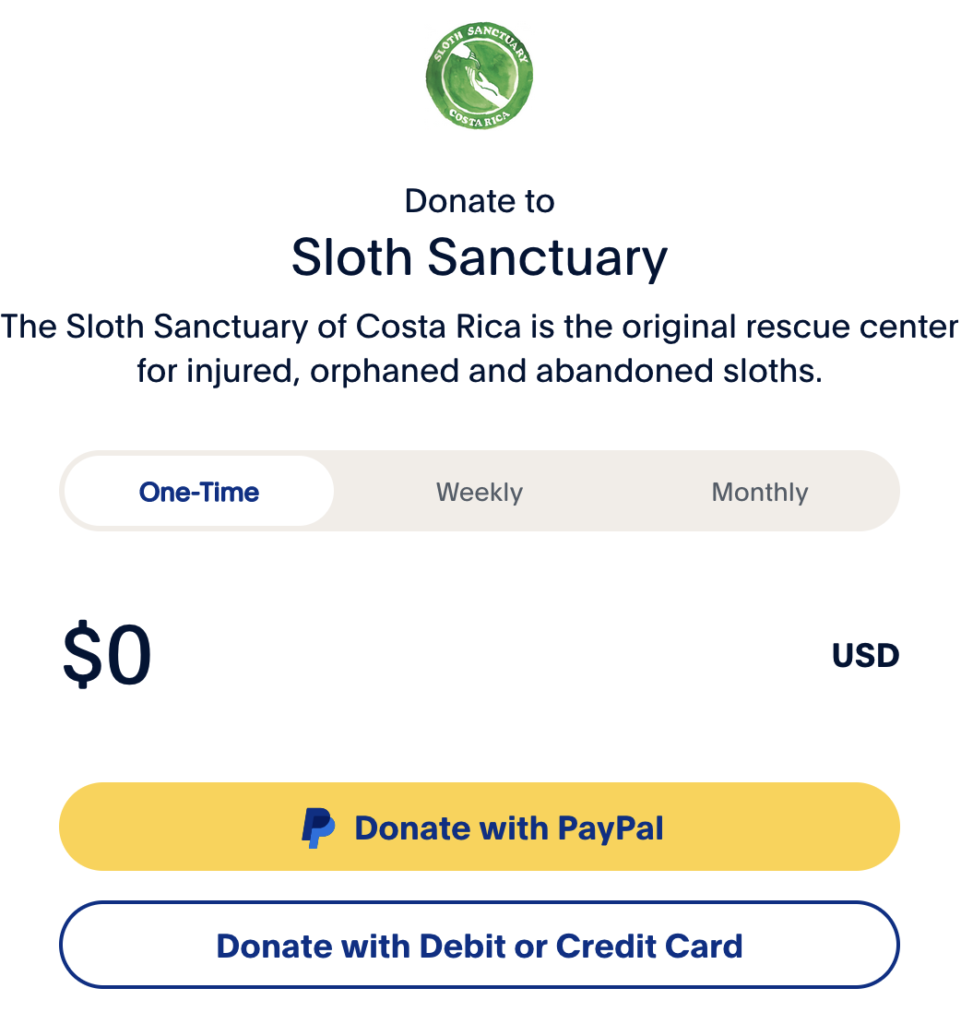

Costa Rica Sloths: An Expert Guide To Where to Find Sloths & Tips
There's no denying, sloths are HOT, and not just because they live in the tropics. Over the past few years, our obsession with these adorable, dopey, smiling, chilled-out creatures has grown. The most beautiful thing is, not only are they cute, but they're also some of the most fascinating animals in Costa Rica.
I have been working with sloths for nearly eight years, and we are still learning about these amazing creatures every day. Six species are living in the Americas -- from Honduras, down -- and we have two different species living right here in beautiful Costa Rica.
You can find the two-fingered Choloepus Hoffmanni, which looks like a cross between Chewbacca from Star Wars and a pig, and the adorable, raccoon masked three-fingered Bradypus Variegatus.
I’ve called them two- and three-fingered rather than toed; that’s because all sloth species have three toes. The difference is on their hands, not their feet.
But, where is the best place to hang out with a Sloth? Well, right here in Costa Rica. Costa Rica is a mecca for wildlife tourism, and it’s #1 most wanted is the Sloth.
They will be hanging above your hotels or eating blissfully in the canopies of the national parks. It's also not uncommon to see one crossing the road -- cue all the 'why did the Sloth cross the road' jokes. So, how do you see Sloths in Costa Rica? Honestly, the best tip, slow down and lookup.

- Best Places To See Sloths
- What To Do When You See A Sloth
- What Can I Expect To See?
- Slothy Camouflage
- Can I Hold/Touch a Sloth?
Wildlife Center Recommendations
- Fast Sloth Facts

Best places to see sloths in the wild in Costa Rica
Here are three popular sloth hangouts you are almost guaranteed to get up close and personal with some wild sloth action. Just respect their area and observe; no selfies, please. You wouldn't want anyone breaking in your house and taking selfies while you ate your salad.

Cahuita National Park / Puerto Viejo
There are sloths everywhere, and you can even see them in the trees by the beaches. I see at least 3 Sloths a week just cycling up and down the road. If you really want to make sure you see them, hire a local guide; they are excellent spotters.

Manuel Antonio National Park
Manuel Antonio National Park has a high concentration of sloths and other animals, and it is always jam-packed with both locals and tourists. This is because it's beautiful, and there is a lot of wildlife to see.
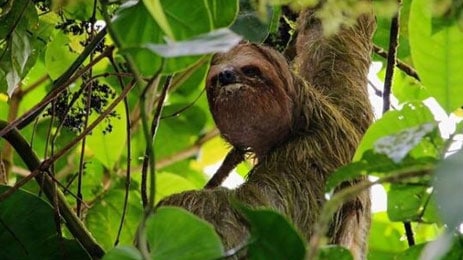
La Fortuna Hanging Bridges
Not only does La Fortuna have stunning views --I will never get bored of seeing the gorgeous Arenal Volcano, but you can also spot a ton of wildlife there, including sloths and a large variety of bird species. One of my favorite places to head to is the Mistico Hanging Bridges, which puts you at eye level with the canopy, and hopefully, sloths.
What do I do when I see a sloth?
First and foremost, make sure you give them at least 2-meters of space. Sloths are very sensitive and don't like loud noises. Getting too close also frightens them. Make sure you don't use the flash on your camera and just sit back, relax and watch the sloth do its thing. You could also be fortunate and catch the sloth coming down for its weekly poo! During this time, they come all the way down from the tree to the ground, wiggle their butts back and forth while doing the world's cutest poo dance. And in the process, they can lose up to a third of their body weight at a time. Now that's a good poo.

What can I expect to see?
Most likely, you will see the Sloths curled up in a ball in a tree having a nap. But, you can also see them eating in the canopy, coming down to change trees, and possibly even a mom with a baby!
Speaking of Napping . . .
Sloths have a reputation for being lazy, their Spanish name, Perezoso, translates literally into 'lazy bear,' but these creatures are far from lazy, they're stealthy.
Sloths eat leaves, and that's not the most nutritional diet out there. Think of it like you only being able to eat lettuce all day; you'd be sluggish too.
Most animals that have a diet of leaves, like koalas, sleep an amazing 20 hours a day to help combat their low energy diet. The humble sloth, in comparison, sleeps only around 10 hours. Yes, you read that right.
It is a common myth that sloths sleep a lot. Most sources say anywhere from 18-22 hours, but research conducted on wild sloth behavior has proven otherwise.
So actually, they move around at a ‘sloth's’ pace as a clever way to save energy. Sloths can move quickly; they are choosing not to. They're also slow for a few other reasons - the most important one being predators.

InCostaRica Mobile App
Slothy camo.
The majestic harpy eagle and the jaguar are both predators to sloths, and they are visual hunters. So, by moving slowly, the sneaky sloth remains undetected. Sloths also cannot sweat or shiver, so they don't produce body odor -- seriously, how good does not sweating sound?
You may have also noticed the sloth's green color. Most people believe that sloths grow algae because they are soooo sloooow, but their hair is specially designed to produce fungi. There are over 70 different types of unique fungi that grow in their hair, which turns the sloths green, helping them camouflage themselves like a tree, cleverly hiding from their predators.
Recent studies on these fungi have also shown that, not only is it antibacterial, but that it may cure breast cancer. Therefore, not only are sloths incredibly cute, but they may have the ability to help cure cancer in their fur – all because they are trying to remain hidden. Pretty amazing.
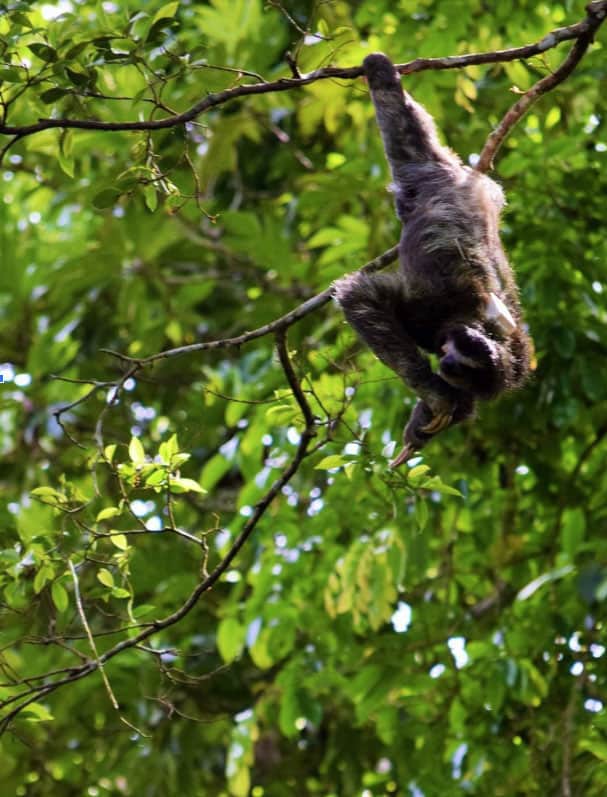
Can I hold or touch a Sloth?
One of the most common questions I get is, "Can I hold/pet a sloth?" Unfortunately, No. Even people who work with sloths try to minimize the contact they have with them. This is because, even though sloths look cute and cuddly, they HATE being touched.
Sloths are solitary animals, and most wild animals don’t particularly like being around humans. However, sloths, whether wild or hand raised, get tachycardia when handled by humans. This means, as soon as you even approach them, their heart starts to race at dangerous levels.
However, due to their smiling demeanor, they always look like they're enjoying it, but inside, it is causing the animal a great deal of stress.
Sadly, if you go to any organization that lets you hold a sloth, it is not for the benefit of the animal, and it is harming them. And, who wants to make sloths sad?
The best place to admire them is happily munching leaves in a tree, maybe having a good stretch, or blinking contentedly at you and wondering, “what exactly is all the fuss about?”, as you take 1000 pictures of them.
Remember not to interact with the wild sloths. Not only could you be at risk of getting bitten, but you will also be breaking the law. Sloths, and all wild animals, are heavily protected in Costa Rica.
If you do want to see sloths up close and personal, there are a couple of excellent institutions that rescue and rehabilitate sloths. Going to a wildlife rescue will allow you to get your fill of them while also helping an organization that is working to save wildlife in Costa Rica.

Jaguar Rescue Centre
Get close to a variety of animals on a guided tour around this rescue facility. The animals are mostly returned to the wild after being rehabilitated, where possible.
Address: In front of Villas del Caribe, Limón, Punta Cocles
Phone: 2750 0710
Web: https://www.jaguarrescue.foundation/en-us/

The Sloth Sanctuary
This is the first place in the world that rescued sloths, nearly 30 years ago. You can take a tour and see their sloths, as well as enjoy a canoe tour of the river. Again, where possible, the Sloth Sanctuary releases and rehabilitates the sloths that come to their facility.
Address: Route 36, 30 km South of Limón Limon, 7302
Phone: 2750 0775
Web: http://www.slothsanctuary.com/
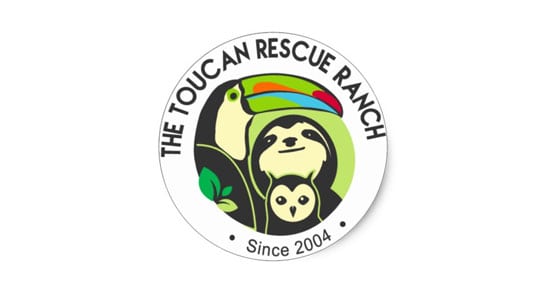
Toucan Rescue Ranch
The Toucan Rescue Ranch does a variety of walking tours, allowing you to view all of the wild animals that they rescue -- Cup of coffee and snack provided. Sloths and coffee, what a great combo.
Address: Off of Route 112 near downtown San Josecito, Heredia
Phone: 2268-4041
Web: https://toucanrescueranch.org/
‘Fast’ Sloth Facts
The two- and three-fingered sloths that we can see today are 33 million years apart. This means that we humans are more closely related to BABOONS than the two- and three-fingered sloths are to each other.
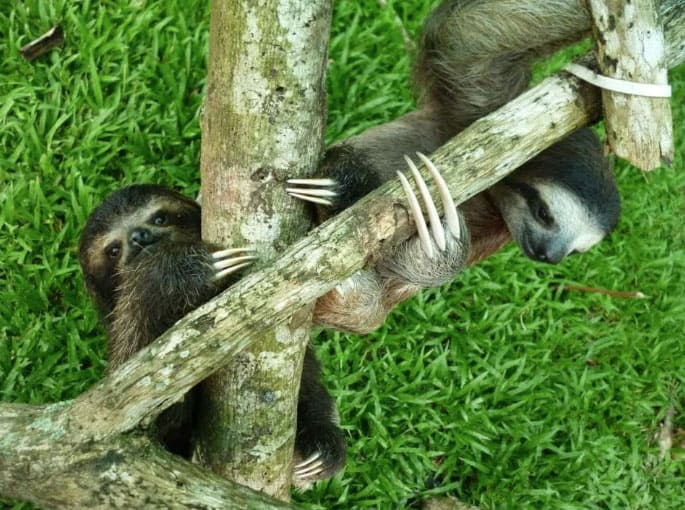
Many people believe that Sloths are related to monkeys or bears, but they are, in fact, Xenarthrans. In Latin, this means strange joints. Sloths, anteaters, and the armadillo all have additional vertebrae that no other mammal has. So yes, they are related to anteaters and the armadillo -- even I find that one a tad weird.

Sloths are not the fastest, especially on the ground, but they are excellent swimmers – particularly the three-fingered. In Panama, they can be seen swimming between islands, looking for a new tree, or love.
Their common ancestor, the Giant Ground Sloth (Megatherium), was around 6-7 meters tall and weighed over 6 tonnes. And, who likes Avocados? Well, you can thank the Giant Ground Sloth.

Sloths will fall out of the tree an average of once a week when the branches break, and no, they don’t mistake their arms for tree branches, as some assume. However, they are great at falling, sometimes falling over 100ft, hitting the ground, bouncing, and not a single broken bone. Not to say they aren’t confused about how they got to the ground; it is the quickest they’ve ever moved.
Their four-chambered stomachs, which takes nearly a month to digest a single leaf, means there is a lot of, well, gas and gas makes you float. Plus, the three-fingered sloth has two more vertebrae in its neck than any other mammal.
They were one of the few animals that could eat the avocado whole. They would then poop the seeds throughout Central & South America; so, thanks Megatherium for the Guacamole!

We’ve talked a little about how sloths come to the ground to poop but not why. This is very strange for an arboreal mammal, particularly one that is trying to save energy and remain undetected by their predators.
The main reason they make this treacherous journey is for mating. It is hard to find a mate, but especially when you are solitary, in a tree, hiding from a Harpy Eagle! So, when the females are in heat, they come to the ground to scent-mark using their poo & wee, letting the male sloth know they are in that tree. After all this effort to find a mate, the actual mating is the quickest thing they do besides falling from trees; it’s over in about 10 seconds.

In fact, it has two more than a giraffe. Excellent for sticking your neck far out of the water when you’re swimming, but it also means they can turn their heads 270 degrees.
There are so many more things to learn about this incredible animal. So, if you do want to learn more about sloths, head to www.slothconservation.com for more information from the leading sloth foundation in the world.
About the Author: Sarah Robinson is originally from the UK and has been working with both captive and wild Sloths for nearly eight years. She works in Costa Rica on Sloth conservation and education.
Related Posts

7 of the Best Costa Rican Fruits You Must Try

A Walk through San Jose – Flying into San Jose and Staying There
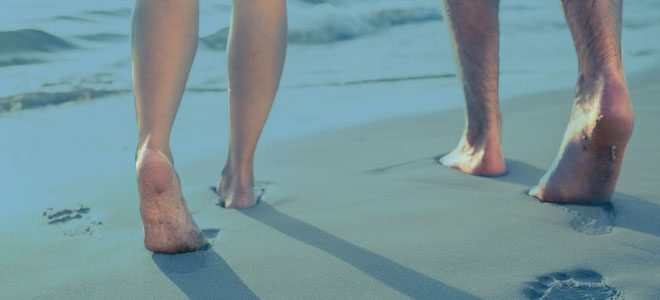
Planning An Extended Stay In Costa Rica
Trending Post: Costa Rica With Kids

Best Places To See Sloths in Costa Rica
This post may contain affiliate links.
It’s impossible to go to Costa Rica and not have quite a few animal sightings . Sloths are some of the most common species of wildlife in Costa Rica. Yet, there are still many people who visit the country and leave without seeing a single sloth! We don’t want that to happen to you!
So, in this post, I’m going to tell you where to see sloths including the kind of species to find, so your next visit can be worth your while. Read on!
RELATED POST: Costa Rica With Kids- The Complete Guide
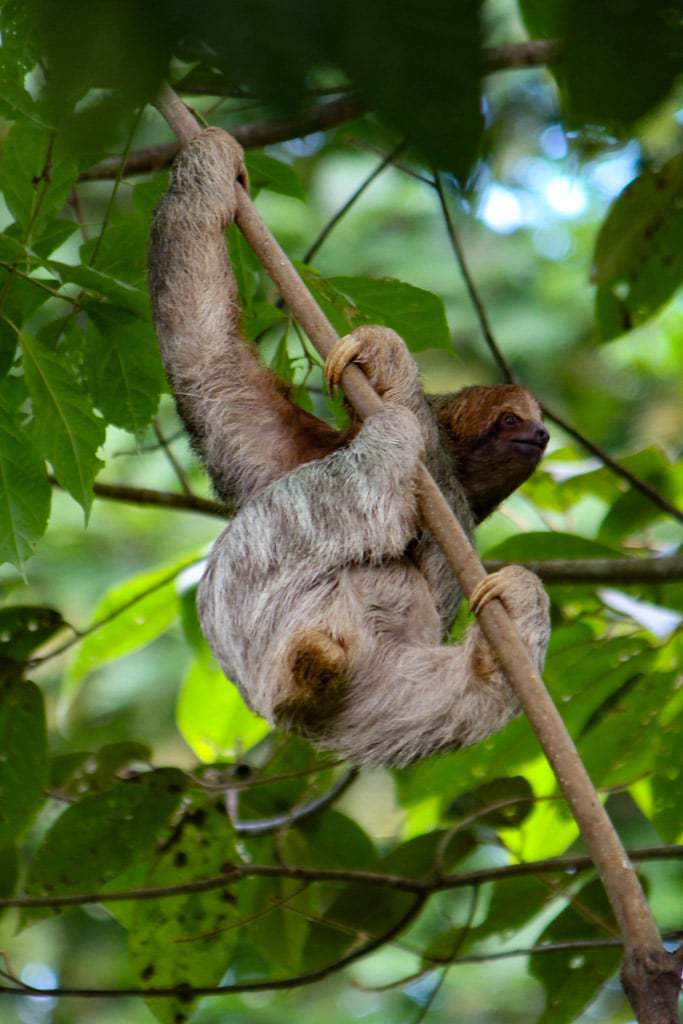
About Costa Rican Sloths
Known for their slow movements and characterful smiley faces, sloths are arboreal mammals residing in the tropical forests of South and Central America.
The cute baby-faced animals spend most of their lives hanging upside down in treetops, napping and hiding from predators, typically moving not more than 40 yards a day!
They have a very low metabolic rate which means it takes them a long time to digest their food. And kids always love this factoid- sloths head to the forest floor to poop!
Spotting sloths is not always easy. You must know where to look. Your best bet would be to look up into the sky-scraping treetops.
If you’re lucky, you may catch them descending to the ground where they come to poop once a week! Sometimes you may spot them resting in a calm river too – they are actually great swimmers!
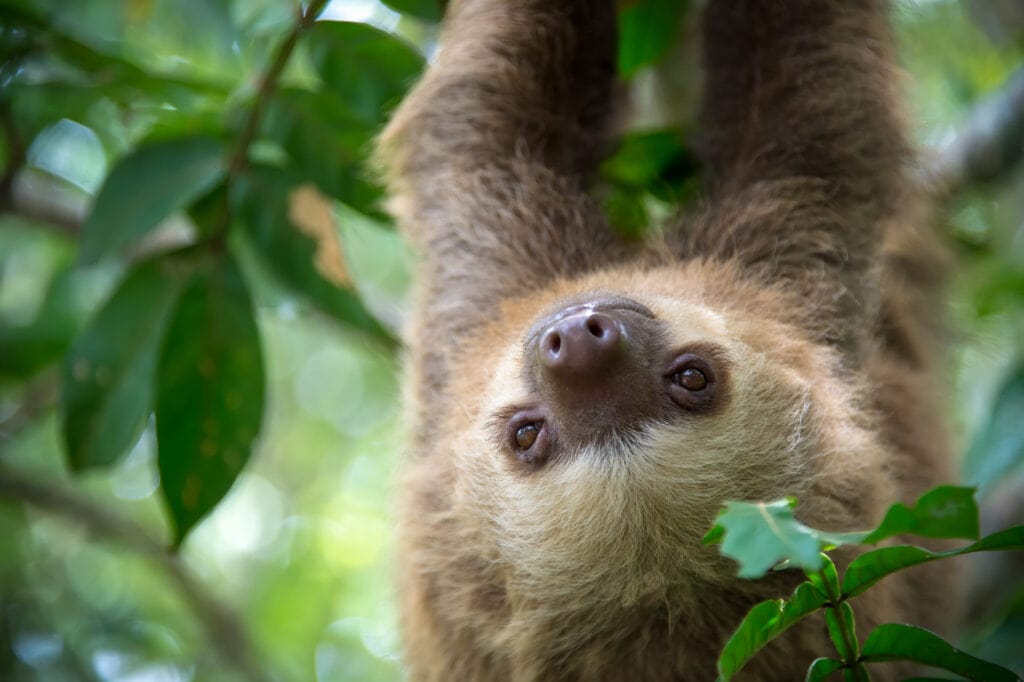
Types of Sloths Seen in Costa Rica
There are two species of sloths found in Costa Rica – the brown-throated three-toed sloth and the Hoffmann’s two-toed sloth – each with distinct characteristics that make it unique.
Brown-throated Three-toed Sloth
With three toes on each foot, a striking brown neck, and dark marks around its eyes, the brown-throated sloth is the most popular Costa Rican sloth in the world. It is smaller than the Hoffmann’s and because it is diurnal (active both day and at night), it’s also the species you’re most likely to spot during the day.
Hoffmann’s Two-toed Sloth
Although referred to as two-toed, only the front feet have two toes; the rear feet have three. Also, unlike their brown-throated sisters, Hoffmann’s sloths are nocturnal animals, mostly coming out at night. If you do see them during the day, they’ll likely be sleeping.
Their diet is also slightly different from that of the three-toed sloth species – while brown-throated sloths are strictly herbivorous, the Hoffmann’s have been found to occasionally eat small vertebrates too.

To see these two types of sloths, below are some places you can go:
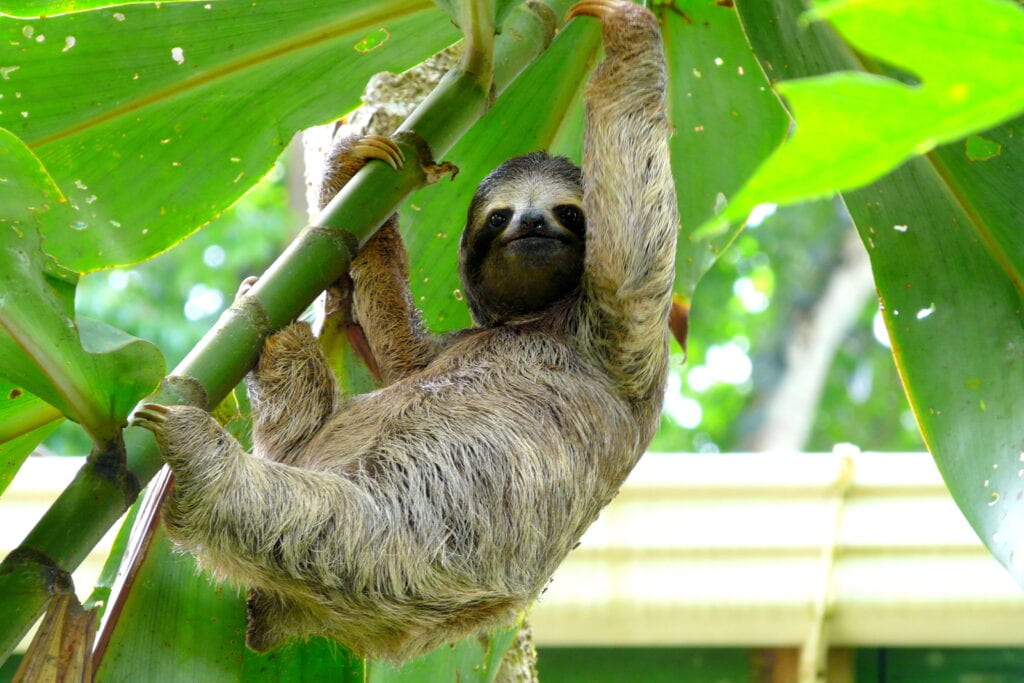
Sloth Sanctuaries
If you’re visiting with toddlers or young children who may not have the patience to traverse the jungle looking for sloths, I would recommend going to a sloth sanctuary instead. Here, kids can interact with sloths, see them up close, and ooh and ahh to their heart’s content.
There are plenty of wildlife rescue centers in Costa Rica that protect and care for sloths, which would make your trip just as rewarding.
Some wildlife refuge centers such as Zoo Ave and Centro El Rescate Las Pumas care for animals in general but also have sloths on site. These can be fun because kids can see lots of different species at the same place.
Here are my two favorite sloth sanctuaries:
Sloth Sanctuary of Costa Rica: Near Cahuita and Puerto Viejo , Limón you’ll discover the first-ever rescue facility for injured and abandoned sloths in Costa Rica where you will hear special stories about their rescue and learn about wildlife conservation. This is the best sanctuary on the Caribbean side.
Selvatura Park’s Sloth Sanctuary: If you’re staying in Santa Elena, take a trip to Selvatura Park and enjoy a guided tour of these adorable animals in an environment that’s carefully designed to mimic their natural habitat. Here you will see both baby sloths and adults and it’s only 10 minutes away from downtown Santa Elena.
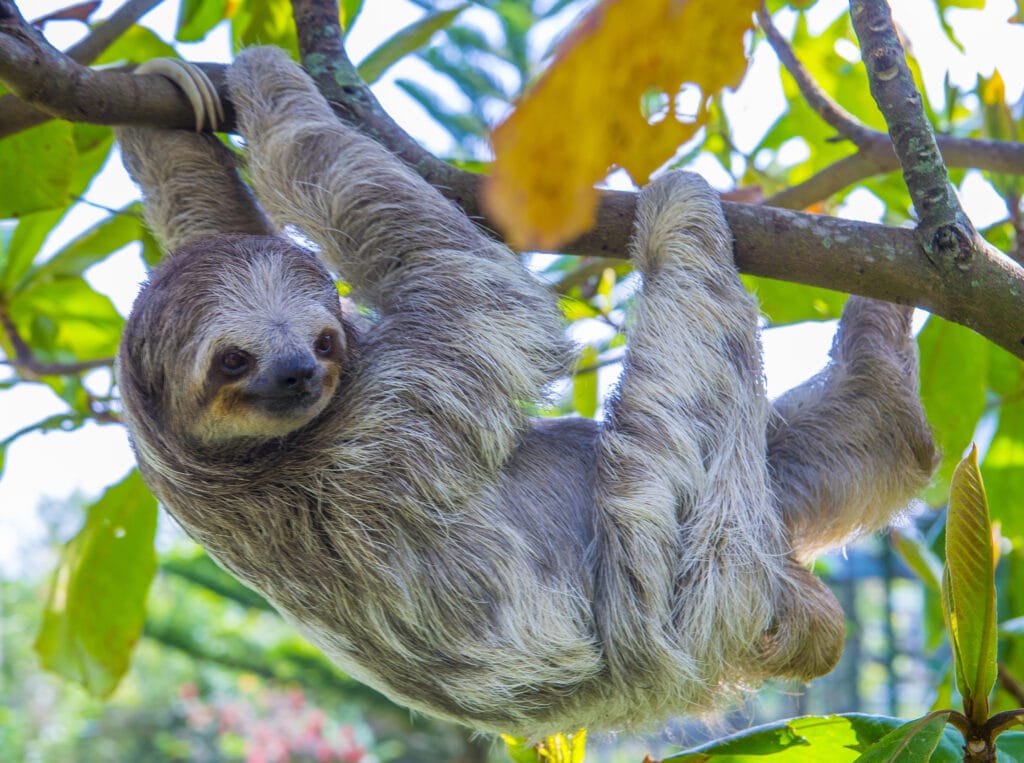
Manuel Antonio National Park
Located along the Pacific coastline, Manuel Antonio National Park is one of the most frequently visited places for people looking to see sloths and other unique wildlife in their natural habitat.
Here where forest and beach vegetation blend harmoniously, hundreds of mammals call home, including the two- and three-toed sloths.
The park even has a special trail exclusively for watching sloths! Plus there are plenty of skilled guides who are well acquainted with the trail and constantly communicate with each other about where to find the sloths.

The park is 3 hours from San Jose International Airport by road but you could also take a 20-minute flight to Quepos from where you can rent a car to the park. Come prepared to find lots of crowds especially if you’re visiting during the peak season.
Related post: Costa Rica’s National Parks Guide
Arenal Volcano National Park
The tropical rainforests of the La Fortuna area entice both Costa Ricans and foreigners with lush tropical forests and magnificent views of the monumental Arenal Volcano. And for wildlife lovers, this is also a great place to see cute sleepers.
If you’re coming here for sloths, the best place to go would be the Bogarin Trail. The 1.2-mile (2 km) trail hides in a restored secondary forest right in town and is home to about 25 sloths and a variety of other animals.
While sometimes the sloths will be hanging out in the middle tree branches, for the most part, these creatures will be tucked inside thick leaves up high in the trees, so I would recommend taking a guided tour to be able to find them.
Plus the guide’s telescope also comes in handy when you want to take pictures of the sloths! If you plan to stay, check out Nayara Hotel; the snoozy cuties are frequent here too.
While there is a sloth sanctuary in the La Fortuna area, beware! One of my favorite local guides let me know that around the time the sloth sanctuary was opened the local sloth population diminished to almost zero. Everyone in the area finds it suspect, and most guides won’t take you to the sloth sanctuary in La Fortuna.
Monteverde National Park
The cloud forests of Monteverde are complete eye candy, but that’s not the only reason this place is a popular tourist hub. Monteverde is also a great place to watch the sloths. The only downside is that you won’t be able to see the two types of sloths here, as only the Hoffmann species inhabits the area.
Also, keep in mind that Hoffmann’s are nocturnal, so you’ll likely not have successful viewing during the day. Good thing? You can make arrangements for a guided nighttime tour when the adorable tree-dwellers are more active.
Caribbean Coast
When it comes to looking for sloths in Costa Rica, you’re more likely to get a better experience on the Caribbean Coast than on the Pacific Coast where the climate is a little too dry for these animals.
Well, unless you’re traveling to the Osa Peninsula, the remote southern end of the Pacific where rainforests are quite expansive and the sloth’s natural habitat is still pretty intact, your best bet would be the Caribbean.
In the Caribbean, you’ll see spontaneous sloths even on the side of the road! But if you’re really emotionally involved in learning about sloths and their habitat, there are plenty of national parks in the region including the Cahuita, La Amistad, and Tortuguero. Just make sure to get a guide for the tour.
Related post: 5 Favorite Costa Rica Rainforests
Corcovado National Park
Corcovado National Park, on the Osa Peninsula, is one of the best places to see wild animals in all of Costa Rica. You’ll see howler monkeys , tapirs, coatis, whales, and quetzals. That means you can see sloths here too!
The very best way to do so is by hiring an experienced guide. Note that you’ll have to walk pretty far into the forest to have the best chance of seeing a sloth in the wild, so this isn’t the best place to go with young children .

Christa Jimenez
Welcome! I’m Christa, a Spanish teacher married to a handsome Costa Rican and mother of two bilingual daughters. We’ve spent over 25 years living in and traveling to Costa Rica with our daughters, and this website is my love letter to all things Costa Rica- and to bilingual parenting too. You can read my full story here . Thanks for stopping by!
Similar Posts

Best Places to Live in Costa Rica

Costa Rica With Kids- The Complete Guide
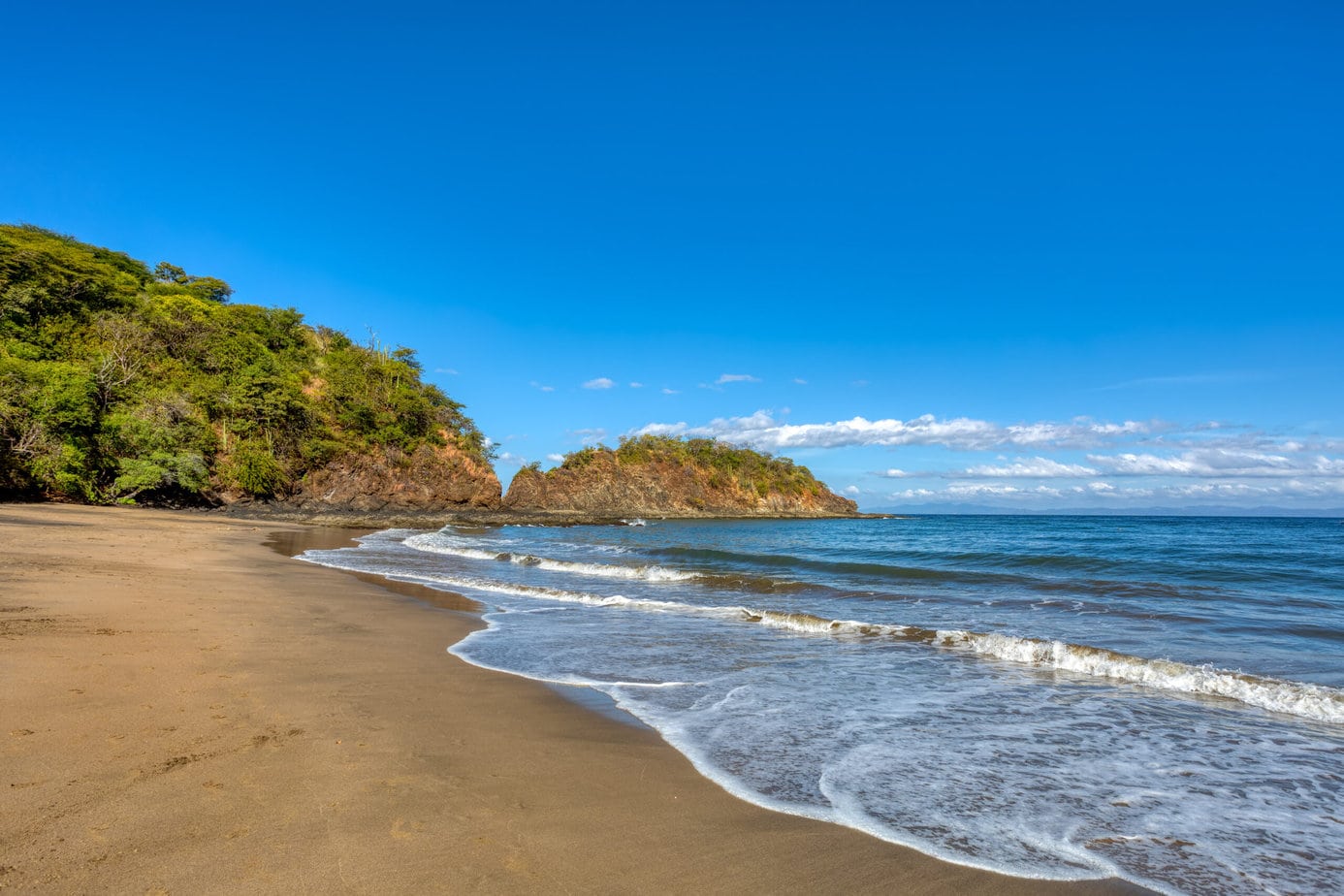
Playa Ocotal, Costa Rica

Top Micro-Breweries in Costa Rica
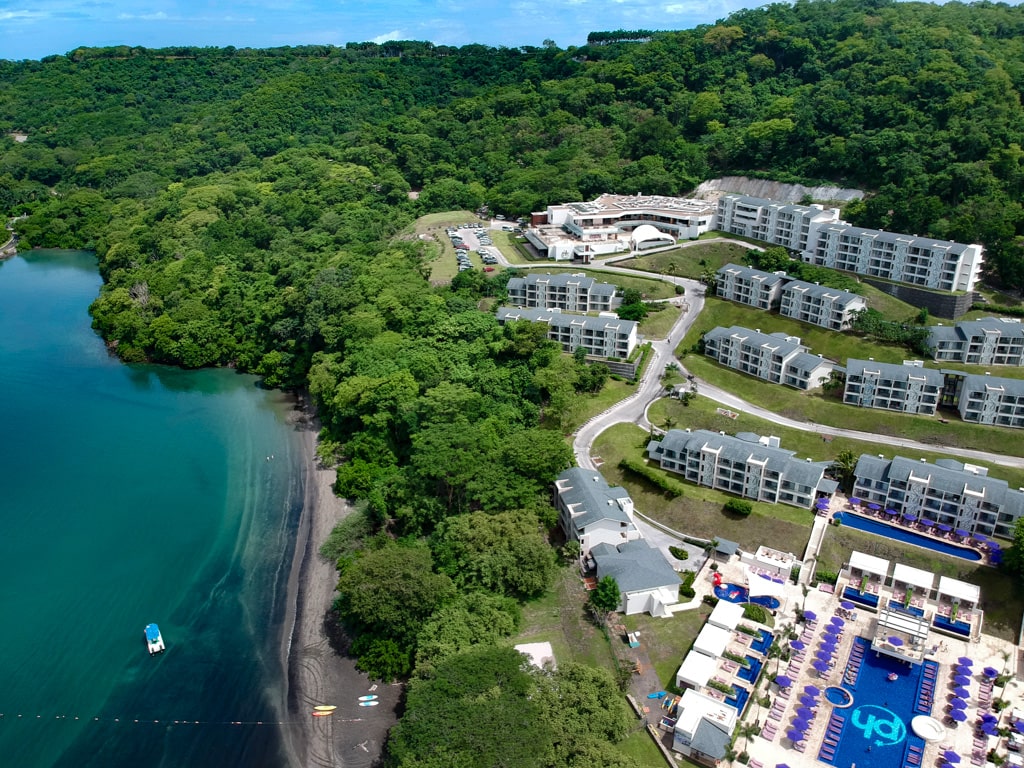
Planet Hollywood Costa Rica: Luxury All-Inclusive Hotel for Families
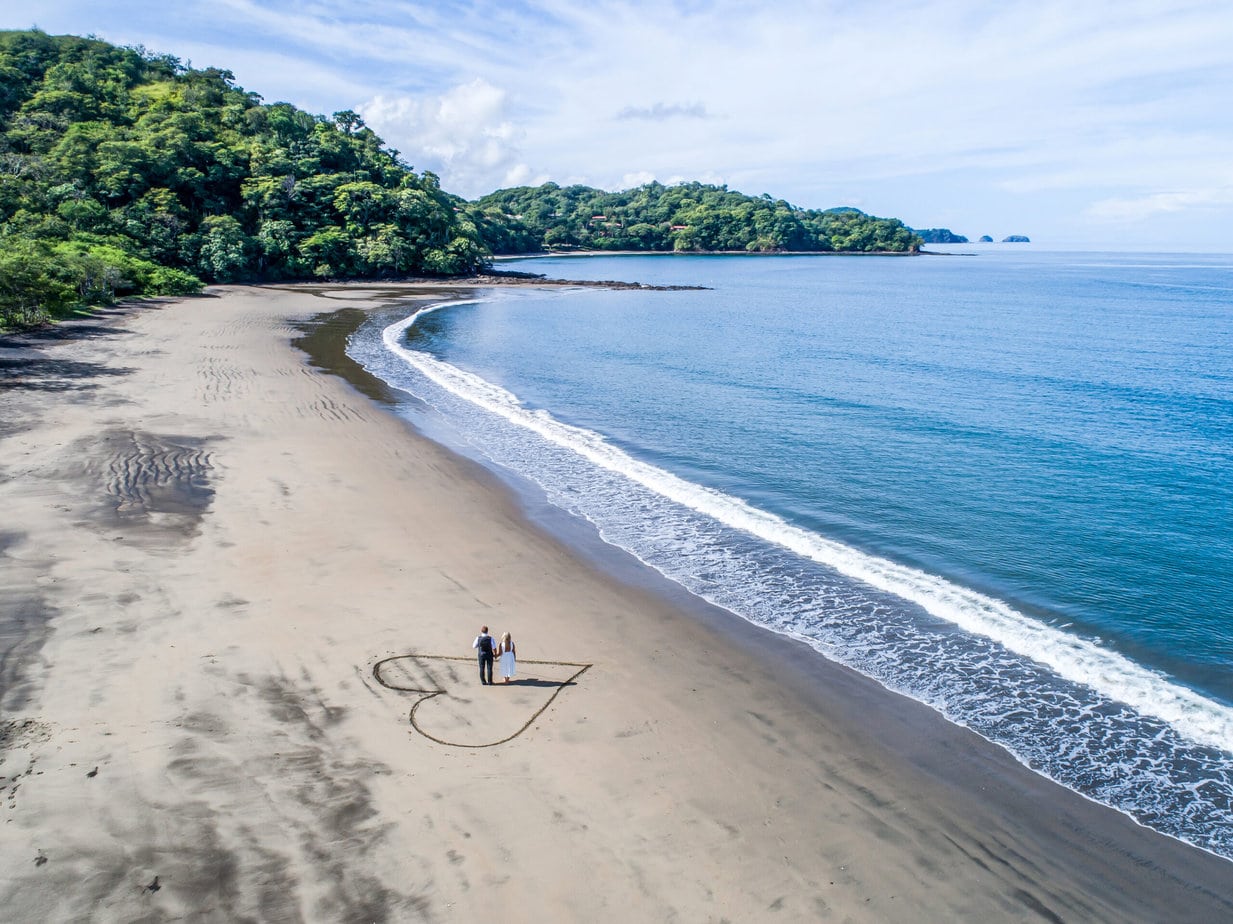
Costa Rica All-Inclusive Honeymoon Resorts
Leave a reply cancel reply.
Your email address will not be published. Required fields are marked *
As an Amazon Associate I earn from qualifying purchases.

Where To See Sloths In Costa Rica + Spotting Tips!
Costa Rica is a wildlife haven and possibly the best place in the world to see sloths in their natural habitat. Native to Central and South America, sloths are notoriously hard to spot; without knowing the best places to see sloths in Costa Rica , you could miss them.
Seeing sloths is one best things to do in Costa Rica and it was one of the reasons we took a family trip to Central America. Despite reports, they are spotted everywhere; unless you know where to see sloths in Costa Rica , your chances of spotting them are slim. Most of the sloths we saw were pointed out to us.
Top locations to spot sloths in Costa Rica: Manuel Antonio National Park , Tortuguero National Park , Arenal Volcano National Park , Monteverde Cloud Forest Reserve
The Best Place To See Sloths In Costa Rica
The vast primary rainforests of Costa Rica are home to both the two-toed and the three-toed sloth . Although rainforests are the best place to see sloths in the wild, spotting them can be difficult as they move slowly, high up in the tree canopies.
We recommend enlisting an experienced guide to give you the best chance of spotting them. It is well worth the expense as a good guide will also spot other wildlife and interesting fauna, which you might otherwise walk by.
You will not find sloths living in the Guanacaste on the North Pacific Coast as the tropical forest is too dry. National parks and sloth sanctuaries are the best places to see sloths in Costa Rica:
Where To See Sloths : National Parks and Reserves
1 | manuel antonio national park.
The tropical paradise of Manuel Antonio National Park is located on the Pacific coast. Home to both two-toed and three-toed sloths, this park offers the opportunity to observe sloths in their natural habitat.
We took a guided tour along the ‘sloth trail’. The guide pointed out sloths high in the canopy that we would not have spotted. As the national park is small, you might be lucky to continue finding sloths yourself once you know what to look for. If you don’t spot a sloth, you will definitely see lots of monkeys.

2 | Tortuguero National Park
Known for its rich biodiversity, Tortuguero National Park is another hotspot for sloth sightings. Accessible only by boat or plane, the park’s dense network of canals is teeming with wildlife, including sloths, as this is a pristine example of their natural habitat.
While we didn’t see any sloths on our visit, as it was raining! Other tourists had seen sloths the day before. We did see some massive iguanas and nesting turtles.

3 | Arenal Volcano National Park
For an unforgettable sloth-spotting experience, visit the Arenal National Park. Its unique volcanic ecosystems provide the ideal environment for sloths to thrive. Keep an eye on the treetops and you may be rewarded with a sighting of these slow-moving marvels against the backdrop of the majestic Arenal Volcano.
Despite being fairly urban, we spotted several sloths in nearby La Fortuna, proving that it is always worth keeping your eyes peeled!

4 | Monteverde Cloud Forest Reserve
Our search for sloths in the wild took us to the mystical Monteverde Cloud Forest Reserve, an eco-paradise situated high up in the mountains. Only the two-toed sloths inhabit this area as it is cooler at the higher elevations.
We explored the cloud forest’s canopy bridges and trails, encountering a wide variety of wildlife, including a sloth hanging lazily in the trees and squawking scarlet Macaws. The reserve’s unique environment makes it a prime location for a memorable sloth encounter.
Where To See Sloths : Sloth Sanctuaries in Costa Rica
5 | sloth sanctuary – cahuita.
Situated on the Caribbean coast of Costa Rica, Cahuita is home to the Sloth Sanctuary . This dedicated facility rescues and rehabilitates injured or orphaned sloths to release them back into the wild.
You can take a guided tour to learn about their conservation efforts and get up close to these adorable animals. It’s a heartwarming experience for the entire family.

6 | Jaguar Rescue Center
Yes, you have read it correctly! The Jaguar Rescue Center near Punta Cocles on the Caribbean Coast is a top pick for spotting sloths. Amongst the many other animals they receive, they take in over 300 sloths yearly to rehabilitate them back to full health before releasing them back into the wild.
The Center can provide a permanent, safe home to animals not released in their on-site sanctuary, which closely mimics the wild.
7 | The Sloth Sanctuary At Selvatura
Selvatura Park is a purpose-built sanctuary designed to feel as close to the sloth’s natural habitat. Safe from predators, the sloths are relatively easy to spot amongst the tree tops whilst you remain a respectful distance away to prevent stress.
They have around 20 sloths, all having been rescued from habitat destruction, illness and accidents. Whereas some were left orphaned due to illegal hunting, but the one thing they have in common is that, sadly, none of them can be returned to the wild.
8 | Diamante’s Animal Sanctuary
Diamante Animal Sanctuary is one of the largest in Costa Rica and has many species, including monkeys, jaguars, pumas, frogs, toucans, reptiles and sloths! There is also a world class butterfly observatory where you and your kids can learn about their lifecycle and how important butterflies are to the rainforests and moths to sloths.
Please note : it is illegal to hold sloths in Costa Rica, even in a sanctuary.
Different Types Of Sloth In Costa Rica
Whilst all sloths may look similar to the untrained eye, there are, in fact, six species of sloth, all of which are found in the Americas. The six species fall into two family groups of the Bradypodidae and the Choloepus .
Only two of these species inhabit the rainforests of Costa Rica and can be distinguished from each other by their colouration and the number of toes on their front legs.
Costa Ricas most commonly spotted sloth is the brown-throated three-toed sloth, which is named after its distinctive brown neck. It is about the size of a domestic cat and has black markings around its eyes.
The Hoffman’s two-toed sloth is slightly larger with pale fur around its neck. It also has one less toe on its front leg, hence its name.

The Best Time To See Sloths In Costa Rica
The best time to see sloths in Costa Rica depends on the region you are visiting and the particular species of sloth you hope to encounter.
Two-toed sloths are nocturnal, meaning they are most active during the night or twilight hours, while three-toed sloths are Diurnal, sleeping at night and grazing slowly through the day. Three-toed sloths are not found in the cooler, higher altitude regions like Monteverde.
Generally, the dry season (December to April) is considered the best time to visit Costa Rica and is excellent for sloth sightings. Due to reduced rainfall, sloths find it easier to move around to find food, increasing your chance of spotting them. Trails also tend to be clearer in the dry season and the more pleasant weather can enhance your overall wildlife-watching experience.
On the other hand, the wet season (May to November) brings lush, vibrant green vegetation. While spotting sloths during heavy rain may be more challenging, the wet season showcases the rainforests at their best.
Some regions, such as Tortuguero and La Fortuna, boast thriving populations of sloths year-round , making them potential sloth-spotting destinations regardless of the specific time of year.
Facts About Sloths : Costa Rica
Despite their slow pace of life, there is a lot to get excited about sloths! Here are some of the amazing facts that make sloths so fascinating:
- All sloth species have three toes on their hind-limbs. The real difference in digits is in their forelimbs, with sloths in the Choloepus family having two fingers , and sloths in the Bradypodidae family having three .
- Sloths are excellent swimmers ! They actively swim across bodies of water, searching for new territory or potential mates. They travel up to 3 x faster in the water than they do in trees!
- They have four chambers in their stomach that allow them to extract the maximum nutrition from their extremely low-calorie diet, which primarily consists of leaves , but they also eat insects, lizards, fruit, and eggs.
- Sloths digest their food extremely slowly , taking up to 30 days to process each meal.
- Their fur is its own ecosystem ! Each sloth can host many organisms, including beetles, moths, microbes, fungi and green algae. The algae have a symbiotic relationship with the sloth, providing a dietary supplement and camouflage.
- Sloths won’t defecate or urinate where they hang . Instead, they make a long, slow trip, once a week, to the bottom of their tree, where they can expel up to a third of their body weight!
- More than half of all sloth deaths occur during their toilet trip . This is as a result of them being much more vulnerable to predators while they are on the ground without the speed to escape.
- Today’s sloths are tiny compared to their ground-dwelling, elephant-sized ancestors who roamed the earth up until 10,000 years ago. The ancestors are also the reason avocados are so widely spread across South America. They are almost solely responsible for its distribution as the seed.

Tips On How To Spot Sloths In Costa Rica
If seeing a sloth is on your bucket list, an experienced guide is essential . When doing your research, make sure they are certified and can show their “Institute of Costa Rica Tourism card”.
Learning what Cecropia, Clethraceae and Clusiaceae trees look like will help you identify the trees you should be searching to find a sloth. Observation during dawn and dusk is most effective as sloths are more active before the day gets too hot.
Look up ! It might sound obvious but sloths spend the majority of their life hanging in the tree canopies. Sloths move very slowly, and their fur can blend in with the surrounding foliage. Scan the trees methodically , paying attention to any unusual shapes or textures. Use binoculars to look for Clumps of Fur on branches as sloths camouflage with surrounding vegetation.
Try not to make much disturbance and listen for any unusual soft hissing or growl sounds that might indicate the presence of a sloth. Observe Tree Movements for subtle changes that might be a sloth changing location. Finally, be Patient , stay still, and observe the surroundings quietly.
If you haven’t seen a sloth in the wild visit a Sloth Sanctuary or Reserve to increase your chances of spotting them.

Sloths In Costa Rica: FAQ
Here are answers to a few frequently answered questions about Sloths.
How Many Hours Do Sloths Sleep?
Sloths, known for being among the sleepiest animals on the planet, sleep an average of 15 hours a day ! Factors such as environmental conditions, age and health influence how much they sleep.
Both two-toed and three-toed sloths have a slow metabolism, and their diet primarily consists of leaves that are not very nutritious. As a result, sloths have adapted to conserve energy by sleeping for long periods and moving slowly when awake.
What Are Baby Sloths Called?
Sloth babies are simply called “ baby sloths “. They spend much of their first year in very close contact with their mother.
What Country Are Sloths From?
Sloths are native to the tropical rainforests of Central and South America . People often associate them with Costa Rica , but they can also be found in various countries, including Panama, Nicaragua, Honduras, Belize, Colombia, Venezuela, Ecuador, Peru, and Brazil .
Are Sloths Dangerous?
Sloths are among the most gentle and docile animals on the planet. They are not known to have ever intentionally hurt a human being. That said, if an animal is hurt, feels threatened, or stressed, it may try to defend itself. You should always remain a respectful distance away from them.
If you find an injured sloth, do not attempt to pick it up. Instead, phone one of the wildlife rescue centres or wildlife sanctuaries, who will arrange a rescue.
What Are Sloths Predators?
Sloths have relatively few predators due to their slow movement and living high in trees. Big cats, birds of prey, large snakes and humans are considered predators mainly when sloths descend from trees.
How Long Do Sloths Live?
Sloths typically live for around 20 years in the wild. In captivity, they can live well into their 30’s with no predators and regular check-ups from the vet.
Final Thoughts: Where To See Sloths In Costa Rica
Costa Rica’s diverse landscapes offer many opportunities to see sloths in their natural habitat.
Whether you’re exploring national parks, wildlife sanctuaries, or cloud forests, the enchanting world of sloths awaits you.
Joining a guided sloth tour will greatly increase your chances of seeing sloths and we highly recommend you do this. Guides have a wealth of knowledge and can usually answer almost any question you care to ask. Bring your camera, patience, and a sense of wonder as you embark on this ultimate sloth-spotting adventure with your family.
Tom and Katie are the owners and co-authors of Trekking The Dream, a family travel blog that helps families create their own world travel adventures. As parents, they are on a mission to inspire families to explore the world through travel adventures and make lasting memories along the way. With over 16 years of family travel experience, they've learned the ins and outs of family-friendly destinations, tips for travelling with kids and teens, and how to turn ordinary trips into extraordinary adventures.
Similar Posts

Around The World Itinerary: Family Gap Year With Kids

The Best Things To Do In Costa Rica With Kids

Snorkeling In Costa Rica: Where are the best places?

11 Epic Family Road Trip Ideas: Tried And Tested

Best & Worst Time To Visit Costa Rica: An Ultimate Experience

Is Costa Rica an Island? Myths vs Reality
How to spot sloths in Costa Rica’s cloud forests
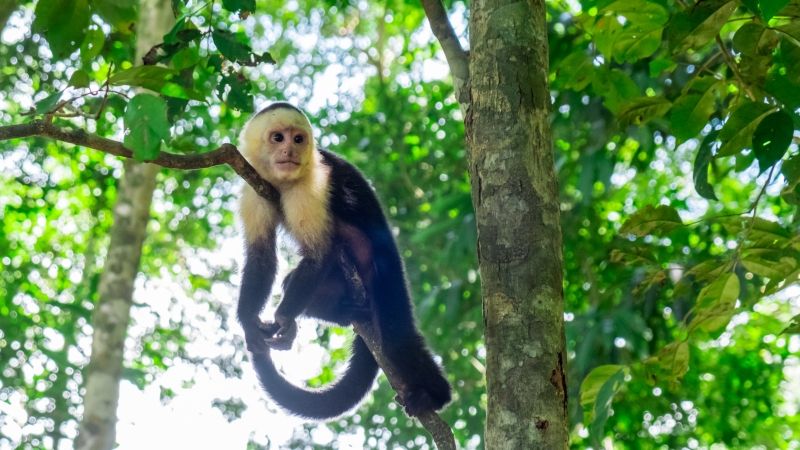
There’s just something about sloths. From their sweet, smiling faces to their laissez faire way of life – the world just can’t get enough of them. Heck, even Ellen DeGeneres has had them on her show.
For the sloths that aren’t starring in YouTube videos or Facebook posts, you can find them in the tropical forests of Central and South America.
If you want to get off your computer and spot sloths in the wild, one of the best places by far is Costa Rica (it has 5% of the world’s biodiversity after all). But there are some things you should know before you go.
Sloths move so slowly that algae grows on their fur, making for excellent camouflage. And they hang out high in the trees sleeping 20 hours a day. However, if you know what you’re doing, your sloth spotting will definitely pick up momentum (you know, unlike sloths). Here’s how to spot sloths in Costa Rica .
Where to go to spot sloths
Monteverde cloud forest reserve.
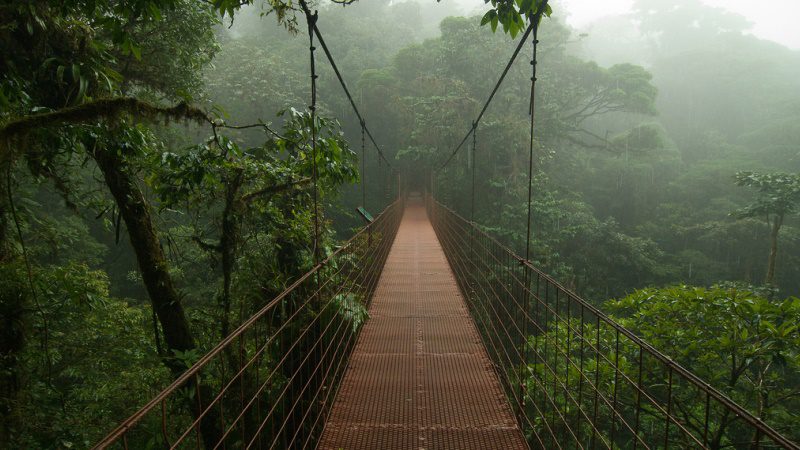
Image c/o Clifton Beard, Flickr
Monteverde Cloud Forest itself boasts 2.5% of the world’s biodiversity. That’s a whole lot of flora and fauna packed in just over 100 square kilometers. Located in the Puntarenas and Alajuela provinces, the cloud forest spans six distinct ecological zones. Within the mist-veiled foliage, there’s a good chance you’ll spot some sleepy sloths there.
Santa Rosa National Park
Santa Rosa National Park is one of oldest and largest national parks in Costa Rica. It’s situated in northwestern Costa Rica, and was once the site of 1856 battle between Americans and Costa Ricans. Nowadays, you can wander the protected park and go sloth-spotting in the tropical forest.
Manuel Antonio National Park
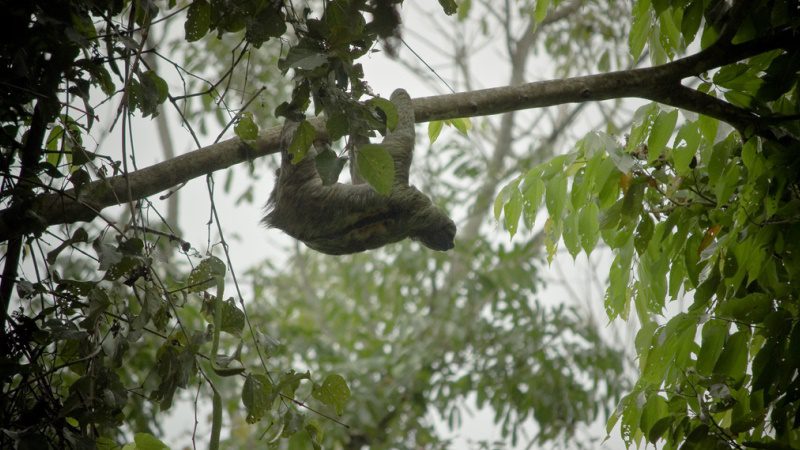
Image c/o Marco Centola, Flickr
Manuel Antonio National Park is located along the Pacific Coast, where forest, swamp, lagoon and beach vegetation blend together harmoniously. Forbes even named the park as one of the most beautiful parks in the world . Here 109 species of mammals and 184 of birds call home, including (you got it) two and three-toed sloths.
La Selva Biological Station
La Selva Biological Station is a protected area in the Heredia Province, which is owned and operated by the Organization for Tropical Studies, a consortium of universities and research institutions. Within this section of tropical rainforest are sloths doing their thing (napping, mainly).
Corcovado National Park
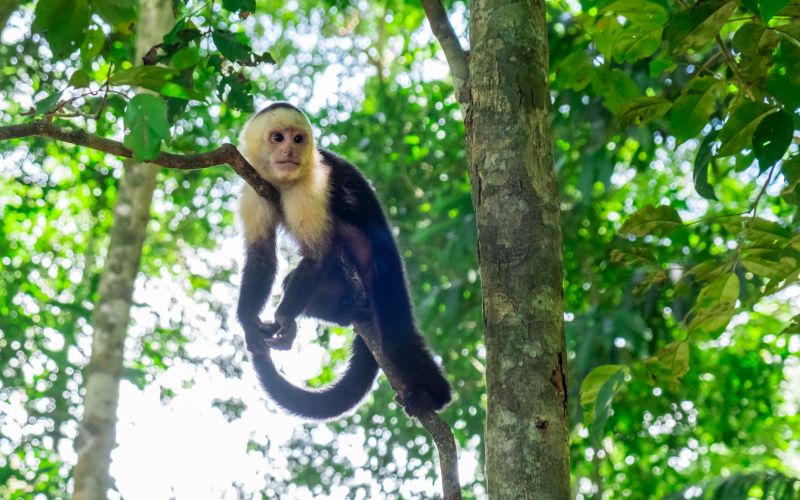
How to spot sloths
- Go with a guide or a local that knows the area
- Be quiet and patient
- Wear neutral-coloured clothing
- Bring binoculars
- Respect the plants and animals in the area
When to go to Costa Rica to spot sloths
Good news for sloth-lovers: these furry friends can be sighted year-round in Costa Rica . So whenever you can get that time off work or wrangle the family for a vacation , sloths will be waiting your visit. After all, it’s not like they’re going anywhere anytime fast.
Ready to spot some sloths? Check our our small group adventures in Costa Rica .
Feeling inspired?
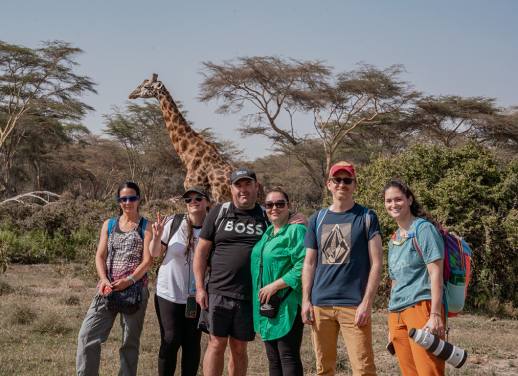
Libby Shabada
Canadian-born nature and animal lover. I travel for the cultural enrichment, scenic views, and tasty eats. Other than being a food enthusiast, I dabble in reading, napping, and amateur crocheting. Yes, I’m in my early twenties. In addition to not acting my age, I try to avoid cliché travel quotes. But it is true that I, “haven’t been everywhere but it’s on my list”. Please never let me say that out loud again.
You might also like
5 reasons to visit sri lanka in the..., why 2024 is the best year to see..., 6 unique experiences you can have in el..., from delhi to udaipur, here are the five..., cinque terre vs amalfi coast: which destination to..., love at first bite: 10 famous sandwiches from..., galapagos or madagascar which unique destination should be..., central vs south america: how to plan your..., 4 reasons you should take a road trip..., lessons learned on intrepid’s sabah adventure, travelling to chile here’s the best time to....

- New Zealand
- North Korea
- American Samoa
- Papua New Guinea
- Solomon Islands
- Philippines
- Vatican City
- Dominican Republic
- Liechtenstein
- Personal Development
- How To Start A Blog
Where To See Sloths in Costa Rica (2024): 11 Top Spots!
April 12, 2023 | Views: 3,758
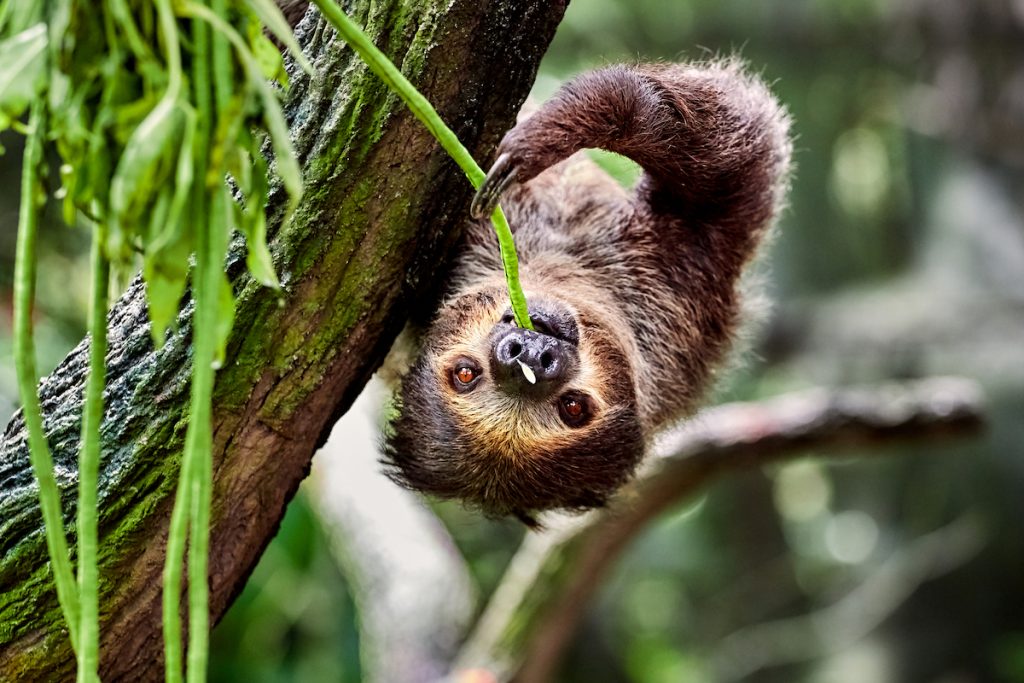
Costa Rica is well-known for its incredibly diverse wildlife , but there are one species in particular that catches our attention… no other in the country has seemed to reach such dizzying heights of icon status as this adorable animal, and tourists on the way there are desperate to know the answer of where to see sloths in Costa Rica.
After the firsthand experience of unravelling the questions at hand, whilst travelling around the country in search of sloth, I hope to arm you with all the information you need to make this happen.
In this article, I will teach you the 2 different types of sloths to look out for in Costa Rica, educate you on your chances of seeing them, and tell you where you can see them and what to expect so that you can pick out which places speak to you.
Table of Contents
Different Types of Sloths In Costa Rica
You will have the pleasure of witnessing two different types of sloths in Costa Rica; a two-toed sloth (AKA Hoffman’s two-toed sloth) and a three-toed sloth (AKA the Brown-throated sloth).
Unsurprisingly, the naming of these different types of sloths comes from the fact that one breed of the little adorable little bastards has an extra appendage, making it distinct from the other.
An important note about these two different types of sloths; the two-toed sloth actually has 3 toes, just like the three-toed sloth does! It’s an extra finger (the claws on their arms) that they have compared to the two “toed” sloths, probably lost in Latin translation to English at some point.
The chances are high that you will see both types of sloths in Costa Rica, so read on to know how to tell the difference between the two, aside from the obvious.
Two-Toed Sloths (Hoffman’s two-toed sloth)
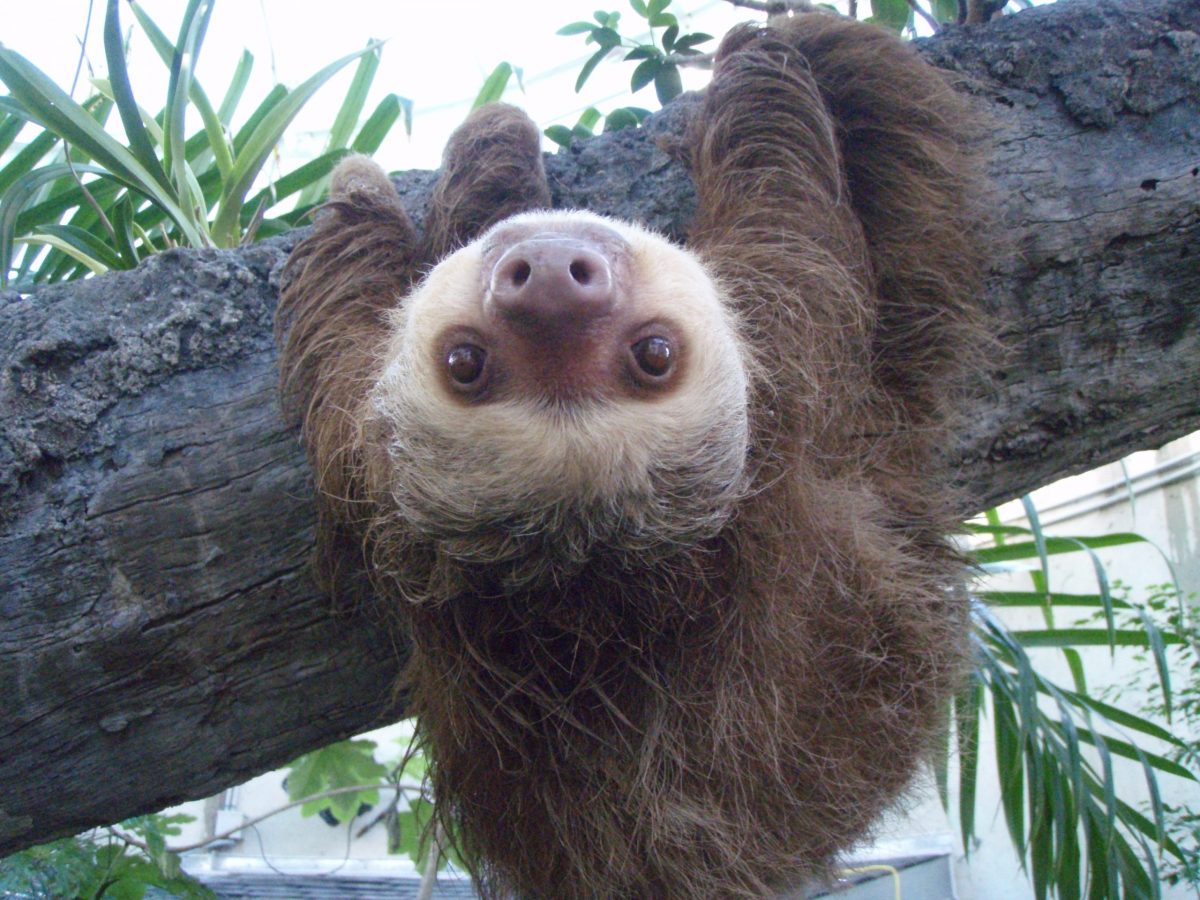
The two-toed sloth is a nocturnal animal with larger eyes than its extra-toed furry Costa Rica citizens. They have distinguishable white-ringed faces, brown noses and rugged coats.
Due to their sleeping pattern, they are the most elusive of the two species of sloths in Costa Rica. Even when you do see one, they are more than likely to be getting some much-needed sleep during the darker hours. If you really want to see a two-toed sloth awake then be sure to book a night hike in one of the national parks mentioned later on in this article.
Three-Toed Sloths (Brown-throated sloth)
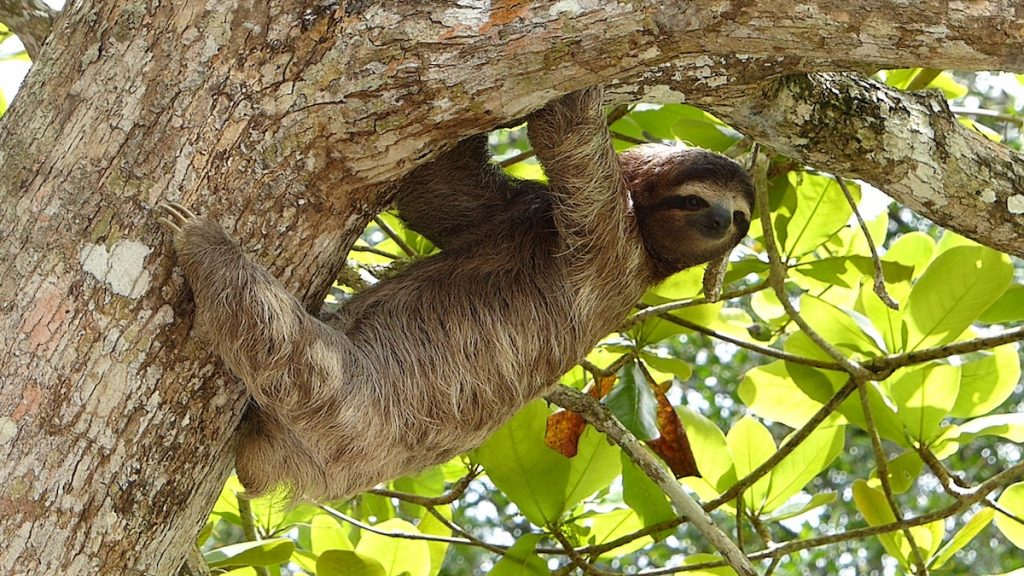
Aside from the distinguishable hand digit difference from the two-toed sloth, the three-toed sloth has a rounder face and a shorter nose. This type of sloth is the more known, iconic sloth of Costa Rica that you often see snapped with a big heartwarming smile.
Three-toed sloths are found closer to sea level in Costa Rica like Puerto Viejo, Uvita and the Osa Peninsula, to name only a few.
Are Both Types of The Sloths in Costa Rica Related?
Interestingly, the two types of sloths that you will see in Costa Rica are not related and are a byproduct of convergent evolution , a phenomenon brought to us by nature when two entirely different species evolve to adopt the same traits by adapting to similar, or the exact same environment.
Differences aside, the two species of sloth share a lot of commonalities. They both live in trees, eat the same kind of diet (mainly herbivorous based on twigs, leaves, and shoots with some insects) although the two-toed sloth has a slightly more varied diet.
They both use their strong claws to hang upside down from the trees in which they live… and they both impressively give birth upside-down!
As they are from a separate family the two-toed sloth and the three-toed sloth can not mate with one another.
13 Fun Facts About Costa Rican Sloths
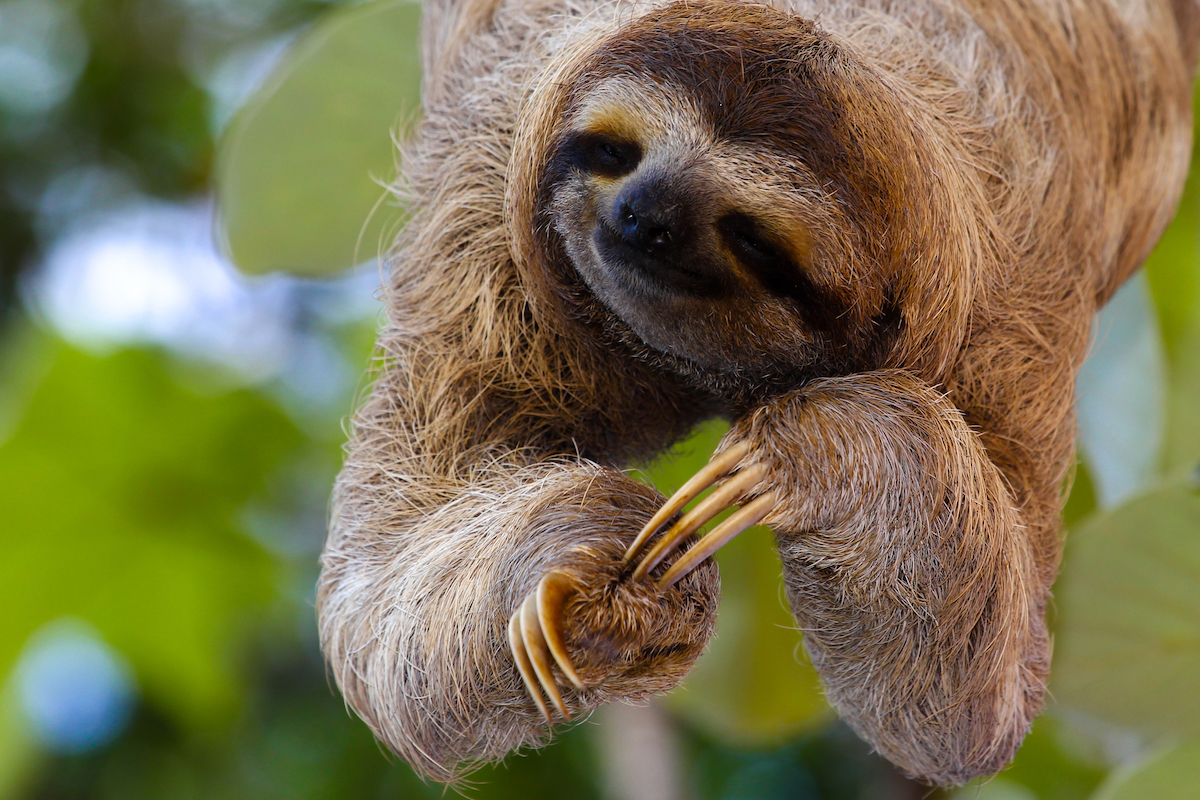
While some exotic animals are celebrated for their size, scariness or majestic nature, sloths are revered for their seeming laziness and never to rush attitude. Even the Spanish word for a sloth, “perezoso” is quite simply the same as it is for the word “lazy.”
Let’s take a closer look at their behaviours and the reasons behind them with these quick sloth facts for beginners list.
- The three-toed sloths are the slowest mammal on the whole planet Earth.
- Sloths live from 20-30 years in the wild.
- Sloths live in canopies, constantly hiding from predators such as large cats and birds of prey.
- Sloths poop (and pee) only one time a week. They prefer to avoid predatorial animals and with them being very slow, it’s a dangerous trip to their bathroom, which is on the ground.
- Their long claws make it difficult to walk.
- Sloths can pull, but not push. Makes sense when you see one walk, as they pull themselves along the ground via their front claws.
- Sloths are fantastic natural swimmers.
- Their diets mainly consist of leaves, which are low in calories but sloths have adapted to have lower metabolic rates and body temperature to balance this out.
- A sloth can turn its head 270 degrees, twisting its neck to look directly behind itself.
- Sloths become incredibly stressed when held by humans. (More on that in this post below).
- Fungi, algae, and moths thrive by growing on the fur of sloths, which also provides camouflage for sloths from hunting animals.
- Sloths can’t survive outside the tropical rainforests of Central and South America.
- An adult sloth is three times stronger than the average human.
Where To See Sloths in Costa Rica
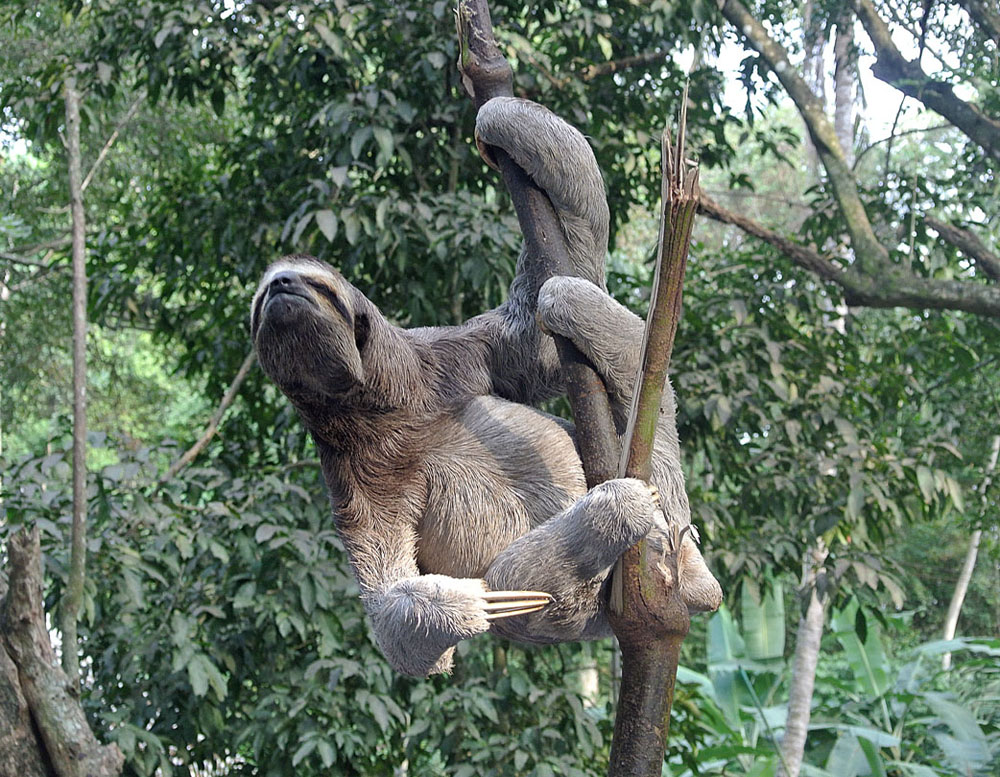
You are much more likely to see a spontaneous sloth in Costa Rica on the Caribbean Coast as opposed to the Pacific Coast, which tends to be a little too dry for the sloth’s liking.
I saw sloths hanging outside of lodges that I stayed at along the Caribbean coastline in Tortuguero and Puerto Viejo, (mostly in trees) and even a few on the side of the road considering a brave saunter to the other side.
If you are really emotionally involved in seeing a sloth in the wild then your best bet is to visit a national park in this region park with a guide.
The exception to this rule is that the more south you go on the Pacific side, the more chance you have of seeing sloths and other interesting Costa Rican wildlife due to favourable all-year-round weather conditions for them.
Try not to fret too much. Costa Rica is pretty much the best country in the world to see a sloth in the wild, due to the aforementioned weather and the government’s famously intense conservation efforts in recent years.
4 National Parks To See Sloths in Costa Rica (Along The Caribbean Coast)
You’ll get a really good bang for your buck looking for sloths in Costa Rica’s national parks on the Caribbean coast. The chances are high for a spotting, they are well-protected and you also have the bonus of potentially seeing other species in their habitat.
Here are four well-known national parks in Costa Rica from the Caribbean side for seeing sloths in the wild, including the usual important travel logistics.
1. Cahuita National Park
If you’re beating the well-travelled Costa Rica trail, you’ll end up in Cahuita town, a sleepy but charming place in Limon Province, by the border of Panama.
The district boasts a decent percentage of the country’s natural beauty, so it’s no surprise that there is a cherished national park in this area. There are decent chances of seeing a sloth in Cahuita National Park, I saw 4 two-toed sloths during my half-day there although they also have three-toed sloths living there.
- It’s free entry (a donation is an option)
- It’s the most easily accessible national park in Costa Rica (town to national park travel is easy-peasy)
- O pen 6 am -4 pm
- Other cool wildlife: Howler monkeys, long-legged spider monkeys, coatis, poison dart-toads
- Local beaches are lovely
- It’s close to Puerto Viejo (a popular tourist stop)
- Local tourist guides can be a little pushy for you to give them business as you walk around
- Aggressive monkeys (be careful with your food on display)
2. Tortuguero National Park
Also located in Limon Province, Tortuguero National Park is known for its abundance of wildlife, including our beloved sloths of course.
Chances of seeing a few here are also not too shabby with both the two-toed and three-toed species being known to make an appearance during wildlife-spotting hikes in the park, I saw 2 immediately upon walking into the park.
- The park is a couple of hours’ drive from the capital, San Jose
- Other cool wildlife: Capuchin monkeys, toucans, kingfishers, caiman, crocodiles and most notably sea turtles – which is actually the main attraction as it’s an important nesting site, with a solid conservation effort to help protect this endangered species
- Many of the guides are cool, indigenous locals who are incredibly impressive at spotting sloths (and other animals)
- The park is not very well maintained in parts and has plastic garbage lying around
- The local town to base yourself in is very boring
- The $15 USD admission fee is not good value for money when compared to other national parks and what they have as a full package
3. La Amistad National Park
La Amistad National Park is a World Heritage Site straddling Costa Rica and Panama and is also the largest national park in the country.
This remote part of the Talamanca Range gives birth to a multitude of gorgeous trails for hardcore hikers. But that’s not why you’re here, so what are the chances of seeing a sloth in La Amistad National Park?
To be honest, your chances are very slim. Doable, but not probable compared to the other picks here, but it’s worth pointing this out in case you were heading this way.
- Relatively cheap admission ($10 USD)
- Local guides are friendly low-pressure and relaxed
- Fewer tourists (off the beaten track)
- Hikes could be too hard if you’re not very experienced or fit
- Sloth sightings are possible, but not worth putting all your hopes into seeing them in this particular park, as others have a much better chance
4. Arenal Volcano National Park
I’m admittedly being a little bit cheeky adding this one in the Caribbean coast side as it’s located in the centre of northern Costa Rica, but I thought it was worth an honourable mention because I saw sloths here, it’s beautiful and it’s also a perfect day trip from La Fortuna.
Whilst there aren’t high volumes of sloths in Arenal, the chances of seeing them are high as there is a trail located 600 metres from the park, which is famous for sloths chilling out there in their own habitat.
- The volcano is beautiful on a clear day, especially if you catch it with the smoke coming out of the top
- Easy hike for those with lower fitness levels or no desire to hike to see a sloth in the wild
- Hot springs are nearby for an additional fun activity
- It’s relatively small, so not worth the effort unless you’re passing through there already
- Not a great amount of wildlife in comparison to others
- You can’t climb the volcano (it’s not permitted and illegal)
- Personally, I don’t think the $15 USD admission fee lived up to my highly volcanic expectations
3 National Parks To See Sloths in Costa Rica (Along The Pacific Coast)
The Caribbean coast side of Costa Rica may be the most efficient place where to see sloths in Costa Rica, but that doesn’t mean you’ll leave the Pacific coast side disappointed.
Although they may be a little shyer, less in numbers and more elusive to spot; there are still options to get your dose of these delightful, ridiculous creatures.
1. Corcovado National Park
Gear up for this one, folks. This place is not only gorgeous but also described by National Geographic as “ the most biologically intense place on Earth ,” due to its size and also high concentration of diverse animals and plants.
This national park is absolutely teeming with wildlife.
You will see many endangered species in their natural habitat and this is quite possibly your best chance of seeing both species of sloth in the wild.
- It’s so diverse that a sloth sighting is almost a guarantee
- Much extra cool wildlife to potentially spot (this national park has over 50% of the country’s biodiversity)
- Requires additional air travel due to isolated location and at $300 USD each way (or you can travel via boat from Drake Bay)
- Tour guides are mandatory here
2. Manuel Antonio National Park
Expect more busy human traffic at this park, particularly during peak season but sloth-seeing bucket list collectors should consider a guide for this park .
If you go during shoulder season you might luck out with fewer tourists, but with the park being a lot smaller and more degradation to part of its trails, you might have to manage your expectations if you have been to national parks within the country with more funding maintenance.
While seeing a sloth here is certainly doable, the often overcrowded park is best explored with an experienced guide if you don’t want to leave disappointed, bereft of a sloth-spotting.
- Big chance of seeing both kinds of sloths (most important pro)
- Beautiful local beach es
- Other cool wildlife to spot: White-faced monkeys, iguana, white-tailed deer and chameleons
- The place is really badly organised, you will queue longer than necessary and some shady locals will pose as staff for extra money
- Muggings are common in the nearby town of Quepos
3. Monteverde National Park
Nearby Santa Elena is a popular tourist hub and also a gateway to visit Monteverde National Park. The cloud forest here is complete eye-candy, but you have to earn its beauty as the roads are sketchy to navigate (you will need a 4×4 to access the park if you’re not paying for a tour).
Once you get there you’ll see that the trails are well looked after and well-prepped for a sighting of those adorable balls of fluff.
You can see sloths here, but with a slight caveat; only the two-toed sloth inhabits Monteverde.
And remember that this type of sloth is nocturnal, so you are more than likely going to have a successful sloth viewing in Monteverde during a night hike with a guide.
- As far as National Park restaurants go, the in-house restaurant was very impressive and even has vegetarian options
- Multiple trails to explore (if you’re that way inclined)
- Paths are easy to follow and well-maintained
- Those looking to see a sloth are limited to one species of sloth and more than likely only to have a successful viewing of one during the nighttime
- $25 USD admission fee before potential (hard-selling) tourist guides is not the best value for money
4 Sloth Sanctuaries in Costa Rica
Costa Rica has some high-quality sanctuaries to see sloths that have been rescued and protected from other bad human behaviour or just general bad luck down to being the slowest mammal on earth!
While many faux animal sanctuaries exist in the world, these 4 have a gold star reputation of not only where to see sloths in Costa Rica, but genuine welfare and concern for the animals.
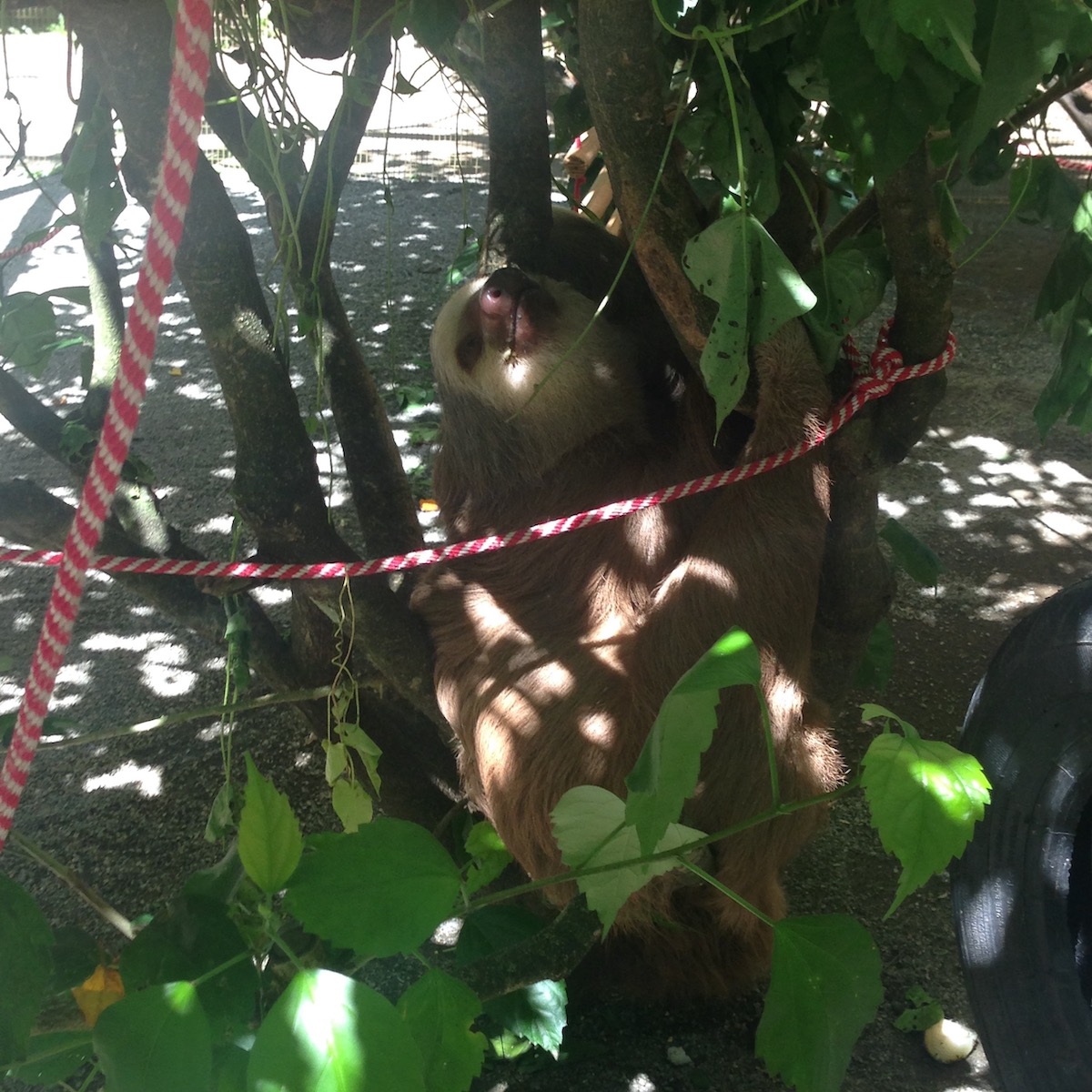
I’m going to assume one of three things here.
The first is that you’re embracing the sloth attitude and you simply can’t be arsed to do all the adventurous Costa Rica stuff, so you’d rather visit a responsible sloth sanctuary instead.
The second is that you’ve tried and failed to see sloths in the wild and that this section is your last chance saloon.
The third is that you’re like me and you’re greedy. You are a sloth addict now and after clearing out the national parks you also want to visit a sloth sanctuary in Costa Rica , safe in the knowledge that your money is supporting a good institution.
The following sloth sanctuaries in Costa Rica have been hand-picked by me after hours of intense due diligence and personal experience.
1. Aviarios del Caribe
Also known as the wildly creative name of “Sloth Sanctuary,” this establishment in Cahuita was the original rescue centre for orphaned, injured and abandoned sloths.
The Sloth Sanctuary studies and observes the animals and its findings work in unison with other sloth sanctuaries around Costa Rica.
Guaranteed viewing of both the two-toed and three-toed sloth in this pioneer of Costa Rican sloth sanctuaries.
2. The Sloth Institute
Another sloth sanctuary in Cahuita with a glowing reputation for its welfare of sloths. The guides are fantastic and knowledgeable and you’ll leave with a deeper understanding of the animals regarding their habits and struggles.
Just like its neighbour listed above (Aviarios del Caribe) this institution is big on research, education and conservation.
According to the institute, they are not an official sloth sanctuary, but a non-profit organisation with a focus on sloth welfare and behaviour. Regardless of semantics, The Sloth Institute is still a worthy addition to the list of sloth sanctuaries in Costa Rica.
3. Alturas Wildlife Sanctuary
If you haven’t exceeded your daily quota of cuteness, check out these 2 baby sloths from both species of sloth in the video above, recorded at Alturas Wildlife Sanctuary in Dominical.
You have very good odds of seeing not one, but many sloths here, including baby sloths. Not sure you can get much better than that!
4. Jaguar Rescue Center
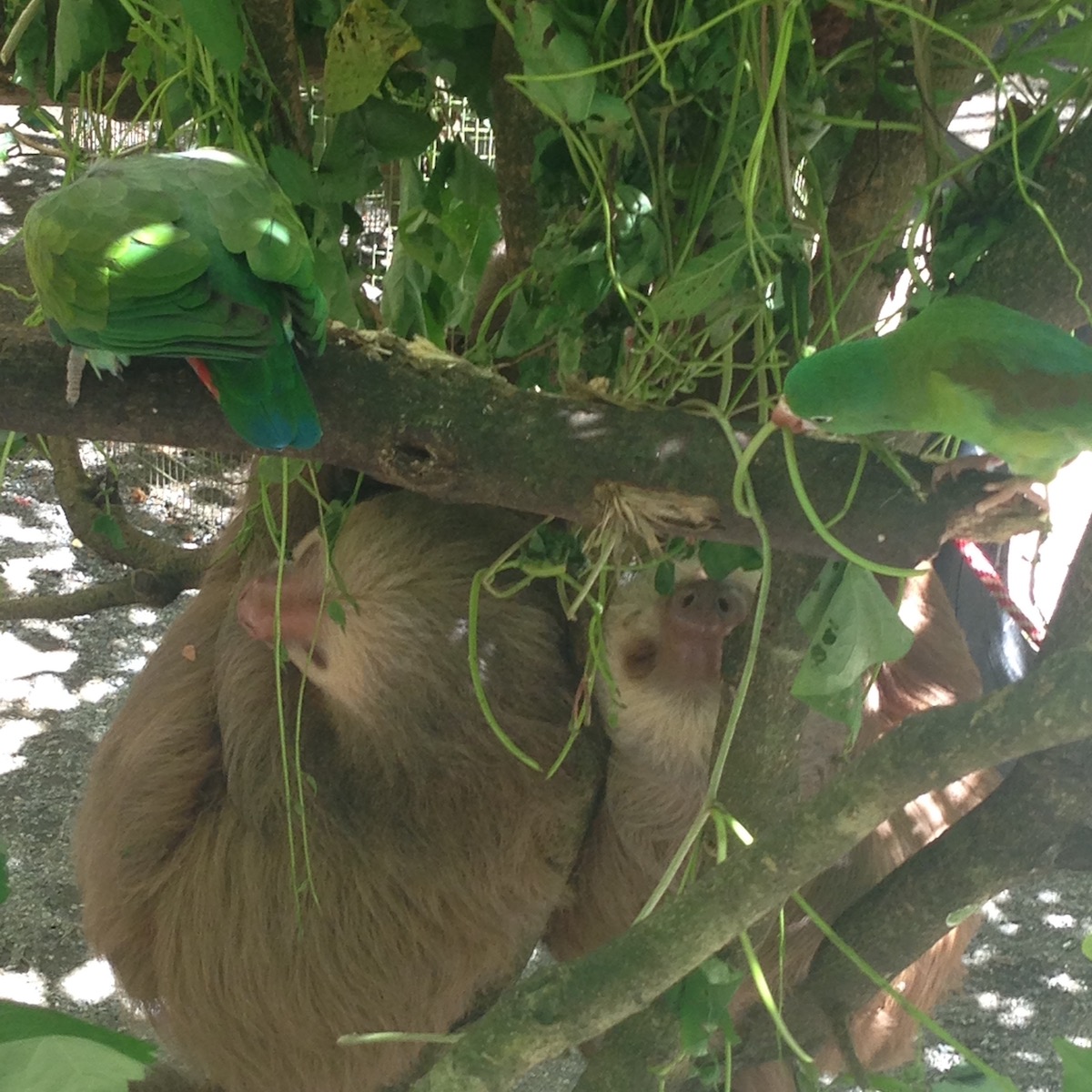
Yep, you read it correctly. It says Jaguar, but the reality after visiting this place is that the sloths get quite a lot of the limelight here, I felt like they were the main attraction and the majestic jaguar was more of an afterthought.
The jaguar is a mere cool addition to the centre, but like most big cats it’s incredibly isolated and elusive by nature. I saw many sloths in this place while staying in Puerto Viejo and thoroughly enjoyed getting one more sloth fix.
There wasn’t too much human traffic and the animals looked well on their way to rehabilitation. This place is an absolute must-do while visiting Puerto Viejo.
The extra wildlife there was a lovely cherry on a very sweet cake after getting more than a fair share of sloth-spotting during my time in Costa Rica.
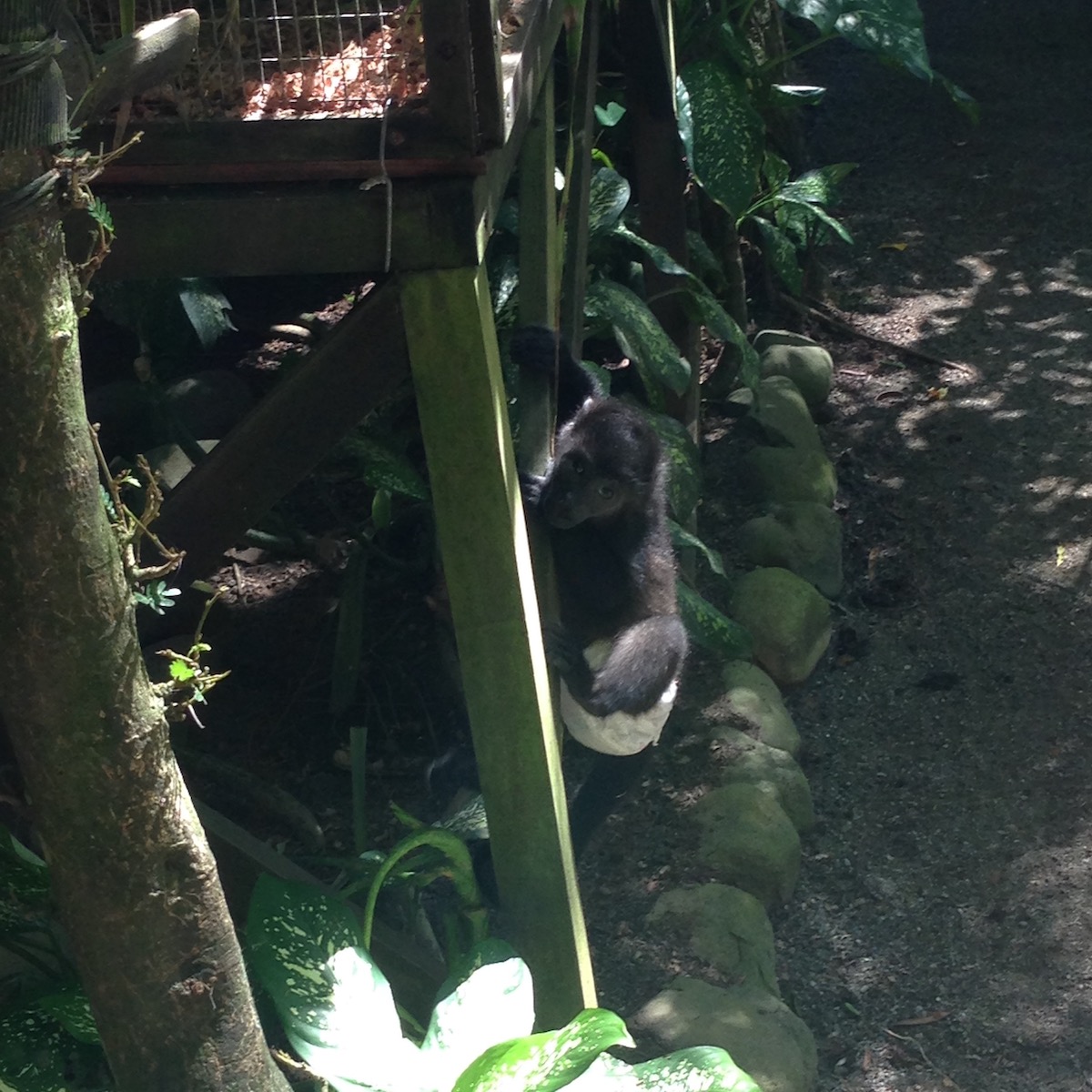
Where Can I Hold a Sloth in Costa Rica?

The Costa Rican government takes their wildlife protection so seriously that they made it illegal in 2019 for people to take selfies with any type of wild animal, hammering home their point with an aggressive #StopAnimalSelfies social media campaign.
According to a study by World Animal Protection , although the animals seem smiley and relaxed while hugging humans, sloths in their natural state that were handled by tourists felt heightened anxiety and fear, reduced appetite, followed by sleepless nights after the well-intentioned embrace.
I’m sorry to be that guy, wagging his finger disapprovingly at you but a better question than “ Can I hold a sloth in Costa Rica,” is “ Should I hold a sloth in Costa Rica?”
I know, I know. No one likes a smart-arse, but hear me out…
For starters – I’m not judging, I wanted to hold one too and for full disclosure, I once shared an embrace with a similar-looking Papua New Guinea animal known as the “cuscus” a few years before my Costa Rica trip.
That was long before I started to think deeply about the ethical dilemmas of animal tourism . This concern led to information which resulted in me making peace with the fact that I would not be hugging these absurdly cute creatures while travelling in Costa Rica and much like the nervous suicidal Tarsier ; I gave the sloth plenty of space while I admired its existence.
An extra reason to just admire these creatures from (reasonably) afar is the establishments that allow you to hug sloths at your request are quite possibly a cog in the wheel of a nefarious business operation where sloths are taken from their habitat, purely for the sake of sloth-selfies in faux-sanctuaries.
Summary: 8 Guaranteed Tips For Seeing a Sloth in Costa Rica
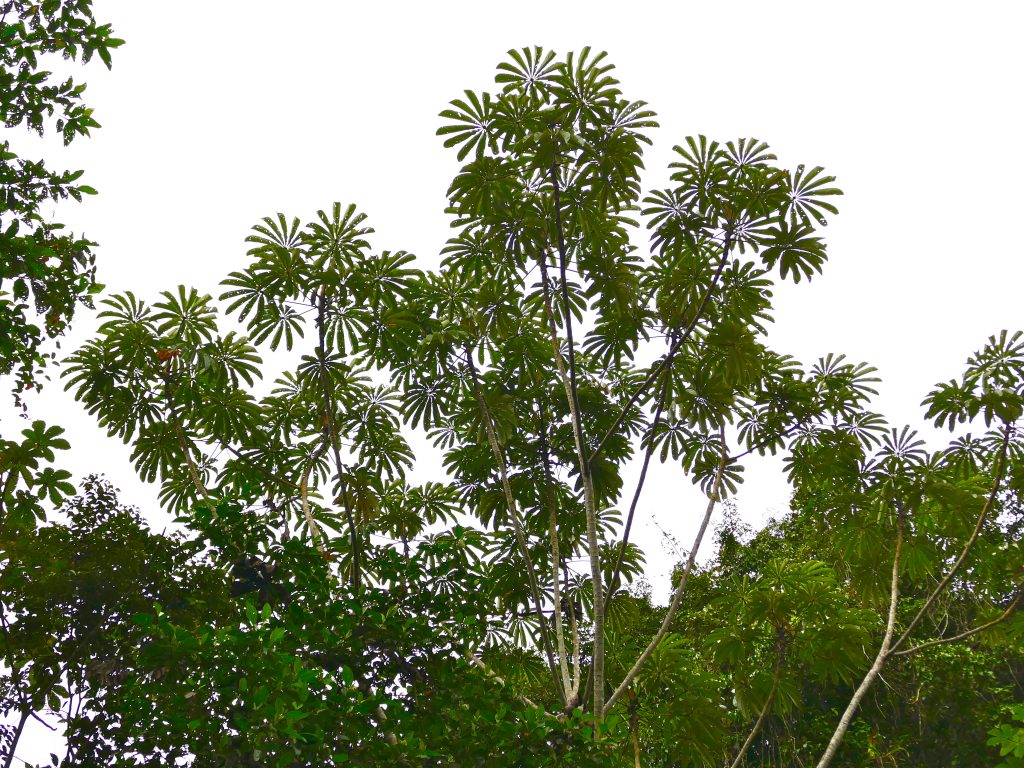
I hope that after reading this post you are feeling the same peace of mind that I left Costa Rica with, safe in the knowledge that you will get to see sloths during your visit.
You may have to do some planning and prioritising before or during your trip, but if you follow this guide it shouldn’t be too long before you are the envy of your cute-animal-loving friends and family.
You should be an expert by now, but just in case you weren’t listening/reading with full attention due to the cute sloth photos, here is a reminder for a guaranteed sloth sighting in Costa Rica…
- Memorise and look out for a Cecropia Tree (pictured above). The Three-toed sloths love to hang out here.
- Focus on the Caribbean Coast if you are short on time and want to see sloths in the wild.
- If you are on the Pacific Coast then venture south to see sloths in the wild.
- Go to National Parks and pay extra for an experienced guide if you’re really keen on improving your chances.
- The two-toed sloth is nocturnal, so best to hire a night guide to see one, or simply visit a sanctuary.
- The two-toed sloth has a more varied diet. So they are easier to reintroduce, meaning a sanctuary is your best bet if you haven’t seen one yet on your sloth mission.
- Remember those sanctuaries that allow you to hold sloths are not legitimate sanctuaries. It’s best to fund an establishment that will use your money for the welfare of Costa Rica’s beloved animal.
- Look out for sloths in the water! Sloths are actually very competent swimmers and you might see one taking a dip if you’re lucky.
Now y ou are an expert on where to see sloths in Costa Rica, the subtle differences between these two endemic species and how to make sure you don’t leave the country without the painful, inconsolable dread of a sloth-less experience.
Heading to Central America? Here’s more content on the region:
- How To Nearly Die Scuba Diving in the Great Blue Hole
- Best Things To Do in Caye Caulker, Belize
- How To Cross The Mexico-Belize Border
- San Blas Islands Travel Guide
- Volcano Boarding in Leon, Nicaragua
- Pacaya Volcano Sunset Hike
Before you go:
- Are you insured? I used SafetyWing Nomad Insurance for visiting Costa Rica
- Travelling Solo in Costa Rica? These travel safety tips will help
- Check out my best travel gear for men list!
Anthony Middleton

Hi, I'm Anthony!
In November of 2010, I took on a mammoth challenge against the clock in a quest to upgrade my miserable life. I went out of my comfort zone and turned it all around. Ten years later, I’m completely location independent…

Read All About Central America and Costa Rica
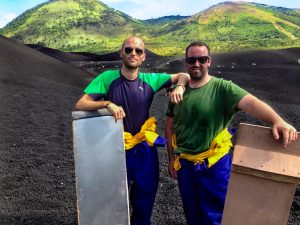
Volcano in Boarding in Leon, Nicaragua (Cerro Negro)
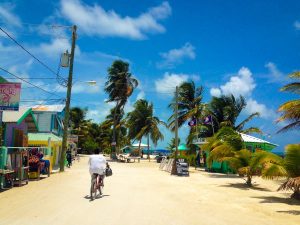
17 Best Things To Do in Caye Caulker, Belize in 2024
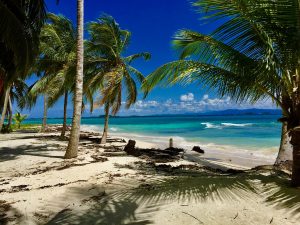
San Blas Islands Travel Guide: Best Things To Do & Logistics


Where to See Sloths in Costa Rica
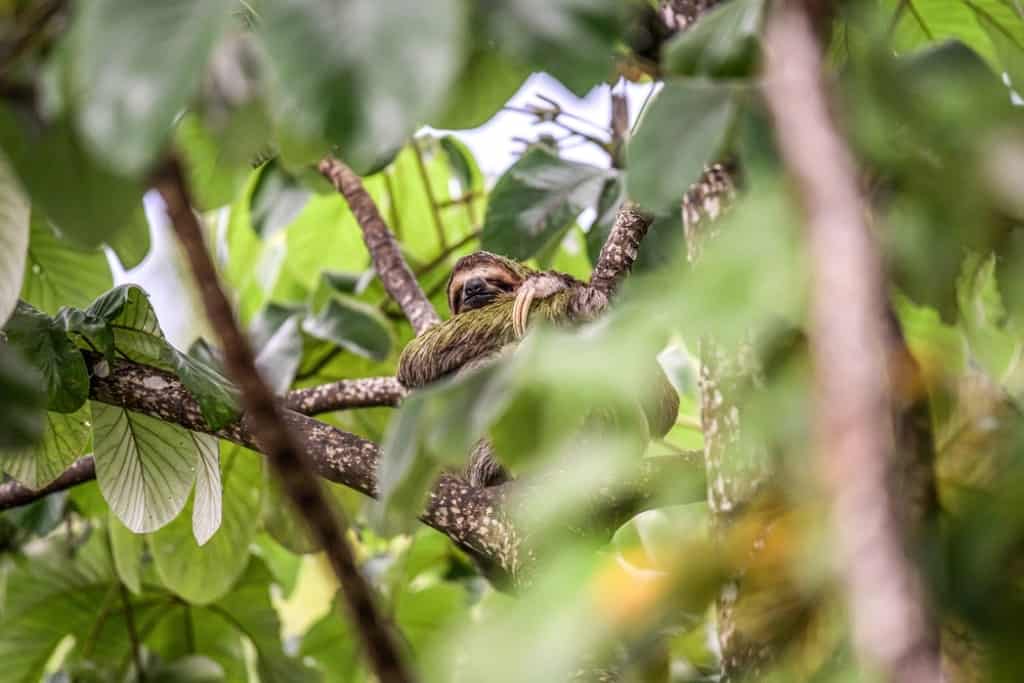
Costa Rica is thought to be home to approximately 5% of the entire world’s biodiversity – that is, all plants and animals found on the planet.
Due to Costa Rica’s equatorial location, coupled with prime climatic conditions, life has exploded. One particular mammal found in Costa Rica has taken the world by storm. A mammal that resembles a motionless ball of fur. Meet the sloth!
Read on to discover more about these lazy mammals, and some of the very best places in Costa Rica to spot them in the wild.
Disclaimer: This post contains affiliate links. This means that should you click on certain links, and then subsequently purchase a product, I will receive a small commission.
Table of Contents
What are sloths?
Sloths are a type of arboreal mammal found throughout the rainforests of Central and Southern America. They have found fame for being one of the slowest animals alive today, typically moving no more than 40 meters per day.
Due to this largely sedentary lifestyle, sloths have an incredibly low metabolic rate. This means they spend up to 20 hours sleeping. The remaining hours are spent munching away on leaves and other foliage.
All sloth species are largely arboreal. However, they do occasionally venture down to the forest floor. In most instances, this will be to urinate or defecate. Approximately once a week, a sloth will make the arduous journey down the canopy and onto the dangerous forest floor. We still don’t fully understand why sloths do this.
Across the Americas, there are 6 species of sloth. In Costa Rica, you will find two species: Hoffman’s two-toed sloth and the Brown-throated Sloth. Let’s explore these two species in more detail.
Species of Sloths in Costa Rica
Hoffman’s two-toed sloth.
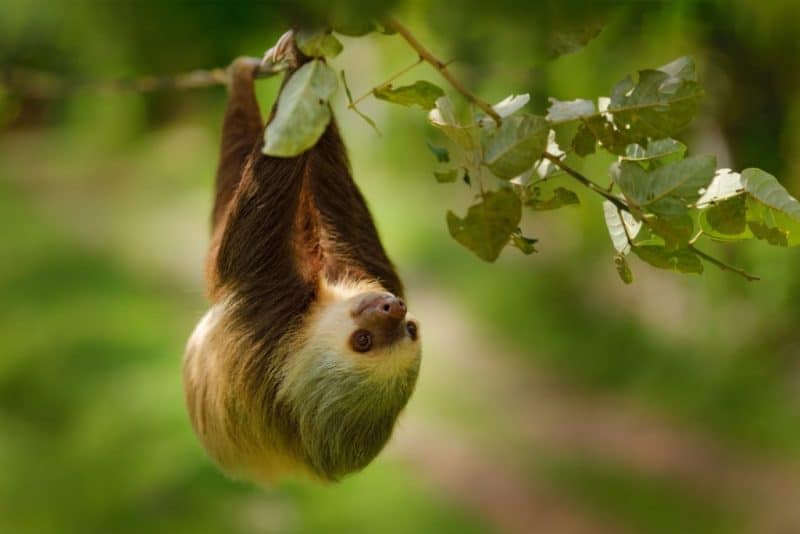
Reaching up to 12kg in weight, Hoffman’s two-toed sloths are one of the larger arboreal mammals in Costa Rica. Largely solitary and nocturnal, and found high in the canopy, they can be difficult to spot.
As the name suggests, two-toed sloths have two toes on their forearm. Large, curved claws can be found at the end of their toes, which they use to grip onto branches.
Two-toed sloths are slightly more active than their three-toed relatives, moving from tree to tree in search of food. Their diet consists of leaves, buds, twigs, fruits, eggs, and small vertebrates. They have large, peg-like teeth that they can use when threatened.
They have shaggy brown fur, which has been known to turn green. This isn’t bad hygiene. Rather, this is an evolutionary advantage, as it allows the sloth to camouflage into its habitat. The green coloration is caused by an ecosystem of algae and fungus, which in turn, attracts moths, beetles, and mites.
Brown-throated Sloth
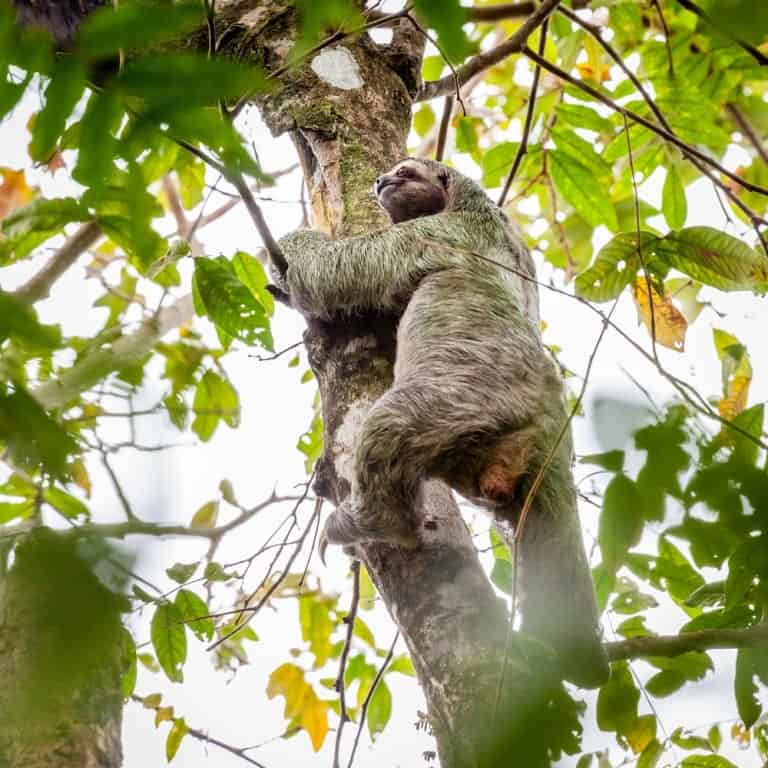
Smaller, no heavier than 6kg, the brown-throated sloth can often be found in the guarumo tree; its’ favorite food source. Unlike two-toes sloths, three-toes are strict folivores. This means they can only eat leaves. Whilst many can eat a large diversity of leaves, most will choose just a few different species of leaves, and guarumo is a firm favorite.
Three-toed sloths are fine-tuned to the environment, and as a result, are much more sensitive to environmental changes. They can only be found in certain regions of Costa Rica, and have adapted to specific conditions.
Not only are three-toed sloths smaller, but they also have different physical appearances. A small tail can be found, which is used to help the animal dig shallow holes on the forest floor. These holes are thought to be makeshift lavatories.
Best Places to Spot Sloths in Costa Rica
Arenal Volcano National Park is one of Costa Rica’s most visited destinations. Found in the province of Alajuela, the tropical rainforests around Arenal are home to many sloths.
One of the highlights of the region is booking on to the sloth-watching trail, found just outside the main town of La Fortuna. With a knowledgeable and bilingual guide, you will be taken around 2 kilometers worth of trails, set amid a 20-hectare reserve.
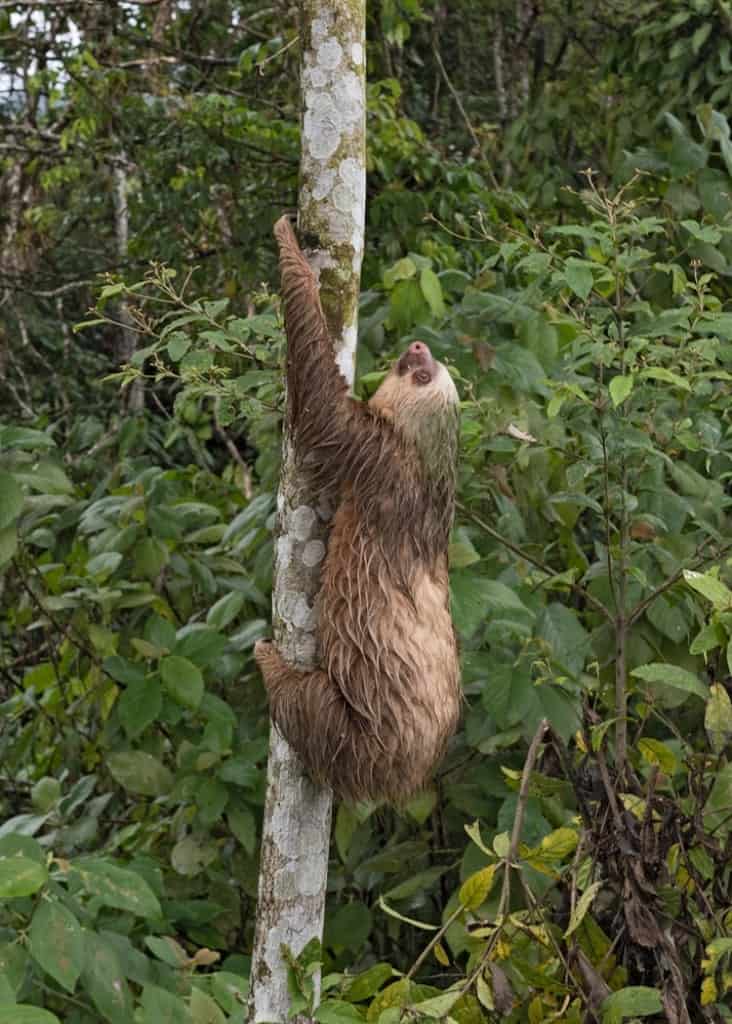
Expect to see multiple sloths in their natural habitat, as well as many other species that call this jungle home.
To find out more about sloth watching in Arenal, click here .
Just a stone’s throw away from Arenal, a rolling expanse of verdant jungles and cloud forests can be found. Welcome to Monteverde National Park. Covering an area greater than 105sqkm, this National Park is home to an incredible diversity of life.
Due to the higher elevation of Monteverde, the climate can become quite chilly. Due to this, only the two-toed sloth can be found here. Due to the nocturnal behavior of two-toed sloths, we recommend booking a night tour of the National Park.
Private tours can be organized, with prices starting from $40. Liberate your senses with a professional and experienced guide. One of the top tours in the region is Refugio De Vida Silvestre .
We appreciate spotting sloths in the wild can be quite the challenge, so why not discover Selvatura Park. This ecological park is home to about 20 sleepy sloths, many of which have been rescued. In a guided tour, you can get up close and personal (but no touching or selfies) in a natural and large enclosure. Click here to book your spot.
Puerto Viejo
Famed for being one of the best places for seeing sloths in Costa Rica, Puerto Viejo is home to both species of sloths. Take a trip around the world-renowned sloth sanctuary, where you will gain an insight into the behavior of these iconic residents. Tours operate daily, starting from 8 am.
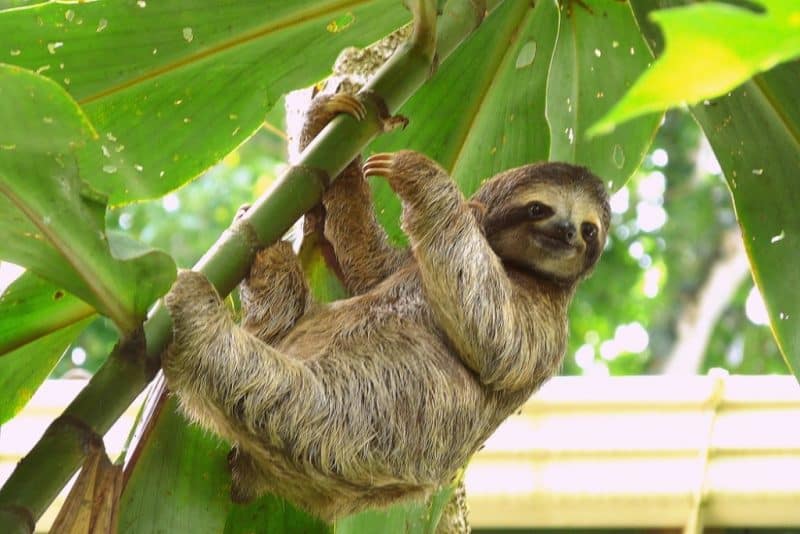
Guides will introduce you to some of the rescued sloths, share stories of how they arrived, and delve into the conservation work underway to protect this iconic species. To book your tour, follow the link below:
If you would like the chance to spot sloths for yourself, head out for a guided walk through the forests of Cahuita National Park. Just under 3000 acres of protected rainforests, Cahuita plays host to an amazing diversity of life. Crane your heads to the canopy, as you search for the sloths. Click here for more information and to book a tour .
One of the most remote regions of Costa Rica, Tortuguero is only accessible via boat or plane. This, however, does not stop tourists from visiting this ecologically diverse landscape. And for good reason too. Within the 312kmsq National Park, expect to find both species of sloth, as well as monkeys, big cats, and tapir.
There are a few different, and unique, options for viewing sloths in Tortuguero. You could book a kayak tour, which would allow you to silently meander through the many waterways and canals, deep into the forests of Tortuguero.
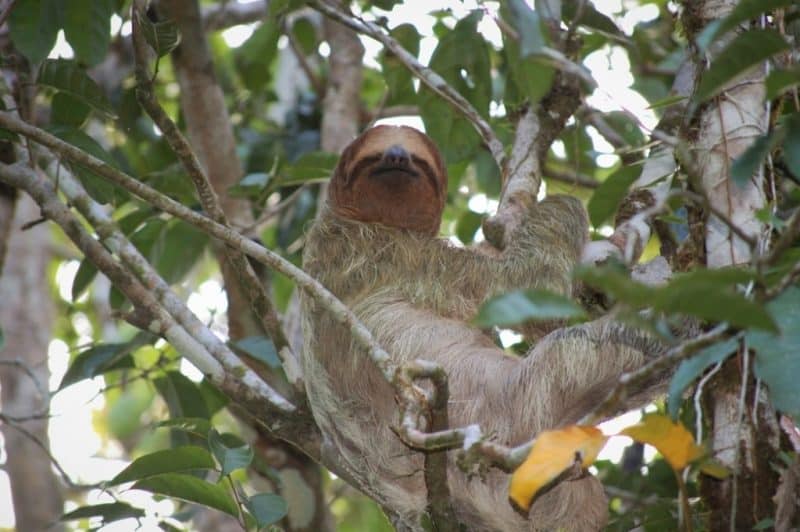
You can also book a terrestrial night tour, departing from the main town of Tortuguero. These tours often support local businesses and the economy of the region. Many of the locals of Tortuguero have lived here their entire lives, and know exactly where to look for sloths.
Tour times vary but expect each to last between 2-3 hours. Bilingual guides and binoculars are provided. Discover more about the tours on offer in Tortuguero by clicking here .
Sharing is caring!
Leave a Comment Cancel reply
Save my name, email, and website in this browser for the next time I comment.

Costa Rica Guide
Travel information and maps, best places to see monkeys & sloths in costa rica.
It’s not as exotic as the end of a muddy trail through the remotest rain forest but the trees along the highways and roads are one of the easiest places to see sloth and monkeys especially if you’re riding with a guide or local driver. Of course national parks and wildlife refuges provide opportunities as well and we’ve described the best in each region of Costa Rica.
Looking for monkeys and sloths in Costa Rica is a bit like searching for a needle in a needle stack – they’re everywhere.
The Best Places | Southern Caribbean | Northern Llanuras | Volcanoes | Southern Pacific | Central Pacific
But There Couldn’t be a Sloth Here
We were traveling friends on their first visit – two other couples and their five pre-teens. We spent a few days at the Volcano where we saw mono congos every morning.
In the pre-dawn light when the monkeys started calling from the trees bordering Arenal Springs Resort I’d round up the kids and we’d take a 100 meter expedition into the forest following the sound until someone spotted movement. It was nearly impossible to drag the kids away for breakfast so I had to rely on the monkeys’ tendency to move off in search of forage for their own morning meal.

No one really wanted to leave, but everyone did want to go to the beach so we loaded into a busetta, rounded the lake, crossed the continental divide and headed down the big hill from Tilarán to the hot, dry plains of Guanacaste – destination Playa Hermosa.
Because Sue and I spend so much time surrounded by wildlife it’s hard to remember what our guests have seen and what they haven’t so I was a bit surprised when I heard one of the girls tell the driver, “the monkeys are fun but I really want to see a sloth. We haven’t seen a sloth.”
I was even more surprised and a little concerned when I heard the driver reply, “oh don’t worry we’ll see one soon.”
If he had made the promise an hour earlier while we were in the lush Caribbean rainforest along the shores of lake Arenal I would have figured “no problem,” but here we were in the middle of hundreds of square miles of grassy pasture. The skyline was broken only by the live fence posts and an occasional cluster of trees along a small quebrada.
I know better than to doubt the keen eyes of the locals but with nearly no habitat around I thought the driver had bitten off more than he could chew.
I could hardly believe it when he slowed the bus, pulled over to the shoulder, opened the doors and pointed about ten feet up the branches of a Gliricidia sepium ( living fence post tree ) and said “there, right there!” Sure enough, a Brown-throated Three-toed Sloth ( Bradypus variegatus ).

I’d never seen a sloth around there before and have never seen one since even though I look really hard now and I frequently pass that way. The photo above was taken on another day in Manuel Antonio because I was so surprised that afternoon at Tilarán that I never got my camera out.
Best Places to See Monkeys and Sloths
In the trees of course. Sorry, I couldn’t help myself, but that brings up another piece of advice that’s nearly as obvious and not at all facetious.
It would be hard to travel for a week in Costa Rica without seeing monkeys or sloths in the wild but it does happen. If you want absolutely no chance of heading home disappointed visit a wildlife rescue. You’ll get up close with the animals and be doing a very good deed as well since these worthy causes are normally supported by admission fees.
Caribbean Coast

The southern half of the Caribbean has great trails for wildlife watching and is dotted with tiny deserted beaches
Jaguar Rescue , Puerto Viejo de Talamanca on the southern Caribbean coast is part of the La Ceiba wildlife refuge and works to rehabilitate and reintroduce injured animals. [ odds – 100% guaranteed ]
Gandoca Manzanillo wildlife refuge protects the last 20 km of Caribbean coastline starting near Puerto Viejo and extending to the southern border with Panama. The northern half of the refuge is slit by the road and actually includes dozens of little bungalows, hotels and restaurants along Playas Cocles, Chiquita and punta Uva that were built before its designation. There’s a good chance you’ll see sloths or monkeys while staying or eating at any of them but if you get a local guide and hit the trails of the unpopulated southern half of the refuge it’s almost certain. [ odds – 95% with a guide, 70% without a guide ]
Sloth Sanctuary (aka Aviarios del Carib), north of Cahuita started out as a wildlife refuge mainly designated to protect bird habitat but as you’ll learn when you visit an injured sloth changed all of that. Now one of the premier sloth research and rehab centers in the world. [odds – sloths 100% guaranteed, monkeys 90% ]
NOTE: In mid 2016 a blog post reported that the Aviarios del Carib sloth sanctuary was not providing appropriate care and not releasing rehabilitated animals. We can’t verify or refute the article because it’s been a few years since we visited. What we can say is that when we did the “behind the scenes tour” for journalists and scientists we didn’t see evidence of abuse but were told several times that “sloths were very difficult or impossible to reintroduce into the wild and would probably be kept in cages permanently” – the main complaint in the blog post.
Aviarios del Carib has done amazing things over decades of rescue efforts but much of what’s written in the article quoting former veterinarian employees rings true. It’s possible the rescue has been overwhelmed and is failing in the challenge to benefit the animals. Whether discontinuing visits and thus effectively eliminating financial support is the proper response is not clear. We’ll be visiting again in a couple of months to judge for ourselves.
Central Pacific
Manuel Antonio National Park is perhaps Costa Rica’s most famous wildlife viewing destination and rightly so. There are dozens of qualified guides who know every inch of the trails and also communicate with each other about the location of sleepy sloths (they rarely move very far during the day) and troops of monkeys. If you want the very best odds of seeing sloths or monkeys in the wild include Manuel Antonio in your vacation. [ odds – 99% with a guide, 90% without a guide ]

Jacó is a surprise entry on this list. When we first visited over twenty years ago Jacó was seedy little beach town catering mainly to San José weekend getaway debauchery with legal prostitution and dark smokey bars. It’s cleaned up its act and targets surfers and tourists now but when you see all the high rise condo towers you’ll probably still wonder if we made a mistake including it on a wildlife list. Nope.
Heading inland from the south end of town there’s a dirt road leading up to the communication towers on Fila Chiclera where you can continue on the road or choose one of several unmarked trails down and south towards Calle Hermosa. The birdwatching is excellent (mot-mots, toucans, macaws) and we nearly always see monkeys when we walk here, though sloths are rare. [ odds – 75% ]
Hacienda Barú National Wildlife Refuge is one of our favorite spots on earth and one of the best places in Costa Rica to see wildlife. Whenever we have guests it’s near the top of our list of places we want to spend a few days, staying in the simple cabins, walking the trails and enjoying the miles long nearly deserted beach. There are several resident troops of white faced Capuchin monkeys and often you’ll see a spotting scope set up next to the restaurant pointed at a sloth in the top of the gallery forest that surrounds the compound. [ odds – 95% with a guide, 80% without a guide ]
Southern Pacific

Corcovado National Park is without a doubt the best overall place to see wildlife in the wild. Both species of sloths and all four species of monkeys native to Costa Rica are common in Corcovado and best seen on a day hike or multi-night trek accompanied by a naturalist guide. Since 2013 changes to the way park permits are issued have made it increasingly difficult to enter Corcovado on your own and by our most recent visit in 2015 every visitor we met was on a tour arranged through their lodge or other outfitter. [ odds – 95% with a guide, 80% without a guide ]
Fundacion Santuario Silvestre de Osa like everything in the remotest part of Costa Rica the sanctuary takes some effort to reach. Not many tourists make it to the boat in location on the Golfo Dulce coast in the middle of Piedras Blancas National Park but the ones that do are rewarded with an inside look at one of the most successful rehabilitation programs for spider monkeys anywhere.
Monkeys aren’t the only inhabitants though, on our first visit back in ’08 all of the humans had been ejected from the open sided rancho style house because a pair of rescued Scarlet Macaws had built a nest in the toilet bowl and would attack anyone who came within 50 yards of their eggs. [ odds – 100% guaranteed, but the residents do vary depending on recent arrivals and re-introductions ]
Proyecto Asis Wildlife Rescue Center near Arenal Volcano ( 10.37815, -84.543183 ) is a wonderful community oriented project that offers much more immersive experience than most rescues. Individuals and families with kids age 9 and over can spend the night with a local family and days working at the rescue helping with food prep, habitat maintenance, whatever needs done.

They also offer more standard tours of an hour and a half or a full day that includes some volunteer time. Just don’t forget change for the toll road if the director ever offers you a ride home from a meeting in San José or you might not get back (just kidding Alvaro). [ odds – 100% guaranteed, but the residents do vary depending on recent arrivals and re-introductions ]
La Paz Waterfall Gardens on the slopes of Poás Volcano has a very successful cat rescue as well as an excellent butterfly pavilion, snake and reptile terrariums, a frog house, aviary, humming bird garden and both wild sloths and monkeys along the waterfall trails and the occasional rescue. Highly recommended as a day trip from San José or for the lucky few that can get reservations a stay in the Peace Lodge right on the grounds. [ odds – 50% for sloths and monkeys but you’re sure to see lots of other wildlife ]
On the road from Arenal Volcano to the beaches (just kidding, sort of…did you read the story above ?) [ odds of sloths – 10% with a guide, 0% without a guide. odds of monkeys – 70% ]
Northern Llanuras
Tortuguero National Park is a bit like the Corcovado of the Caribbean. Remote, harder to reach and oh so wild and rewarding. It took us a dozen years of traveling around Costa Rica before we finally visited Tortuguero and now we can’t figure out why we waited so long. Motor launches full of photographers ply the banks of the Río and Laguna but we really enjoyed the senderos acuaticos – the water trails.
Narrow slow moving streams wind through canyons formed by massive tropical lowland Atlantic forest (a type of rain forest). Gliding along in a canoe or on a sit on top kayak you’re nearly certain to see at least one species of sloth and monkey and quite possibly more. [ odds – 95% with a guide, 90% without a guide ]

Sue looking up (probably at a monkey or sloth..I can’t remember) in Cano Negro National Wildlife Refuge
The wetlands of Caño Negro Wildlife Refuge expand and contract with the seasonal variation of water levels in the Río Frío. The river runs through the middle of the swamps and small lakes and is open to tour boats, canoes and kayaks all year round. The gallery forest along the riverbanks provide perfect habitat and we’ve spotted both species of sloths plus spider, howler and white faced monkeys all in the same day (squirrel monkeys have been hunted out except in Manuel Antonio and Corcovado).

Motorized, canopied safari boats can cover a lot of ground and their guides know the trees favored by different species. Even kayaks are quite a bit faster than hiking on steep rainforest trails so you’ll see a lot in a day improving your chances of spotting the species you’re most interested in. [ odds – 95% with a guide, 80% without a guide ]
One last bit of triva about howler monkeys. A study in Current Biology a few years ago found that the loudest males are the least masculine. There is a direct correlation between small balls and a loud mouth.
Reprinted by the Authors and with permission from CostaRicaTop10 where this article first appeared .
- Destinations
- Central and South America
The Biggest Complaint Many Tourists Have After A Trip To Costa Rica
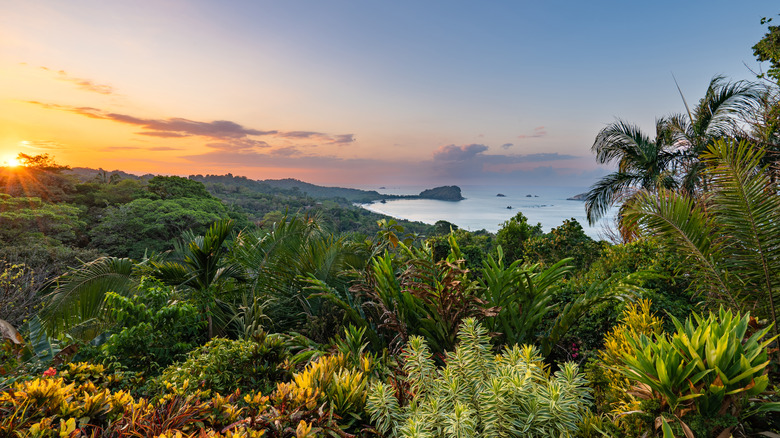
From beachside sunsets to fresh coffee on a crisp morning beneath Arenal Volcano, there's nothing quite like a Costa Rican vacation. Folks flock to the land of pura vida to escape the bustle of the day-to-day or sometimes for something completely different — sloths. Costa Rica is known for these cuddly-looking critters, so it only makes sense that travelers want to see them during their trip. After all, you see them plastered on practically every kind of gift at the gift shops in Costa Rica. Going sloth spotting is definitely one of the most amazing things to Do in Costa Rica .
What may surprise you is that sloths don't just call Costa Rica home. While the two are synonymous, sloths can be found all over South and Central America. For example, they can be seen in Peru, Honduras, Ecuador, and Colombia. Sadly, their numbers are also falling because they only have babies every three years and are dying faster than they are reproducing. Deforestation is taking a huge toll on the two species of sloth who live in Costa Rica.
Despite that, travelers may be annoyed if they don't see a sloth while they're in Costa Rica. Although these slow-moving mammals aren't spotted as often as squirrel monkeys or coatimundi, you can find them if you know where and how to look.
Understand where the sloths are
While the sights of the capital city of San José may appeal to human visitors, they aren't appreciated by sloths. That's partly why travelers to Costa Rica who hope to simply bump into a sloth while walking around are frustrated that they didn't. There are several reasons for that, but mainly sloths spend 99% of their time hanging out in tree canopies in the rainforest. Sloths only come down once a week to do their business — because they know better than to do it while hanging upside down.
The best way to nearly guarantee seeing a sloth is to travel to wherever they are. That means venturing into the moisture-dense rainforests in areas like La Fortuna, Tortuguero, Monteverde, and Puerto Viejo, to name a few. Many of the sloth-friendly areas are also the best destinations for a little bit of everything in Costa Rica . Manuel Antonio National Park is a particular favorite in addition to local sloth sanctuaries.
Whether or not you see a sloth in Costa Rica also depends on when you visit. Although you can spot them year-round, they do (like many other rainforest dwellers) prefer the rainier times of the year. What is imperfect travel weather for humans is preferred for sloths. Keep in mind, too, that they are also largely nocturnal. So, even though you want to score those full-color photos of these cutie pies, and they're easier to spot when they're sleeping, you probably won't get much of a show during the day.
Better your chances of spotting sloths and get a guide
Even if you're prepped for a Costa Rican adventure with all the knowledge you need, you may still not see a sloth. Your best bet is to hire a guide to accompany you through the rainforest trails. These guides are skilled at wildlife spotting and familiar enough with the areas to know where the sloths usually are.
Unless you get very lucky, any sloths you spot may not appear to the naked eye as more than just a fuzzy (and sometimes mossy) lump in a high-up canopy. So, it's easy to miss them if you aren't with someone who knows. You might even spot a mama and baby sloth snuggling the day away! What could be better for a family vacation in Costa Rica ?
Be sure to ask your guide if they have a telescope, too. These will help you see far-away sloths closer up. They should also be able to help you get some photos through the telescope with your phone or camera, which is also a neat trick. You'd be surprised how few other visitors will hire a guide. When you're walking the trails and seeing annoyed travelers, disappointed they couldn't spot a single sloth in the canopies, you'll be glad you brought an expert.
Recommended

10 Best Resorts in Costa Rica for Your Next Trip
T umbling waterfalls, dense jungles, winding rivers, smoldering volcanoes, and secluded beaches make Costa Rica an idyllic destination for travelers looking to immerse themselves in nature. What's more, over the past few decades, Costa Rica has prioritized protecting its natural beauty in a country that once had some of the world's highest deforestation rates. Today, Costa Rica continues to lead the way on sustainability: Nationwide, it runs on 98 percent renewable energy and is working to decarbonize its economy by 2050.
Sustainable practices have taken hold at the country's best hotels and resorts. These retreats offer travelers unforgettable experiences in protected natural areas, and they go the extra mile to operate responsibly within their environments and communities.
As part of AFAR's Hotels We Love series, we've chosen the 10 best retreats across the country. Whether you prefer a safari-style tented camp with volcano views or a beachfront paradise with decent swells, these Costa Rican retreats deliver sublime experiences in nature while offering something for everyone.
1. Nayara Tented Camp
- Location : Arenal Natura Ecological Park
- Why we love it : A family-friendly, safari-style adventure in Costa Rica
- Loyalty program: Leaders Club (Leading Hotels of the World)
This tented camp in the La Fortuna area couldn't be further from roughing it. The 37 spacious glamping accommodations of Nayara Tented Camp come with private hot-spring-fed pools with views of the active Arenal volcano, king-size beds, massive bathrooms with deep soaking tubs, indoor and outdoor showers, and a personal butler. This newest retreat by Nayara is located on the same 62-acre rewilded estate as sister properties Nayara Gardens (currently being renovated and set to reopen January 2024) and Nayara Springs. The camp offers several multi-bedroom tents that are especially convenient for traveling families.
Activities that appeal to various age groups include naturalist-led bird-watching, frog-spotting walks, and visits to the farmers' market in La Fortuna town and to the wildlife-filled Arenal Hanging Bridges Park. Learn about Nayara's sloth habitat protection efforts through an on-property experience called the Secret Life of Tony the Sloth, where guests learn about a sloth that has called Nayara home for many years. Several sloths live on the property, thanks to the resort's reforestation efforts that planted more than 1,000 cecropia trees, which the mammals depend on for food.
Post-adventure, enjoy one of the resort's six cantilevered hot spring pools in the jungle, dine at the new on-site Mediterranean restaurant Ayala, or visit the treetop spa and yoga platform at Nayara Springs. From $1,221
2. Origins Luxury Lodge by Mantis
- Location : Bijagua
- Why we love it : An off-the-grid rain forest estate
- Loyalty program: Accor Live Limitless
Visitors are drawn to the quiet town of Bijagua for access to Tenorio National Park, home to the active Tenorio volcano, the Rio Celeste waterfall, and resident wildlife, including tapirs, howler monkeys, and sloths. Here, the Origins Luxury Lodge by Mantis , which sits along a hill in an adjacent 111-acre rain forest estate, offers a stay that is both luxurious and eco-conscious. The resort, reachable via private heliport or a roughly two-hour drive past small villages, consists of six circular one-bedroom luxury lodges and one three-bedroom treetop villa. Accommodations blend into the landscape, thanks to green roofs and natural materials like wood, bamboo, adobe, and stone. Each lodge has its own private hot tub, canopy bed, and an indoor-outdoor shower.
Guests will notice other eco-friendly initiatives: You won't find single-use plastic anywhere, and the large on-site organic garden and 25 beehives supply ingredients to the spa and restaurant. Meanwhile, fragrant organic bath products are made with wild ylang-ylang growing on the property. Behind the scenes, the hotel operates its own composting stations, solar water tanks, and a treatment plant for soapy water that's reused for watering plants. One of the highlights of a stay here is a naturalist-led walk on the wildlife-rich property-keep your eyes peeled for tree frogs and toucans. From $1,175
3. Kurá Boutique Hotel
- Location : Uvita
- Why we love it: A romantic getaway in the green Osa Peninsula
This adults-only, eight-suite retreat on the Pacific Coast north of the Osa Peninsula is owned by a Costa Rican architect and biologist who envisioned a hospitality experience that's both stylish and sustainable. The furnishings are made from responsibly sourced teak wood, and you won't see any single-use plastic. The resort sits on a hillside overlooking Marino Ballena National Park and its famous Whale's Tail sandbar, where migrating humpback whales can often be spotted. Accommodations feature floor-to-ceiling windows and two-person hammocks on open-air verandas (the Master Suite has a private pool).
Kurá's most alluring attraction, aside from its beach-meets-rain forest setting, is its infinity pool, complete with an underwater sound system. It's surrounded by a bar and restaurant serving ingredients sourced nearby, like seafood and grass-fed meat from local farmers. Some produce is grown in the property's organic greenhouse, and the resort composts all food waste on site. Off property, the hotel offers a complimentary shuttle to the village of Uvita and the whale coast, and it can arrange for waterfall hikes, paddleboarding and snorkeling, and horseback riding. From $880
4. Hacienda AltaGracia, Auberge Resorts Collection
- Location : Pérez Zeledón, Nicoya Peninsula
- Why we love it : An idyllic escape for wellness seekers
The soothing views of the green Talamanca Mountains from the private plunge pools and terraces of Hacienda AltaGracia 's 50 one- and two-bedroom casitas feel like a wellness experience unto themselves. That's not surprising, given that nature-based wellness is the focus of the 180-acre property. It might be experienced via freshly squeezed juice or coffee with ingredients from the resort's farm. Or selecting a horse from the stables and riding through the green hills nearby. Or climbing to the top of the rain forest canopy by rope.
Hacienda AltaGracia also features a 20,000-square-foot outpost of the Well, an integrated wellness center and spa with a flagship in New York City that offers holistic health treatments and consultations. Spend time in the hydrotherapy tub, heated tepidarium, and healing garden, or take part in an outdoor movement class like aerial yoga or qigong. The Well hosts multi-day retreats around various topics, usually led by a visiting expert. Classes have included journaling with Laura Rubin of creative journaling company AllSwell and breathwork with Nicholas Pratley, a neuro-linguistic therapist. Off property, the resort can arrange a visit to an Indigenous Boruca village or a rafting trip on the Pacuare River. Not to be missed: A meeting with a local family for a glimpse at life on their farm in the Nicoya Peninsula, one of the world's five Blue Zones-where people are healthiest and live the longest. From $2,225
5. Four Seasons Resort Costa Rica at Peninsula Papagayo
- Location : Peninsula Papagayo
- Why we love it : Top-notch service on the beach, with accommodations ideal for multi-generational groups
Located on the Pacific coast, in the northwest corner of Guanacaste Province, the 1,400-acre Peninsula Papagayo is easy to access: It's only an hour's drive from Liberia Guanacaste airport. And when it comes to lodgings, the Four Seasons Resort Peninsula Papagayo is the peninsula's crown jewel-plus, it reopened in November 2023 after a refresh. The 182 enormous rooms, suites, and private residences are equipped with contemporary furnishings in natural hues, while floor-to-ceiling windows let in ample light. Guests can relax by any of four pools or in a cabana on the beach at the new Virador Beach Club, which features a restaurant and lounge, infinity-edge pool, and private cabanas, all set against the scenic coastline.
Younger children have access to the Kids for All Seasons club, recently renovated to reflect the area's flora and fauna, while teens can check out the Tuanis Teen Center-a rarity in the resort world with a basketball court and social spaces for meeting new friends. Other family-friendly on-site pursuits include surfing lessons with the resort's women-run SurfX surf school and golfing on the 18-hole Arnold Palmer–designed course, which recently updated several features, including a precision irrigation system that reduces water use by 20 percent, a larger teeing area with 12 acres of native vegetation, and a new golf pro and tennis retail shop. The spa added a new Wellness Shala, an indoor-outdoor structure inspired by the Guanacaste winds, that hosts yoga, meditation, and other health workshops.
Head off property on a rain forest excursion to spot the three local monkey species, traverse the swinging bridges, rope obstacles, and zip lines of the nearby Palmares aerial park, hit the water on a water bike or paddle through a mangrove forest, or go off-roading on a UTV around the Palmares estuary. Guests can also join a coral restoration project where they help clean, catalog, and restore the area's fragile coral reefs. From $1,440
6. Finca Rosa Blanca
- Location : Central Valley
- Why we love it: A retreat built for coffee and food obsessives and travelers who want a dose of farm life
Costa Rica is famous for its high-quality coffee beans from eight different growing regions, which produce only 100 percent Arabica. And for a glimpse at the growers of these coveted beans, Finca Rosa Blanca is the place to stay. Located in the highlands an hour's drive outside of the capital city of San Jose, this family-owned coffee plantation practices sustainable, organic agriculture. The inn occupies a building that was the family's original home in 1974, and today the interiors celebrate local art and culture as much as coffee and food. The 14 individually designed suites feature hand-painted murals by Oscar Salazar, a local artist. Accommodations also feature free-form hot tubs, wooden furnishings crafted locally, and of course, all the coffee you can drink-much of it grown on site.
The hotel's farm-to-table restaurant serves such dishes as coconut milk soup with root vegetables and braised beef tenderloin with stewed plantains. Ingredients often come from the property's fruit orchards and organic vegetable and herb greenhouse. The organic coffee tour and cupping is a must: Guests can learn all about coffee making from plant and fermentation to roasting and drinking. When not caffeinating, linger by the chemical-free infinity pool, surrounded by a garden filled with orchids, bromeliads, and palms and has views of Costa Rica's green Central Valley and its two active volcanoes. From $499
7. Lapa Rios Lodge
- Location : Osa Peninsula
- Why we love it : An ideal base for active travelers seeking both ocean and rain forest
Lapa Rios Lodge offers both rain forest and ocean adventures in one of the last remaining coastal lowland tropical rain forests in Central America. The luxury lodge on the wild Osa Peninsula is adjacent to biodiverse Corcovado National Park, and it has preserved more than 1,000 acres of rain forest since it opened 1993. The 17 bungalows feature hardwood floors and large private verandas with their own plunge pools. Guest activities include volunteer work to help restore Golfo Dulce's coral reefs, bird-watching walks where macaw and toucan sightings are common, and waterfall hikes.
Sustainability tours offer a behind-the-scenes look at the renewable building materials used to construct the lodge, as well as a tutorial on how the 240 solar panels, 10 water turbines, and 48 energy storage units provide renewable energy and purified water. Guests also visit the lodge's organic gardens and pig pens, where food waste from the restaurant feeds the resident pigs.
Much of the food grown in the gardens end up on the menu at Brisa Azul Restaurant, which offers a menu with entirely plant-based dishes and another featuring sustainably sourced meat, dairy, and seafood. From $1,350
- Location : Santa Teresa, Nicoya Peninsula
- Why we love it : A sustainable retreat in a UNESCO-designated Blue Zone
The Nicoya Peninsula is one of UNESCO's five Blue Zones, designated areas around the world where people live the longest and are healthiest. It's where travelers will find Nantipa , a boutique hotel that's shaded by trees and faces an idyllic beach. The hotel is composed of 19 suites and bungalows. The two new beachfront villas have three bedrooms, kitchens, and indoor-outdoor living areas with private pools.
Nantipa is home to the Numú Wellness Center, where guests can take part in various healing and fitness classes and workshops like sound healing, life coaching sessions, and Ayurvedic therapy. Meanwhile, Manzú Restaurant, right on the beach, serves dishes with both international and Caribbean influences.
When not at the pool or on the beach, guests can go on excursions, including rain forest hikes, surfing lessons, horseback riding, fishing trips, and a boat tour to Tortuga Island to spot marine wildlife. In February 2023, the hotel was awarded a Certification for Sustainable Tourism by the Costa Rican Tourism Institute, thanks to such policies as the omission of single-use plastics, gray water irrigation, and solar-heated water. From $350
9. Casa Chameleon
- Location : Las Catalinas
- Why we love it : A nature escape for gourmands
- Loyalty program: Always Be Expected (Relais & Châteaux)
As a recent inductee into the culinary-focused Relais & Châteaux hotel collection in 2023, Casa Chameleon is recognized for its commitment to sustainability, personalized service, and exceptional cuisine. Set on a hill overlooking Las Catalinas, a coastal town north of Tamarindo, the hotel features panoramic views of the Pacific Ocean. The 21 contemporary-feeling private villas each feature an infinity-edge saltwater plunge pool.
The culinary options here are truly impressive. Casa Chameleon's Sentido Norte Restaurant showcases Costa Rica's food heritage and flavors in an open-air setting with uninterrupted ocean views. Grotto 12 is the newest restaurant, offering a selection of global wines in a wine cave with only 12 seats. The Green House is an intimate dining spot that celebrates Costa Rican cuisine with dishes made from ingredients grown on site. Meanwhile, La Pampa Grill features slow-cooked sea- and farm-to-table feasts, including fall-off-the-bone ribs prepared on the open-fire barbecue. From $1,160
10. El Silencio Lodge & Spa
- Location : Bajos del Toro
- Why we love it : People looking to immerse themselves in Costa Rican culture
El Silencio Lodge is set within a 500-acre cloud forest reserve on the slopes of Poás Volcano, about halfway between La Fortuna and San Jose; a gurgling creek runs through the grounds. The retreat's 16 spacious suites and villas are heated by gas fireplaces and face the nearby Poás Volcano, the largest active volcano in Costa Rica. The on-site Esencia Spa is a true sanctuary, with open-air treatment bungalows, a yoga deck, and the Conical Room, designed to channel the Costa Rican cloud forest's essential energy. The spa offers treatments that highlight local ingredients, like a chocolate massage, a volcanic clay wrap, and a fruit flake facial.
A private trail leads to the property's three waterfalls, paths for horseback riding and mountain biking, and an adventure park for ziplining and rappelling. The resort also offers cooking and mixology classes, bird-watching and night frog walks, coffee and wine tastings, tree planting, and traditional oxcart painting classes. After a long day, guests can drink and dine at Las Ventanas Restaurant and Toro Bohemio Bar, which use vegetables and herbs from El Silencio's 5,000-square-foot organic greenhouse, fresh eggs from resident free-range chickens, and trout from on-site ponds, where guests can even fish for their main course. From $540
This article originally appeared online in 2020; it was most recently updated on December 14, 2023.
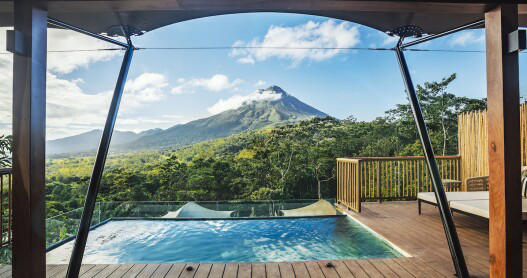
- Skip to primary navigation
- Skip to main content
- Skip to primary sidebar
- Skip to footer

Costa Rica Travel Information
What is Costa Rica Like in January?
April 16, 2024 By Sammi Leave a Comment
January is a fantastic time to visit Costa Rica as Christmas crowds have disappeared, everything is drying up and high season is in full swing. In this post, you’ll learn what January in Costa Rica is like and why it’s a wonderful time to see Costa Rica.
If you’re looking to save some $$ on your trip, check out our Mytanfeet deals page! We partnered with a rental car company, hotels and tour operators to give discounts exclusively for our readers. Click here to enter our deals page.
Costa Rica Quick Facts
- Sunrise and sunset is roughly the same all year round, with a difference of around 15 minutes. Sunrise is generally 6 AM and sunset is 530 PM, dark by 6 PM.
- Costa Rica uses 110 V and drives on the right hand side of the road.
- Local currency is called the colón. Exchange rate ~500 CRC to 1 USD.
- Spanish is the main language.
- Costa Rica is 8-12 degrees from the equator.
January in Costa Rica Weather
First and foremost, the weather . Average day time and night time temperatures do not vary greatly throughout the year in Costa Rica, so temperatures in January won’t be drastically different the rest of the months.
Costa Rica experiences two tropical seasons: dry and rainy. Dry season is generally December through April, rainy is generally May through November. January is the second month of dry season so most of the country is drying up with high temperatures, sunny blue skies and minimal rain.
Since the first month of dry season, December, is more like a transition month, dry season really starts picking up in January and is truly the first dry month in Costa Rica. In January, the northern winds come in, giving a nice, continuous breeze.
Below are short descriptions of weather in January for popular tourist destinations in Costa Rica.
Guanacaste and Nicoya Peninsula
Dry tropical areas such as the Guanacaste coast ( La Cruz , Papagayo Peninsula , Tamarindo , Samara , Nosara ) and Nicoya Peninsula ( Montezuma , Tambor, Santa Teresa ) will see their last hard rains around end of November/beginning of December so don’t expect any rain in January.
By end of January, dry forest covered mountains start turning yellow and bare and humidity levels decrease greatly. Sun is out bright and strong during the day with constant winds, evenings are warm and sultry.

Average day time temperatures are 95 degrees Fahrenheit (35°Celsius) and average night time temperatures are 78 degrees Fahrenheit (26° Celsius).
If you visit the higher elevation areas in the Guanacaste province such as Tilaran, Mirvalles , Nuevo Arenal and around the Bijagua areas, they may still see some rain.
Central Valley
The GAM ( San Jose, Alajuela, Heredia and Cartago ) has lovely weather in January with warm sunny days, fresh air, constant breezes and cozy nights. Average day time temperatures are 80° F (27° C) and average night time temperatures are 65° F (18° C). If you’re up in the high mountains of the Central Valley, expect much cooler temperatures.
La Fortuna sits in the Northern Lowlands, part of the tropical rainforest which has the possibility to still rain randomly. It could be intermittent sprinkles or ten minute downpours in the late afternoons and evenings.

Average day time temperatures are 85 degrees Fahrenheit (29° Celsius) and average night time temperatures are 72° Fahrenheit (22° Celsius). Humidity levels are around 60%.
Jaco, Manuel Antonio
Jaco and Manuel Antonio weather is similar to La Fortuna as this area is also tropical rainforest. The coast does tend to be a tad hotter, so daytime is more around 88° F (31° C) but humidity level are very similar. If it rains, it will be most likely at night and for short bursts. Humidity levels around 60%.
Costa Ballena and Osa Peninsula
These areas, Costa Ballena ( Dominical , Uvita and Ojochal) and Osa Peninsula ( Drake Bay , Matapalo, Carate and Puerto Jimenez) are tropical rainforest areas, so there are possibilities of intermittent rain in January still. Average day time temperatures are 90° F (32° C) and average night time temperatures are 80° F (27° C). Humidity levels around 60%.
Monteverde , the mountain town in the Tilaran Mountain Range experiences high winds, intermittent sprinkles, fresh crisp air and comfortable nights in January. It can still sprinkle but generally for short periods of time and then the bright rainbows come out (hence the nickname, town of rainbows). Average day time temperatures are 72° Fahrenheit (22° Celsius) and average night time temperatures are 60° Fahreinehit (16 C). Low humidity.
Caribbean (Tortuguero, Limon and Puerto Viejo)
The Caribbean coast ( Puerto Viejo de Talamanca , Limon and Tortuguero ) tends to follow a different weather pattern than the rest of Costa Rica. January can still have some days of hard rain, so you may run into storms and wet days. Average day time temperatures are 90° F (32° F) and average night time temperatures are 75° F (24° C). Humidity levels around 60%.
Prices in January in Costa Rica
As January is the start of the normal high tourism season, prices are high but not as high as peak season. Peak season is the week of Christmas and New Years, where hotel nights on December 24-31st are easily twice as much as normal times and can have a 3 night minimum. But after the first few days of January, prices go back down to normal high season prices.
Airfare usually goes down after the first week of January. I have found relatively cheap flights from Seattle to Costa Rica mid to end of January (~$500 USD basic economy).
Crowds in January in Costa Rica
The first week of January is generally still very busy due to lingering Christmas and New Years crowds. By the second week of January, it will have gone back to normal high season crowds.
January is the second month of the Costa Rica schools’ summer vacation so there will be lots of families on vacation. Weekends are generally very busy at popular national parks and beaches, with local families enjoying their days off. Purchase your national park tickets early if required, such as Tenorio Volcano National Park and Manuel Antonio National Park.
Best Things to Do in January in Costa Rica
January is a great month to experience all Costa Rica has to offer in terms of culture, nature, adventure and wildlife. Here are some of the best things to do in January in Costa Rica.
The surf in January is fairly consistent. The Pacific Northwest coast (Guanacaste) picks up NW swells so beaches like Tamarindo , Playa Langosta , Playa Grande, Playa Negra and Playa Avellanas have days where the waves are firing. The famous Witch’s Rock (Roca Bruja) can have good waves when there is a north swell, otherwise it’s generally small in January. For the highly experienced, big wave chaser, the Caribbean coast spot Salsa Brava can boast some of the heaviest barrels and reef breaks.

Water temperature is nice and warm, in the high 70s to low 80s F ( 25-28°C).
If you’re not into surfing, no worries! Try to visit many beaches as it’s one of the best things to do in January in Costa Rica. Take a walk, watch the sunset, play in the waters, boogie board and get your tan on (safely, because the sun is strong so make sure to apply and reapply reef safe sunscreen).
January is a great time to visit national parks and private reserves for a hike or two thanks to the drier weather. Landscapes are still somewhat green in dry tropical forests from the last rains so it doesn’t look too arid and desert like.
Great options are Rincon de la Vieja National Park , Barra Honda National Park , Carara National Park , Manuel Antonio National Park and Corcovado National Park . Make sure to bring good sun protection like a hat, sunglasses and sunscreen, mosquito repellent and an insulated water bottle to have cold water.
White Water Rafting
As rivers will still be full from the rainy season, white water rafting is very good in January. Raft down pristine rivers like Pacuare River Class 3, 4 and 4+ rapids, Sarapiqui River Class 3 and 4, Savegre River Class 2 and 3 and Tenorio River Class 3 and 4.
January is the start and end of several wildlife seasons in Costa Rica. First, January is a bit after the start of the Northern Hemisphere humpback whale season in Costa Rica. If you’re in the Central or South Pacific, you can take a whale watching tour from Uvita for good chances to see humpback whales and dolphins.
Second, January is the end of the arribadas , or mass nesting of Olive Ridley sea turtles on Playa Ostional in Ostional Wildlife Refuge . The arribada in January has diminished considerably compared to the previous months, but there are still chances to see nesting mothers and baby turtles hatching. For leatherback turtles, January is the start of their nesting season in Marino Las Baulas National Park (sadly their numbers have decreased greatly and it’s not super common to see them anymore).
Water clarity in January greatly improves due to the disappearance of torrential rains, run off and storms. Snorkeling and scuba diving are great, with an abundance of colorful tropical fish and other marine life like turtles, rays and sharks to be seen. Snorkeling at Tortuga Island , Isla Caño Reserve , Gulf of Papagayo and Catalinas Islands are wonderful.

As January is winter up north, the migrating birds will be in Costa Rica. It’s a fantastic time to see these million mile fliers as well as other river birds. Caño Negro Wildlife Refuge and Palo Verde National Park are two excellent places for safari boat rides to see birds and other wildlife.
Interested in booking tours like the Ca ñ o Negro Wildlife Refuge, Tortuga Island cruise or other activities? Check out our Costa Rica deals and discounts to save some $$ on your excursions.
Local Festivals and Parties
Costa Ricans like to party and they do by throwing fiestas civicas which are the local parties. Nearly all towns, especially in rural areas, have local parties and it’s a really fun way to immerse yourself into Costa Rican culture.
Local parties normally have the typical party activities: street food, rides and games. Costa Rican local parties also have bull riding. They do not partake in bullfights like Mexico or Spain, rather they let a bull loose in a stadium and everyone runs around from it. They’ll do gimmicks like tying money to the bull horns and everyone will try to grab it. They also do bull riding and they’ll have competitions.
Another aspect of local parties are the topes which are the horse parades. This is very common in the Guanacaste province as this is the land of the Costa Rican cowboys. Hundreds of local dress up in cowboy flair and parade around their best horses. To cool off during the hot day, they drink lots of ice cold Costa Rican beer.
Notable Festivals and Days in January in Costa Rica
New Years Day: Generally outside with family, enjoying the last days before going back to work. Or nursing the hangover from the countdown the night before.
Palmares: The local parties of the town of Palmares are famous and are the biggest in the country, attracting nearly 1 million visitors (out of a total country population of 5.2 million). They happen every second Friday in January for around 10 days.
Santa Cruz: Known as the town of folklore, local parties in Santa Cruz get more popular year after year. You’ll see the proud Guanacasteco cowboys of all ages braving the bulls, showing off their steeds and throwing back Chiliguaro shots like there’s no tomorrow.
Alajuelita January 15: This religious festival pays homage to the Black Christ of Esquipulas. This pilgrimage is very important to dedicated Catholics as Catholicism is the main religion of Costa Rica.
Other Things to Know About January in Costa Rica
- Road conditions are usually not great during this month after they have suffered through several months of rain and storms. Although some remote/rural places may only need a sedan or high clearance car in dry season, check with your host if a 4wd will be required/recommended instead due to the worsened road condition. Check our renting a car in Costa Rica tips and get our Costa Rica car rental discount here!
- Waterfalls are still very full so it’s a great time to do a waterfall tour. However, some places in the tropical rainforest that may still rain in January, may still have lots of run off and be a murky brown color. For example, Rio Celeste Waterfall in Tenorio Volcano National Park may be more green/brown than the beautiful sky blue color if it has been raining as that area can still rain in January.
- It is generally quite windy in January so it may not be the best time for a catamaran or sailing tour if you are prone to seasickness. Afternoons are normally windier than mornings. If it is too windy, activities like ziplining may be cancelled due to safety concerns.
- January is not the cheapest time to travel in Costa Rica but it is the most lively. Everything is open, everyone is excited for the high tourism season once more and it is easy to find tours to join if you’re a solo traveler.
January is excellent time to visit Costa Rica for fun, festivities, adventure, relaxation and an escape from the start of the Northern Hemisphere winters. Soak up all the sun in Costa Rica you need to make it through the rest of the winter days back home.
What to Pack for Your January Vacation in Costa Rica
Essentials: Valid passport, valid drivers license if you plan to rent a car, credit card with no foreign transaction fee, travel insurance , medicines
Must brings: Sunscreen (SPF 30 and higher), after sun gel, mosquito repellent, insulated water bottle, microfiber towel, reusable shopping bags, hair ties, swimsuits, sandals, sunglasses, hat, small first aid kit, light weight water proof rain jacket if visiting rain forest areas, dry fast, sweat wicking clothes and closed toed shoes for activities.
Get our full Costa Rica packing list here.
Itineraries
Ready to plan your trip to Costa Rica in January? Check out our recommended itineraries which will be great for January!
8 Days Itinerary: Playas del Coco and La Fortuna. Fly in/out of LIR Airport.
Tamarindo 5 Days
11 Days Itinerary : La Fortuna, Monteverde and Manuel Antonio
14 Days Itinerary : La Fortuna, Monteverde, Santa Teresa and Playas del Coco
Other Months
Click the links below to see what Costa Rica in other months are like.
Costa Rica Vacation Checklist
- First time to Costa Rica? Read our First Time in Costa Rica guide.
- Not sure how to move around Costa Rica? Read our How to Get Around Costa Rica guide to find the best transportation method for you.
- Click the link to get our detailed Costa Rica Packing List so you know what essential items to bring.
- Do not forget to purchase Travel Insurance for your trip to Costa Rica.
- Stay connected by purchasing a prepaid SIM Card in Costa Rica. Get 10% off your Airalo eSIM package with our promo code “mytanfeet”
- Save money with Mytanfeet Deals for tours and hotels. Save more money with our Costa Rica Car Rental Discount.
Join our mailing list and get our free Costa Rica eBook!
Reader Interactions
Leave a reply cancel reply.
Your email address will not be published. Required fields are marked *
Exclusive deals

COMMENTS
Written by Nikki Solano. Nikki is the CEO of Pura Vida! eh?Inc. (Costa Rica Discounts), and the author of the guidebooks Moon Costa Rica (2019, 2021, 2023, and 2025 editions) and Moon Best of Costa Rica (2022 edition) from Moon Travel Guides.Together with her Costa Rican husband, Ricky, she operates the Costa Rica Travel Blog, created the online community DIY Costa Rica, built the Costa Rica ...
Another great place on Costa Rica's Caribbean coast to see sloths in Costa Rica is in Cahuita National Park. Best known for the 18th century shipwreck in its waters, the national park protects both land and sea. Plus, along with a myriad of flora and fauna, Cahuita is home to brown-throated and Hoffmann's sloths. ...
Sloths are plentiful throughout Costa Rica but may be difficult to spot to the untrained eye. A professional naturalist guide can help point them out. As a general rule, the further south you go along the Pacific coast, the more likely you are to see wildlife as the concentrations are higher.
Sloth Sanctuary of Costa Rica. The Sloth Sanctuary of Costa Rica sits on the Caribbean coast 20 miles/32 km north of the Jaguar Rescue Center. This is one of the best places to visit if seeing sloths is your focus. You will meet some of the 150+ injured, orphaned, and abandoned sloths that call this sanctuary home.
Manuel Antonio National Park, along the Pacific coast, is a biodiversity hotspot thanks to its densely packed rainforest, making it one of the best places to spot sloths in Costa Rica. Guests can ...
Sloth in Rescue Centre in San Jose. Here are some popular reserves and rescue centers where you can see a sloth in Costa Rica: Sloth Sanctuary of Costa Rica (near Cahuita, Limón ): Founded in 1992, this is Costa Rica's original sloth sanctuary. Toucan Rescue Ranch (near San Isidro, Heredia ): Just north of San José, Toucan Rescue Ranch is ...
Among the most renowned are the Sloth Sanctuary of Costa Rica, near Cahuita on the Caribbean coast, and the Toucan Rescue Ranch in San Josecito. These centers are dedicated to the rescue, rehabilitation, and, when possible, the release of sloths back into the wild. They provide vital medical care for injured and orphaned sloths, along with a ...
You can visit one of the most beautiful beaches of Costa Rica in order to see sloths. Located in the Central Pacific, Manuel Antonio beach is an excellent spot for sloths. Here you can find both types of sloths. Monteverde Cloud Forest is a place that boasts 2.5% of the world's biodiversity … just imagine it!
Manuel Antonio. The Manuel Antonio National Park is a great place to see TONS of wildlife including sloths. They are typically high up in the trees relaxing. You can just show up at the park and hire a guide, but if you would like a tour with transportation we highly suggest an all inclusive tour with Manuel .
4. Sarapiqui. Located in the Heredia Province, Sarapiqui is a lesser-known gem for sloth sightings. Its lush rainforests offer an excellent chance to observe sloths in their natural habitat. Guided hikes or boat tours along the Sarapiqui River reveal the area's rich biodiversity, including its sloth population.
Keep reading to learn more about the best places to spot sloths in Costa Rica: 1. Caribbean Coast. The Caribbean coast is better for viewing sloths. The Pacific coast is drier, which sloths don't prefer, except for the Osa Peninsula on the southern end of the Pacific Coast, which is popular among these animals. 2.
From San José and Costa Rica's Pacific Coast: Sansa Airlines to Limon (2 flights a day from San José) From Liberia, Costa Rica: Nature ... Ask driver to stop at Aviarios del Caribe/Sloth Sanctuary. See large yellow sloth crossing sign at the bus stop near front gate. EasyRide Costa Rica: Shuttles & Private transport options to/from Puerto ...
The best places to see sloths in Costa Rica are Manuel Antonio, Osa Peninsula, La Fortuna, Caño Negro (Northern Plains), Tortuguero, Puerto Viejo, Cahuita, Dominical, Uvita, Ojochal, Monteverde and Bijagua. These are all year round tropical rainforest areas so both sloths are found in these areas and always have food.
How to See Sloths in Costa Rica. Sloths are found all over Costa Rica, but the country's well-run national parks are the best places to see sloths in a truly wild environment. Manuel Antonio National Park on the Pacific Coast is a reliable place to spot both two and three-toed sloths. One of the trails in the park is even called 'Sendero ...
Costa Rica is a mecca for wildlife tourism, and it's #1 most wanted is the Sloth. They will be hanging above your hotels or eating blissfully in the canopies of the national parks. It's also not uncommon to see one crossing the road -- cue all the 'why did the Sloth cross the road' jokes.
Best Places to See Slots in Costa Rica. National Parks. The most rewarding sloth-spotting parks in Costa Rica are undoubtedly Manuel Antonio, Tortuguero, Corcovado and Monteverde. Over on the Caribbean side, La Amistad near Puerto Viejo also usually delivers big on the sloth-spotting goods. All these regions receive a decent amount of rain, all ...
Corcovado National Park. Corcovado National Park, on the Osa Peninsula, is one of the best places to see wild animals in all of Costa Rica. You'll see howler monkeys, tapirs, coatis, whales, and quetzals. That means you can see sloths here too! The very best way to do so is by hiring an experienced guide.
The best time to see sloths in Costa Rica depends on the region you are visiting and the particular species of sloth you hope to encounter. Two-toed sloths are nocturnal, meaning they are most active during the night or twilight hours, while three-toed sloths are Diurnal, sleeping at night and grazing slowly through the day.
Within the mist-veiled foliage, there's a good chance you'll spot some sleepy sloths there. Santa Rosa National Park. Santa Rosa National Park is one of oldest and largest national parks in Costa Rica. It's situated in northwestern Costa Rica, and was once the site of 1856 battle between Americans and Costa Ricans.
The chances are high for a spotting, they are well-protected and you also have the bonus of potentially seeing other species in their habitat. Here are four well-known national parks in Costa Rica from the Caribbean side for seeing sloths in the wild, including the usual important travel logistics. 1. Cahuita National Park.
Puerto Viejo. Famed for being one of the best places for seeing sloths in Costa Rica, Puerto Viejo is home to both species of sloths. Take a trip around the world-renowned sloth sanctuary, where you will gain an insight into the behavior of these iconic residents. Tours operate daily, starting from 8 am.
Fun facts about sloths in Costa Rica. Here, you'll find interesting facts about Costa Rica's sloths: 1. There are two types of sloths in Costa Rica . In Costa Rica, you'll find both two-toed and three-toed sloths. They're pretty different in looks and habits. The two-toed sloths are a bit bigger and like to be active at night. 2.
Southern Pacific. Corcovado National Park is without a doubt the best overall place to see wildlife in the wild. Both species of sloths and all four species of monkeys native to Costa Rica are common in Corcovado and best seen on a day hike or multi-night trek accompanied by a naturalist guide.
Costa Rica is known for these cuddly-looking critters, so it only makes sense that travelers want to see them during their trip. After all, you see them plastered on practically every kind of gift at the gift shops in Costa Rica. Going sloth spotting is definitely one of the most amazing things to Do in Costa Rica.
Why Costa Rica Tops Every Traveler's Bucket List. According to the Costa Rican Tourism Board, over 1.7 million international tourists flocked to this Central American gem in 2019.
Sloths are an integral part of Costa Rica. You see their likeness everywhere, even if you don't actually see them everywhere. One way you can more easily spot these incredible creatures is by ...
The turquoise river has become a picture-perfect symbol of Costa Rica, and you absolutely must take a river tube to see it. The water looks photoshopped, and the lush foliage rains down on those ...
Rising 12,536 feet, it's the tallest mountain in Costa Rica. The mountain is within Chirripó National Park and is a hidden gem that still flies under the tourist radar. You don't have to be a ...
Costa Rica is famous for its high-quality coffee beans from eight different growing regions, which produce only 100 percent Arabica. And for a glimpse at the growers of these coveted beans, Finca ...
Best Things to Do in January in Costa Rica. January is a great month to experience all Costa Rica has to offer in terms of culture, nature, adventure and wildlife. Here are some of the best things to do in January in Costa Rica. Surfing. The surf in January is fairly consistent.